![]()
![]()
![]()
Group & Last Name Index to Full History:
A B C D E F G H I J K L M N O P Q R S T U V W X Y Z
Composers are listed chronologically. Tracks are listed alphabetically.
Find on Page = F3. Not on this page? See history tree below.
Alphabetical
Chronological
Featured on this page in order of the composer's birth date.
| The roots of Baroque reach back
to late Renaissance composers, such as the development of monody by such as
Giulio Caccini in association with the Florentine Camerata, a group of
humanist intellectuals, about the cusp of the 16th century.
The term "baroque" is derived of "barocco" meaning a pearl of irregular
shape in Portuguese. This page is structured differently from the other
YouTube histories. Due that specific dates are largely impossible with early
classical music we keep the convention of indexing songs by alphabetical
order only. That is, they are not in chronological order. Dates are noted by
appendage and refer the year of publication if not composition. As for
brackets (: [Part 1]), they indicate sections made by YouTube channels.
If the composer you're seeking isn't on this page he may be in
Renaissance or
Classical. Several late
Baroque composers are in Classical if they
bridged at all. As "baroque" suggests, things begin to get a little
complicated during that period in a literal number of ways, that is, per
cataloguing systems [1,
2,
3,
4,
5,
6],
particularly thematic, as chronological is for a large part simply not
possible [see also
1,
2].
Which brings us to
opus numbers, the practice beginning circa 1600 perhaps as an
alternative to incipits (the titling of songs by their first few words). As
both publishers and composers themselves began to assign op numbers for
various purposes, the practice led to such confusion that cataloguing
systems became requisite to clarity some sort of sequence and establish
universally agreeable standards. As for baroque composers, a good companion
to this section is 'Greene's Biographical Encyclopedia of Composers' by
David Mason Greene & Constance Green (Doubleday 1985):
1,
2. See also:
baroque.org;
operabaroque; 'A
History of Baroque Music' by George Buelow (Indiana U Press 2004)
*; 'Musical Authorship from Schütz to Bach' by Stephen Rose (Cambridge U
Press 2019)
*; 'Baroque Music' by Peter Walls (Routledge 2017)
*. See also Stanford University's list of
opera composers and
Opera Glass.
As the history of classical music is largely European until its later
arrival to the United States in the 19th century, helpful in the use of this
account may be chronological maps of Europe and its monarchs mentioned
throughout [1,
2,
3,
4].
The earliest major European temporal power to which this history refers
throughout is the Roman Catholic Church and the
Papal
States. Much of the history of Europe is likewise that of the Holy Roman
Empire (HRE) from the 9th to the 19th centuries [1,
2,
3;
HMEA].
France
was a major player alongside the Church in medieval music prior to the
Renaissance and became the major European check to the HRE.
Venice didn't acquire a lot of territory but became a major cultural
center during the Renaissance alike
Italy
of which it became a part in 1866. Other European nations important to these
histories include in alphabetical order
Austria, England [GB UK:
1,
2],
Germany, Poland [1,
2],
Prussia [1,
2],
Russia
and
Spain.
Also much affecting European music was northern Europe or, Scandinavia [1,
2,
3],
particularly as an adversarial check to Russia. Quick dates for monarchs and
popes:
1,
2,
3,
4.
See also America [1,
2].
|
||
| Born 8 Oct in 1551 in Italy,
Giulio Caccini
was the elder brother of sculptor, Giovanni Caccini, and father to Baroque
composer,
Francesca Caccini. The Baroque period [1,
2]
is generally considered to commence in 1600 AD to stretch well beyond 100
years into 18th century. This history begins the Baroque with Giulio Caccini
per his later publication of 'Le Nuove Musiche' ('The New Music') in 1602 [1,
2,
3,
4,
5,
6,
7,
8]. Containing 12 madrigals and 10 arias, the notable 'Le Nuove Musiche'
presented some of the earliest examples of Baroque composition. Giulio had
studied lute, viol and harp as a child in Rome. Some time during the sixties
Grand Duke Francesco de' Medici brought him to Florence to study music
there. Thought to have begun composing about 1570, by 1579 he was employed
as a tenor vocalist at the Medici court. During Caccini's years with the
Medici family he became involved with the Florentine Camerata [1,
2], a group of humanists, intellectuals, musicians and poets who oft met
at the home of Count Giovanni de' Bardi. Another important member of that
sphere was Caccini's older contemporary in Florence,
Vincenzo Galilei, father to
the astronomer, Galileo [*]
the latter born when Caccini was 12 years old in 1564. Such the setting in
which Caccini became a teacher in great demand during the eighties. Caccini
spent his entire career in Florence with the exception of one brief trip to
Rome as secretary for the Count in 1592 (following the death of
Galilei
in '91). Caccini then discovered that his own music was not disliked there,
though Rome belonged to
Palestrina at the time. Nor did Caccini's music spread throughout Europe
as well as
Palestrina's. Florence, however, was Caccini's ground w the Florentine
Camerata his greater circle. Among the principle concerns of the Florentine
Camerata were ancient Greek drama and music. Another member of that group
was the slightly younger contemporary of Caccini's,
Jacopo Peri, generally credited
with having written the first opera, 'Dafne', in 1597. Three days
after Peri premiered 'Euridice' on 6 October 1600 in Florence, Caccini's 'Il
rapimento di Cefalo' ('The Abduction of Cephalus') was performed on 9
October 1600 before 3800 guests at the wedding of King Henri IV of France
and Marie de' Medeci, that in Florence as well. Most of that opera is lost.
Be as may, after publishing 'Le Nuove Musiche' mentioned above in July of
1602, Caccini staged his own version of 'Euridice' at the Pitti Palace in
Florence on 5 December 1602. In 1614 he published 'Nuove Musiche e Nuova
Maniera di Scriverle'[1,
2], another book of madrigals containing 36 songs. Caccini died
on 10 Dec 1618. As indicated, among his main contributions to the wane of
the Renaissance and early cusp of the Baroque [1,
2]
was music theory, such as the development of monody in association with the
Florentine Camerata exemplified in 'Le Nuove Musiche' below. Though Caccini
died just as the Baroque was beginning to leaf, the period itself would
extend another hundred years into the eighteenth century. References: 1,
2,
3.
Compositions: 1,
2.
Scores. Recordings of: 1,
2,
3,
4.
IA.
Bibliography: 'Giulio Caccini' by Alfred Ehrichs (Druck Von Hesse & Becker 1908) *.
Other profiles: 1,
2,
3,
4,
5,
6. Dates below refer to year of publication if not composition. Giulio Caccini Amor ch'attendi 1614 Lute: Chitarra Barocca Soprano: Montserrat Figueras Ave Maria Istanbul State Opera Chamber Choir Kevork Tavityan More likely composed by Vladimir Vavilov c 1970 Wrongly ascribed to Caccini Euridice 1602 Opera Concerto Italiano Rinaldo Alessandrini Chi mi confort'ahime, chi piu consolami 1600 Opera From: 'Il rapimento di Cefalo' Le Nuove Musiche: Amarilli, Mia Bella 1602 Therobo: Fred Jacobs Soprano: Johanette Zomer Le Nuove Musiche: Amor, Io Parto 1602 Guitar: Hopkinson Smith Soprano: Montserrat Figueras |
||
|
Born in Venice between 1554 and 1557,
Giovanni Gabrieli
continues the Venetian school into the late
Venetian Renaissance and early Baroque. Though he wrote secular works sacred
music was his main concern. He was nephew to composer,
Andrea
Gabrieli, who may or may not have helped
raised him, though likely mentored him. Albeit unknown, being related to
Andrea may have found him
composing at least as a student by 1570 as a teenager. He later studied with
Orlande de Lassus
in Munich where he remained until about 1579. 1584 found Gabrieli in Venice
where he became lead organist at Saint Mark's Basilica in 1585. He would
remain at Saint Mark's the remainder of his life, as well as at the Church
of Saint Roch where he was also principal organist. Among Gabrieli's more
illustrious accomplishments was his volume of motets, 'Sacrae
Symphoniae' [audio],
published in 1597 and gaining him his hour of power throughout Europe.
'Sacra Symphonia' contained the first two sonatas to which this history
arrives: the 'Sonata pian e forte' Ch. 175
[1,
2,
3]
and 'Sonata octavi toni a 12' Ch. 184 [1,
2,
3].
It is thought the sonata [1,
2,
3,
4]
was first called such in 1561 ("sonare" = Italian for "to sound") to
distinguish an instrumental piece for lute from a cantata, that is, song.
The sonata, however, wouldn't develop into a major vehicle for another
eighty to hundred years via Baroque composers such as
Arcangelo Correlli and
Johann Kuhnau when two kinds of it began
to appear: the sonata da chiesa (church sonata) and the sonata da camera
(chamber sonata). Be as may, the sonata's first treatment in literature
wasn't until 1710, appearing in Brossard's 'Dictionaire de Musique' that
year. As for Gabrieli, about 1606, nine years after publishing 'Sacra
Symphonia', he fell too ill to work, appointing deputies to execute what he
couldn't. He died on 12 August 1612 due to a kidney stone. Among posthumous
publications arrived 'Canzoni e Sonate' [*]
in 1615 containing 'Sonata XVIII' [*].
Also published that year were ''Sonata XXI: Con Tre Violini' Ch. 214 [1,
2]
and 'Sacrae Symphoniae Liber Secundus' [*].
References for Gabrieli:
1,
2.
Compositions:
1,
2,
3,.
Scores.
Recordings of:
1,
2,
3,
4,
5,
6.
Audio:
1,
2,
3.
Bibliography.
Other profiles:
1,
2,
3,
4,
5,
6.
Dates below refer to year of publication if not composition. Giovanni Gabrieli Deus qui beatum Marcum Motet à 10 1597 Ensemble Plus Ultra/Michael Noone In Ecclesiis a 14 1608 Taverner Consort, Choir & Players Andrew Parrott Magnificat a 14 Green Mountain Project Jolle Greenleaf/Scott Metcalfe Magnificat a 33 Gabrieli Players Sacra Symphonia Sonata pian e forte 1597 Ch 175 Bayerische Staatsoper/Zubin Metha |
||
|
Born circa 1560 in Ferrara, Italy,
Ercole Pasquini
is first found in service to Giovanni Battista Aleotti [*],
architect to the Duke of Ferrara [*],
teaching his daughters music in the latter seventies. As dates vary between
sources, data herein is based on a birthdate of circa 1570 for Raffaella
Aleotti [1,
2]
and circa 1574 for Vittoria Aleotti [1,
2,
3,
4,
5], making Pasquini perhaps 18 years old upon discovering four-year old
Vittoria to be especially talented while teaching her older sister,
Raffaella [1,
2]. Pasquini is thought to have been mentored by teacher alike to the
Aleotti girls, Alessandro Milleville [*].
Pasquini may have remained in service to Aleotti throughout the eighties. In
1592 Pasquini acquired employment at the Benedictine church of Santa Maria
in Verona. In 1593 Aleotti published two books of music by his daughters, a
volume of motets by Rafaella and a book of madrigals by Vittoria. Rafaella's
work, thought to be earliest known compositions by a nun to see print,
included two motets by Pasquini along with a dedication to him and
Milleville. That same year Pasquini published his poetic favola (fable) in
five acts, 'I fidi amanti' ('The Faithful Lovers'), toward the marriage the
next year of Don Carlo Gesualdo and his
patroness, Eleonora d'Este [*].
Some time before 1597 he succeeded
Luzzasco Luzzaschi
as organist of the Accademia della Morte in Ferrara, after which he accepted
an appointment as organist at St. Peter's Basilica in Rome. He
simultaneously held a similar position at Santo Spirito in Sassia in 1604.
Pasquini is known to have been residing at a hospital for the mentally
abnormal in 1605. In 1606 Pasquini was fired from his bench at St. Peter's
for unclear cause, though likely due to a mental condition described in no
greater detail then "crazy" in so many words. He was apparently rehired
until an incident in May 1608 - leaving his organ to approach and speak to
the Pope - got him dismissed for good. He was replaced by Alessandro
Costantini from June through October, succeeded by
Girolamo Frescobaldi
after that [1605-08 *]. Biological record of Pasquini disappears henceforth, though he may
have lived to as late as 1619. His last composition, 'Jesu decus angelicum',
for four voices and organ, may or may not have been published posthumously
in Fabio Constatini's 'Scelta di Motetti' in 1618 [*].
Ten toccatas, canzonas and Romanesche were copied posthumously into 'Il
Libro di Fra Gioseffo da Ravenna' (I-RAc Ms 545) probably by Benedictine
Giuseppe Rasino c 1630-40. Though not known when composed, they are of
interest in the development of baroque alongside titles by such as
Andrea Gabrieli and
Frescobaldi. They are Pasquini's toccatas, canzonas and Romanesche which find him of interest in the development of baroque composition [*]. Pasquini left behind no great volume of works, some thirty pieces for
keyboard and several for voice his major haul. References: 1,
2. Compositions: 1,
2. Scores: 1,
2;
'Romanesche'
(variations/ 101-7);
Toccata
(2-3). Recordings of: 'Works for Harpsichord and Organ' by
James Johnstone. Further reading:
1,
2,
3,
4. Biblio:
documentation: '17th century keyboard music: sources central to the
keyboard art of the Baroque' by Alexander Silbiger (Garland 1987-89);
'Ercole Pasquini, Toccate, Canzoni, Ricercari' ed by Paul Kenyon
*;
'The First Volume in the Complete Works of Ercole Pasquini' by David Schulenberg
*; 'Interpreting Historical Keyboard Music' by Andrew Woolley & John Kitchen (Routledge 2016)
*. Further references for Rafaella and Vittoria Alleotti:
1,
2,
3.
Ercole Pasquini Ruggieri Organ: Simone Stella Toccata 1 Organ: Amarilli Voltolina |
||
|
Born 20 August 1561 in Rome,
Jacopo Peri
was also known as Il Zazzerino for his bountiful locks. Though a minor
composer, his place in the late Renaissance is established by being credited
with writing the first opera, 'Dafne',
composed in 1597 to premiere in 1598. Baroque and opera (musical drama) broke
out of the gate at about the same time in Europe, both in Italy and both in
Peri. Peri was about eleven when he left Rome for Florence to enter into the
Servite Santissima Annunziata monastery to become a singer. Sometime
afterward he studied w Cristofano Malvezzi [*],
the latter who may have attended the first meeting of the humanist
Florentine Camerata [1,
2] on 14 January 1573 at the home of Giovanni de' Bardi, Count of
Vernio. "Humanism" didn't get coined as a term until the early 19th century
by theologian, Friedrich Niethammer, in reference to education based on
classical systems (: ancient Greece). Thus humanism had been about in one way
or another, without an identity, since the 13th century. The importance of
humanism which peered back to Greek philosophy and scholastics was one of the
defining characteristics of the Renaissance into which latter period Peri had
been born. The
dome of St. Peter's Basilica [1,
2,
3,
4], designed by Michelangelo Buonarroti, et al, as of 1546 and completed in
1590, had for inspiration the dome of the Florence Cathedral [1,
2] designed after Hadrian's Roman Pantheon [1,
2,
3,
4] constructed from 118 to 125 AD. Hadrian's Pantheon (extant) was a
redesign of General Agrippa's about 27 BC under Emperor Augustus, that
dedicated to the pantheon (all or complete) of Greco-Roman gods. The
building of the dome to the Florence Cathedral affected the incipit of the
Renaissance in architecture insofar as its original design by Neri di
Fioravanti in 1367 had sparked a rejection of the Gothic flying buttress in
favor of returning to the classic Roman dome as free-standing
architecture. The genius of Filippo Brunelleschi had won the dome's final
design in 1418. With its completion in 1436 the Renaissance-to-come had
fairly rang its first bell in Florence. The completion of St. Peter's in
1590 when Peri was about 29 years of age fairly marks the crowning
culmination of the Renaissance as the calendar turned baroque. Peri had studied w Malvezzi sometime in the
seventies during which time he sang at multiple churches. He was hired as an organist at the Badia Florentina, an abbey
and church, in 1579. His most prestigious position arrived with the House of
Medici come 1588. Both a singer and keyboard player for the Medicis, he also
composed madrigals, which originated in Italy and were the dominant style of
secular vocal music in Europe at Peri's time. He also wrote
incidental music for plays, and
intermedi
(intermezzi), that is, intermissions between acts of plays that featured
some or other sort of musical performance. During the nineties Peri began
associating with Jacopo Corsi and the Florentine Camerata. In 1597 Peri,
Corsi and poet, Ottavio Rinuccini, collaborated on the creation of 'Dafne'
to premiere in 1598. Two years later Peri and Rinuccini premiered 'Euridice' [1,
2,
3] on 6 October 1600. 'Il Rapimento di Cefalo'
[1,
2,
3]
followed three days later on 9 October, with music by Giulio Caccini
and libretto by Gabriello Chiabrera, making that the third known opera after
Peri's. Peri's significance to baroque was in his conservative monodies for
solo voice accompanied by no more than basso continuo.
Monteverdi
took both note and monody to greater fame. Peri died in Florence on 12 August 1633. References: 1,
2,
3,
4.
Audio (samples vocal works). Discographies:
1,
2,
3.
IA. Other profiles:
1,
2,
3,
4,
5. Dates below refer to year of publication if not composition. Jacopo Peri Tu Dormi e L'Dolce Sonno Carter No.30 Soprano: Ellen Hargis Euridice Opera 1600 Mezzosoprano: Gloria Banditelli Hor che gli augelli Carter No.20 Pub 1619 Soprano: Ellen Hargis Uccidimi, dolore Carter No.32 Soprano: Montserrat Figueras O Miei Giorni Fugaci Carter No.17 Pub 1609 Countertenor: Sean Lee Piano: Chien-Lin Lu Se tu parti da me Carter No.12 Pub 1609 Soprano: Ellen Hargis |
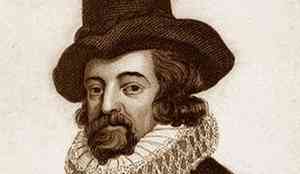 Jacopo Peri Source: Alchetron |
|
| The Baroque period is
generally given as 1600 to perhaps 1750. Baptized on 15 May 1567 in Cremona,
Italy,
Claudio Monteverdi
was already in his thirties when baroque composition and instrumentation
became a branch of exploration in Italy, Monteverdi among its advance guard.
As a younger contemporary to
Giulio Caccini,
Monteverdi was destined to take baroque to such a full and flush splendor
that "early Baroque" and "Monteverdi" are nigh interchangeable. Monteverdi
was a gamba (viol) player who studied at the University of Cremona, his
first employment as a musician at the Cathedral of Cremona in the choir.
Composing seriously as an adolescent, 'Sacrae cantiunculae' was his first
published volume of songs in 1582, an assemblage of sacred motets and
madrigals. In 1590 he was hired by Vincenzo Gonzaga, Duke of Mantua, with
whom he moved up from singer and violist to court composer. In 1607
Monteverdi composed 'L'Orfeo',
among the earliest operas nine years after what is considered the first,
Jacopo Peri's 'Dafne'
having premiered in 1598. 1613 found Monteverdi composing as choir master at
the basilica in San Marco. By 1632 Monteverdi had become a priest, sacred
music to follow. Among his last works before his death on 29 Nov 1643 was
the opera, 'L'incoronazione di Poppea' ('The Coronation of Poppea') in 1642.
He'd written some eighteen operas, but only 'L'Orfeo', 'Lamento' (an aria
from 'L'Arianna'), 'Il ritorno d'Ulisse in Patria' ('The Return of Ulysses')
and 'L'incoronazione di Poppea' have survived. Monteverdi's operas aside,
his most important works were his earlier books of madrigals, the fifth in
1605 ('Il quinto libro de madrigali a cinque voci') considered his most
significant in the development of baroque, occasioning his discussion of
counterpoint and prima pratica [*]
versus seconda pratica [1,
2,
3] in his introduction.
See also Monteverdi's contribution to the
baroque relevant to basso continuo notation: 1,
2,
3,
4,
5,
6,
7,
8.
References for Monteverdi: 1,
2,
3,
4,
5,
6.
Publications.
Compositions. Scores: 1,
2,
3,
4.
Audio samples: 1,
2,
3,
4.
Discographies: 1,
2,
3,
4,
5,
6.
Internet Archive. Further reading: second practice of counterpoint:
Ilias Chrissochoidis;
Ulrich Siegele. Bibliography: 'Letters of Claudio Monteverdi' by
Denis Stevens (Cambridge U Press 1980); 'Seconda Pratica: A Background
to Monteverdi's Madrigals' by
Denis
Arnold;
various. Other profiles: 1,
2,
3,
4.
Claudio Monteverdi Ch'io t'ami e t'ami più de la mia vita 1605 From Madrigals: Book 5 La Venexiana 1590 From Madrigals: Book 2 La Venexiana 1603 Madrigals: Book 4 Concerto Italiano/Rinaldo Alessandrini Opera Concerto Vocale 1614 Madrigals: Book 6 Concerto Italiano/Rinaldo Alessandrini 1638 Conductor: Michel Corboz 1642 Opera Teatro Comunale di Bologna Conductor: Ivor Bolton Director: Graham Vick 1607 Opera La Capella Reial de Catalunya Barcelona Director: Jordi Savall 1607 Opera Ensemble des Opernhauses Zürich Director: Nikolaus Harnoncour 1610 The Monteverdi Choir Conductor: Sir John Eliot Gardiner
|
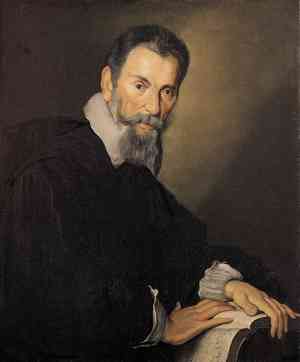 Claudio Monteverdi Source: Wikipedia |
|
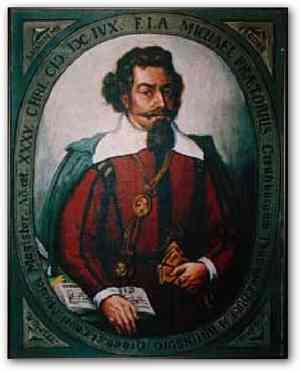 Michael Praetorius Source: Classical Net |
Born in 1571 in Creuzburg, Germany,
Michael Praetorius
was Michael Schultze, Schultheis or Schults of which Praetorius is a
Latinization, Schulzte being "mayor" in German. The musical Renaissance into
the wane of which Praetorius was born had been a considerably Catholic or
secular affair, not so grand in Germany as it had been next door in France
or over the Alps in Italy, nor even in England across the Channel which
experienced some degree of isolation from the Continent during the
Reformation as well. Relevantly, the Strait of Dover (English Channel) is
only about 21 miles across and could be sailed on a good day in three or so
hours. Though the gap between Dover and Calais in France was short enough to
encourage both commerce and assault, the Channel nevertheless served as a
natural moat when not contested. Howsoever, Praetorius studied divinity,
languages, music and philosophy at the University of Frankfurt beginning in
1582 at age eleven. Music likely included composing. He also spent a period
at the Lateinschule at Zerbst / Anhalt before graduating from Frankfurt in
1587, upon which he became organist at the Marienkirche in 1587. From
thereon and throughout his twenties Praetorius led an itinerant life as an
organ specialist, both performing as well as consulting (repair and such).
He worked for numerous churches and aristocrats during the last 13 years of
the 16th century, among them Henry Julius, Duke of Brunswick-Lüneburg,
possibly as early as 1592 [1595 per
Zachary Alley]. His journeys from place to place had also made him a
well-known composer by the turn of the century. He set 'Es ist ein Ros
entsprungen' to music in 1609, an anonymous hymn first appearing in the
'Speyer Psalter' of 1599. Known in English as 'Lo, how a rose e'er blooming', that was a
Lutheran
Christmas carol, "Ros" (Rose) symbolizing the Virgin Mary. The
importance of Mary in the liturgical music of the Catholic Church has been
noted long since. But before getting too far ahead, Praetorius' hymn
behooves us to note the Christmas carol [1,
2,
3,
4] which place is huge in the music of Western civilization. "Carol" is
Anglo-French for "choraule" (choral song) in Latin. Though modern Christmas
carols include not a few of secular variety that are famous, such as Irving
Berlin's 'White Christmas' of 1942, the most throughout the centuries were
in praise, of course, of Christ. One carol, 'Angel’s Hymn', is traced back
to 129 AD when Roman Bishop, Telesphous, ordained the song to be sung at
midnight on Christmas Eve [1,
2,
3,
4]. Its chorus, "Gloria in Excelsis Deo!," is thought to have passed its
way through the centuries to be combined with verses from the French carol
of unknown origin, 'Les Anges dans Nos Campagnes', to finally arrive in 1862
as 'Angels We Have Heard on High' [*]
with lyrics translated by John Chadwick sung to the tune of 'Gloria in
Excelsis Deo!' (not
Bach's later cantata) [*].
Christmas and its observance with carols would be outlawed for a time in the
17th century both in Cromwell's England from 1644/47 to 1660 [1,
2]
and in American New England from 1659 to 1681 [1,
2,
3]. Other than that the practice too resembled that by Roman Catholics,
another reason for the ban was that the date of December 25 had been that of
the pagan holiday, Saturnalia, not the actual birthdate of Jesus. There was
also issue w people taking the day off from work. As for Praetorius, back a
little earlier in 1602 he composed a collection of fourteen Magnificat
settings while in Regensburg that saw later publishing in 1611 in a volume
called 'Megalynodia Sionia' [1,
2,
3].
He was made Kapellmeister to Henry Julius (above) in 1604. From 1605 to 1610
he published his 9-part 'Musae Sioniae'. 'Musarum Sioniarum: motectae et
psalmi latini' appeared in their midst in 1607 [1,
2]. This is thought to contain the first sacred motets, 52 of them,
written in style baroque. In addition to the liturgical 'Megalynodia Sionia'
in 1611 Praetorius published 'Missodia Sionia' [1,
2],
'Hymnodia Sionia' [1,
2] and 'Eulogodia Sionia'
[1,
2] the same year. In 1612 he published 'Terpsichore'
[1,
2,
3], a collection of 312 dances for four instruments consisting of
bransle, courantes, voltes, ballets and gaillarde. Upon the death of Henry
Julius in 1613 Praetorius remained with his successor, Frederick Ulrich. He
was also employed by John George I, Elector of Saxony, in 1613. Though
already familiar with the Venetian School, he there studied Venetian style
which led to his accredited creation of the
chorale concerto
(not)
that would lead to the later chorale cantatas of
JS
Bach. Other important composers of the chorale concerto were Praetorius'
close contemporaries, Samuel Scheidt [*]
and Johann Hermann Schein [*].
From 1615 to 1620 Pratorius published three volumes of 'Syntagma musicum' [1,
2,
3], a
prose work addressing the reconstruction of musical instruments and their
use in Lutheran liturgy. Come 'Polyhymnia Caduceatrix & Panegyrica' ('Hymns
of Peace and Praise') in 1619 [1,
2].
Praetorius' published 'Puericinium' [1,
2]
in 1621, a collection of 14 motet settings for multiple choirs. That
may have been published before his death on his fiftieth birthday on 15 Feb
of 1621. Praetorius had been a highly prolific composer, completing no less
then twelve hundred chorale and song arrangements, his 312 instrumental
dances in 'Terpischore' and numerous other works for the Lutheran church.
Along the way he was a major figure in the introduction to Protestant
Germany of the "new music" that was the baroque surfacing in Catholic Italy.
References for Praetorius encyclopedic: 1,
2,
3; musical:
1,
2,
3,
4,
5;
David J. Susan.
Publications: CPDL; 'Gesamtausgabe der Musikalischen Werke'
IMSLP;
michael-praetorius.
Recordings: discos: 1,
2,
3,
4; reconstructions: 'Lutheran Mass for Christmas Morning' by the
Gabrieli Consort & Players directed by Paul McCreesh
*; 'Christmas Vespers' (Christmas Eve) by Apollo’s Fire directed by
Jeannette Sorrell
*; 'Ostermesse' (Easter Mass) by Weser Renaissance directed by Manfred
Cordes:
1,
2. Audio samples:
1,
2. Scores: 1,
2; 'Es ist ein Ros entsprungen'
*.
IA.
Further reading:
Linda Crampton. Biblio: 'The Cambridge History of Sixteenth-Century
Music' by Fenlon & Wistreich (Cambridge U Press 2018)
*; 'A History of Baroque Music' by George Buelow (Indiana U Press 2004)
*; 'Musical Authorship from Schütz to Bach' Stephen Rose (Cambridge U Press 2019)
*. Other profiles:
1,
2.
References for Christmas music: 1,
2;
carols: 1,
2; recordings:
'Christmas Music' by the Westminster Cathedral Choir w the Parley of Instruments
directed by David Hill.
Michael Praetorius Consort: La Canarie Eduardo Antonello Es Ist Ein Ros Entsprungen 1609 Chanticleer Es Ist Ein Ros Entsprungen Pub 1599 Frederica von Stade Hallelujah: Christ ist erstanden 1619 La Capella Ducale/Roland Wilson In dulci jubilo 1619 Gabrieli Consort & Players/Paul McCreesh Terpsichore: La Bouree Early Music Consort of London/David Munrow Terpsichore: Musarum 1612 Ricercar Consort |
|
|
Born in Florence, Italy, on 18 Dec 1575,
Michelagnolo Galilei
learned to play lute as a child. His father was
Vincenzo Galilei
and his older brother was the astronomer, Galileo Galilei [*].
In 1593 he went to Poland, likely to play lute for the Radziwiłł family.
Poland had had a
Renaissance of its own, though a bit out of the way. Returning to
Florence in 1599 to apply at the court of Ferdinando I de' Medici, Grand
Duke of Tuscany, one assumes that composition or arrangements were among
such as Galilei was concerned to present to Ferdinando, in vain, for he was
back in Poland in 1600. In 1607 he obtained an honorable court position in
Munich with Holy Roman Elector, Maximilian I of Bavaria [*].
Galilei remained in Munich, a principal cultural hot spot in Germany, the
remainder of his life. It was 1620 when Galilei published his book of
lute pieces, 'Il primo libro d'intavolatura di liuto' [*].
Galilei rose to no great prominence in greater Europe before dying in Munich
3 Jan 1631. Holding principle residencies in Poland and Munich, however,
meant a time of regional prestige. Galilei had composed mostly dances like
galliards,
voltas (voltes), courantes and
passamezzos. References:
Wikipedia. Recordings: audio samples:
1,
2; discos:
1,
2,
3.
Scores. HMR Project. All but three pieces below are toccatas. The others are corrantes. Both the
toccata
and
corrante were of fairly recent origin during the late Renaissance. The
toccata was composed mostly for keyboard or lute, usually having a quicker
tempo and emphasizing virtuosic playing.
Michelagnolo Galilei Corrente 10 Corrante Kirchmeyr Vienna Sonate in Do Minore: I Toccata Anthony Bailes Sonate in Do Minore: II Corrante Anthony Bailes Sonate in F Minor: IV Toccata Anthony Bailes Sonate in Si Bemolle Maggiore: II Corrante Anthony Bailes Toccata 2 Steve M Toccata 3 Steve M
|
||
|
Born in Sep 1583 in Ferrara, Italy,
Girolamo Frescobaldi
is another composer requisite to any account of early Baroque such that, had
it only five fingers, Frescobaldi would be one of the major. By the time
Giulio Caccini
published 'The New Music' in Florence in 1602 Frescobaldi was about nineteen
years of age. Frescobaldi's father was a property owner whose son studied
under
Luzzasco Luzzaschi in Ferrara before leaving for Rome.Numerous sources
have Frescobaldi admitted to the Accademia (Congregation) di St. Cecilia in
1604 where he may have sung and played organ. Such, however, is speculative.
Frescobaldi's presence in Rome isn't confirmable until 1607 when he was
hired on as an organist at Santa Maria. He was also
employed by the Archbishop of Rhodes, with whom he made his only journeys
beyond Italy, traveling to Flanders and Antwerp. In 1608 Frescobaldi
succeeded Ercole Pasquini as organist at St. Peter's Basilica in Rome, which
position he held intermittently until his death. Between 1610 and 1613
Frescobaldi began working for Cardinal Pietro Aldobrandini, keeping that
position until 1631. In 1614 Frescobaldi had been hired by the Duke of
Mantua. But he found the people "cold" and lasted only about five months,
that leading to his publishing of 'Toccate e partite d'intavolatura'
[*]
the next year in Rome. 'Partita sopra l'aria della Romanesca' arrived in
1616 [1,
2]. Moving ahead into the twenties, Frescobaldi published his second
volume [1,
2] of 'Toccate e partite d'intavolatura' in 1927. He is thought to have
published 'Il primo libro delle Canzoni' [*]
in Rome in 1928 before heading to Florence the same year to serve the Grand
Duke of Tuscany. He published two important books of arias there in 1630.
Rome again exerted its pull in 1634 when Pope Urban VIII
offered him a position at St. Peters. He simultaneously found himself
employed by Cardinal Francesco Barberini as well. In 1635 he published his 'Fiori
musicali'. Frescobaldi died on 1 March 1643 only about ten months the
same year before his major rival in Venice,
Monteverdi. Frescobaldi wrote no operas as did
Monteverdi, his a mastery of instrumental composition, for keyboard
especially, authoring canzonas, motets, toccatas, partitas (simply
instrumental tunes), capriccios (caprices, usually lively in free form and
often virtuosic) and fantasias (improvisational at first but developing more
rigid forms over the years). References: 1,
2,
3,
4,
5.
Compositions: 1,
2.
Scores: 1,
2,
3.
Recordings of: audio samples: 1,
2,
3
(MIDI files),
4;
discos: 1,
2,
3,
4,
5,
6.
Publications by or about. Analysis:
Frederick Hammond.
IA. Other profiles: 1,
2,
3,
4. Bibliography: 'Frescobaldi Studies' Quadricentennial Frescobaldi
Conference (1983 Duke U Press 1987)
*.
Girolamo Frescobaldi Capricci I-XII Harpsichord: Sergio Vartolo I Fiori Musicali Schola Gregoriana/Dom Nicola M. Bellinazzo Partita sopra l'Aria di Follia Doubtfully by Frescobaldi Rosemary Thomas Toccate d'Intavolatura di Cimbalo Laura Alvini Toccata Prima Clavichord: Kevin Komisaruk |
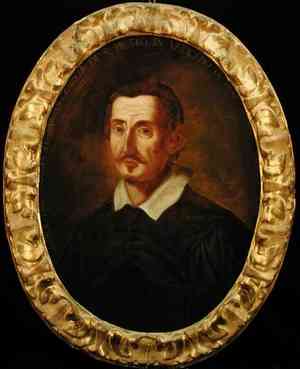 Girolamo Frescobaldi Source: Stella Sacra |
|
| Born on 18 Sep 1587
in Florence,
Francesca
Caccini, daughter of composer,
Giulio Caccini,
finds the Baroque period coming into full bloom. Caccini's first known
performance as a singer was in 1600 at the wedding of Henry IV of France and
Maria de Medici. She is thought to have begun composing shortly thereafter,
a piece called 'La Stiava', written for Carnival in 1607, among her earliest
works. By the time she published 'La Tancia' in 1613, Caccini was in her
element, working for the Medici's as a singer, teacher and composer much of
scores for stage (opera, she a young woman while opera was being developed
[with assistance from her father,
Giulio Caccini]
and beginning to catch). She followed 'La Tancia' with 'Il Passatempo' in
1614, 'Il primo libro delle musiche' in 1618 and 'La Fiera' in 1619. 'La
liberazione di Ruggiero' was published in 1625, written for Prince Ladislaus
Sigismondo visiting from Poland. Caccini is documented to have left the
Medicis (permanently) in 1641, at which point she disappears from history,
perhaps dying that year. Few works by Caccini have survived. Though her
operas hadn't the magnificence of
Monteverdi's, she otherwise left behind an admirable anthology of vocal
pieces, especially solos and duets. What scores of hers survive indicate she
was notably more the perfectionist with ink and paper than the average
composer. References:
1,
2,
3,
4,
5,
6. Audio samples:
1,
2. Scores:
1,
2. Discos:
1,
2,
3.
IA. Other profiles:
1,
2,
3,
4,
5.
Bibliography: 'Francesca Caccini at the Medici Court' by Suzanne G. Cusick
(U of Chicago Press 2009).
Francesca Caccini 1625 Opera From 'La liberazione di Ruggiero dall'isola d'Alcina' Lenoir-Rhyne Youth Chorus/Florence Jowers Mezzosoprano: Natalia Kawalek Cello: Tilly Cernitori Laute: Ulrike Flörré Violino: Andrea Benucci Clavicembalo: Alfonso Fedi Soprano: Elena Cecchi Fedi Viola da gamba: Francesco Tomei Soprano: Shannon Mercer Soprano: Maria Cristina Kiehr 1618 Soprano: Henriette Feith Theorbo: David van Ooijen 1618 Soprano: Henriette Feith Theorbo: David van Ooijen
|
||
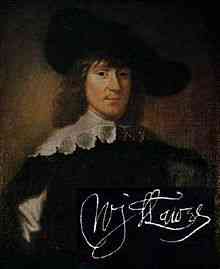 William Lawes Source: Wikipedia |
Born in April 1602 in
Salisbury, England,
William Lawes
was younger brother by five or six years to composer,
Henry Lawes. Their father, Thomas Lawes, was a vicar choral (professional
singer) at Salisbury Cathedral. Among composers on this page William owns
the distinction, unlike Henry, of not having published any of his works.
Both were tutored by
John Cooper (aka Giovanni Coprario) who acquainted them w early Italian
baroque method. Though the brothers employed baroque method such as
basso continuo in their music neither are known so much for baroque as
for their areas of expertise in general. Albeit both wrote vocal works Henry
is especially noted for those, particularly his songs. Though both wrote
instrumentals William is especially noted for those, particularly his
consorts. The spiritual climate into which the Lawes brothers were born was
Puritan, that is, Anglican with purification from Roman Catholicism its
purpose, one good reason for 102 such Puritans, also called Pilgrims, to
distance themselves from Europe by boarding the 'Mayflower'
to arrive at the Colony of Virginia [*]
in 1620. There had been prior aborted attempts to colonize America, and
Virginia had been chartered and settled earlier in 1606 and 1607, but they
are the passengers of the 'Mayflower' credited with making Virginia
America's first permanent colony. The spiritual climate back in Europe on
the continent was such that the Dominican friar, Bruno [1,
2,
3,
4,
5,
6], had been executed in Rome only two years before Lawes' birth for
believing in the possibility of multiple worlds in an infinite cosmos. It
didn't require the Church a mathematical grasp of infinity, concerning which
there is no center, to recognize that the Church wasn't the center of
Bruno's reality, though it became such soon upon his conviction of heresy,
thereupon stripped and hung upside-down on a stake for burning alive, his
ashes tossed into the Tiber. There were multiple realities far and wide on
Lawes' own globe during his era. Egypt was approaching a millennium of
Muslim Ottoman rule by the time Lawes was born, not many there for whom Rome
was at the center of things. The Church had been troubled anywhere and
everywhere constantly since the emergence of Protestantism via Luther [*]
in 1517. The Polish–Swedish War of 1600-1611 [*]
was fought during Lawes' childhood. Poles and Swedes once allied against
Russian threat now had the concerns of two opposing faiths mixed into their
helter-skelter on Earth. Lawes, too, would arrive to a reality centered in
war. Lawes found early patronage in Edward Seymour, 1st Earl of Hertford,
who found a teacher for him in composer,
John Cooper (aka Coprario) circa 1619, composition no doubt among his
studies. In 1635 he was appointed a lute player and singer to the court of
King Charles I. Lawes remained with Charles until his, Lawes', early
death in 1645. Throughout the history of music in Europe, for a musician to
acquire some position at some royal court was to arrive to the peak, there
nowhere higher to go. Except in Lawes' case, whose chariot swung low during
the
English Civil War between Charles, et al, and Parliament from 1642 to
1651, monarchial England the loser following Charles' death in '49. Having
joined the Royalist cause as among the king's Guard, Lawes was taken home
during the Battle of Rowton Heath, shot to death on 24 September 1645.
References: 1,
2,
3,
4. Audio samples:
1,
2.
Scores: 1,
2.
Recordings of: discos: 1,
2,
3,
4;
'Harp Consorts' w
Maxine Eilander (harp); 'Consorts to the Organ' by Phantasm;
'The Royal Consort' by Phantasm.
Other profiles: 1,
2,
3,
4.
Bibliography: 'William Lawes (1602-1645): Essays on His Life, Times and Work' by Andrew Ashbee (Routledge 2019)
*;
'Music in the Baroque Era - From Monteverdi to Bach' Manfred Bukofzer (Read Books 2013)
*;
Review by Arne Spohr of
'The Consort Music of William Lawes 1602-1645' by John Cunningham
1,
2;
The Cyclopaedia: Vol 20;
'Willburt Lawes and His String Music' by Rupert Erlebach
*;
'The Keyboard in Baroque Music' ed by Christopher Hogwood
*. The list below features a couple airs
[1,
2],
fantasias and pavans.
The air (aria, ayre) was a relatively new development which enjoyed a brief
period of popularity for a few decades while Lawes was young. (John
Dowland had published 'First Booke of Songs or Ayres' in 1597.) 'Consort
Set a 6 in G minor' is an air. The fantasia had been around for three
quarters of a century by the time Lawes was born. It was originally composed
to accommodate improvisation, a fantasy what one called a piece that had no
particular form, but developed various forms over time. The pavan (pavane)
was a stately slow-tempo dance, such as 'Consort Set a 5 in F' below, which
had originated in Venice about a decade before the fantasy. William Lawes Phantasm Organ: Daniel Hyde Consort Set a 6 in B flat major Jordi Savall Phantasm Organ: Daniel Hyde Divisions on a Pavan in G Minor Rose Consort of Viols Organ: Timothy Roberts The Orpheon Consort Soprano: Suzie LeBlanc Il Caleidoscopio |
|
| Baptized in Marino on
18 April 1605,
Giacomo Carissimi had
a barrel maker for a father. Alexander Carpenter at AllMusic has him
surfacing from an obscure youth at age eighteen in the choir at the Tivoli
Cathedral, becoming an organist at age nineteen. The New World Encyclopedia
has him in Assisi at age twenty where he became a chapel master. One could
think he was composing by at least that time. He later assumed the same
position at the church of Sant'Apollinare in Rome in 1628 and remained there
the rest of his life. He became a priest in 1637. Among Carissimi's
contributions to the Baroque period was the development of the
oratorio, 'Jephte' of 1648 regarded his finest [1,
2,
3,
4,
5,
6]. The
oratorio is basically an opera without theatrical drama, for the ear rather
than eye. An oratorio could be fashioned into an
opera, or if you removed theatre from opera you could get an oratorio. Its
subject matter was sacred as compared to opera which concern was
usually historical or mythological due its origins in association with
humanist intelligentsia (Greek monody). The oratorio probably became common
as a term due that they were
early performed at the Oratory of Santissimo Crocifisso in Rome. Like
opera, oratorios were intended to be grand with soloists backed by powerful
choirs and numerous instruments grouped in
orchestras
(Latin "orchestra" from Greek). In addition to oratorios Carissimi wrote cantatas and his
parody mass included in MS 1177 in 1672, 'Sciolto Havean Dall'Alte Sponde' [1,
2]. A parody mass can be a secular caricature of a mass, but it
was originally a piece of nonliturgical sacred music made to imitate
the liturgical mass. The parody mass was nothing new.
Palestrina
had composed about fifty of them in the 16th century. Carissimi's 'Missa Sciolto Havean'
was a parody of his earlier cantata of no later than 1653, 'Sciolto Havean Dall'Alte Sponde'. Carissimi died
in Rome on 12 Jan 1674.
References: 1,
2,
3,
4.
Publications by or about
*. Scores: 1,
2.
Audio samples: 1,
2.
Discos: 1,
2,
3,
4,
5.
IA.
Bibliography: 'The Cantatas of Carissimi' by Gloria Rose (Yale University 1959)
*;
'Carissimi's Tonal System' by Beverly Stein ('The Journal of Musicology' 2002)
*.
Other profiles 1,
2.
All works below are oratorios. Giacomo Carissimi 1648 Cantores Musicæ Antiquæ Florida State University Coro della Radio Svizzera Sonatori della Gioiosa Marca Diego Fasolis Ensemble San Felice/Federico Bardazzi Ensemble San Felice/Federico Bardazz Ensemble San Felice/Federico Bardazzi
|
||
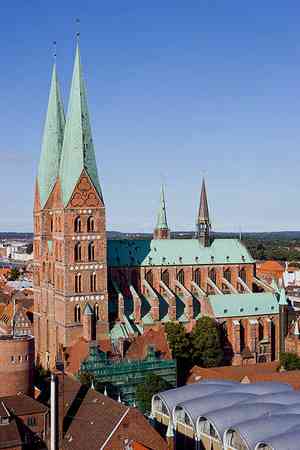 St. Mary's Lutheran Church Lubeck, Germany Source: Memrise |
Born in 1614 in
Lübeck,
Franz Tunder witnesses the
early development of baroque in Germany following
Praetorius two
generations earlier. Baroque was yet largely an Italian phenomenon during
Tunder's time, but what the Roman Church had been to the Renaissance the
Lutheran Church would be to high Baroque of
JS
Bach.
Bach, however, wasn't born until 1685, eighteen years after Tunder's
death. Tunder had became court organist to Duke Frederick III of
Holstein-Gottorp [*]
in 1632, age eighteen. He had studied a few years earlier in Italy. in 1641
he became head organist at St. Mary's Lutheran church in Lübeck. In 1647 his
position was enlarged to administrator and treasurer as well. Tunder worked
in that capacity for the next twenty years until his death on 5 Nov 1667.
Although Tunder was and is considered among the more important composers of
his time little of his work has survived, lost like the original St. Mary's
Catholic Church constructed between 1250 and 1350 AD, become Lutheran during
the early Reformation by 1532 with Hermann Bonnus its first pastor. To the
right is its interior rebuilt upon nigh obliteration during World War II.
References:
1,
2,
3,
4.
Compositions.
Scores. Audio samples: 1,
2.
Discographies: 1,
2,
3,
4.
Internet Archive. Further reading: Georg Predota.
Bibliogrqphy: 'Franz Tunder: 1614-1667' by G.B. Sharp ('The Musical Times' 1967).
Franz Tunder Teares of the Muses Organ: Paul Fritts Crescendo Chorus Crescendo Period Instrument Orchestra In dich hab ich gehoffet, Herr Organ: Pieter Dirksen Organ: Marcus Hufnagl Barokensemble Consort of Voices Organ: Friedhelm Flamme |
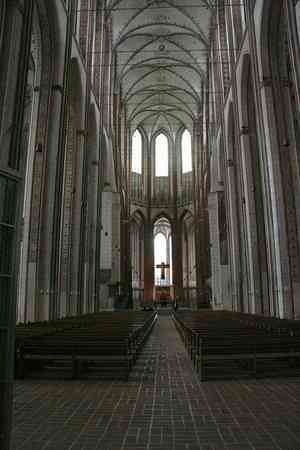 St. Mary's Lutheran Church Lubeck, Germany |
| Baptized on 19 May
1616 in Stuttgart,
Johann
Jakob Froberger witnesses baroque in Germany a couple generations after its emergence in
Italy about 1600, he an important link from its prominence in Italy toward
its future dominance in Germany. By the time Froberger was born early
medieval music had reached to a peak in France with the building of Notre
Dame circa 1200 (yet in construction). With the intentional study of music
among Notre Dame's purposes, being associated with the University of Paris,
composing quickly became a sophisticated craft. Troubadours, meanwhile, were
traveling about from one estate to the next throughout France. Seeking
patronage from royal courts for secular music led to the Burgundian school
followed by the Franco-Flemish school in the Low Countries, of which the
Renaissance burgeoned in combination with humanism, the latter a scholastic
revival of matters classical, that is, largely ancient Greece. As the
Renaissance arrived to its greatest muscle in the Roman and Venetian schools
Germany arrived to its own cultural
Renaissance despite the mindset of Luther's
Reformation more concerned with matters Biblical than Greek. Though far away Poland had had its
Renaissance as well, Russia even more distant remained largely an observer
of matters European. As the term implies, the Renaissance was a bloom of
many parts both sacred and secular. Another of its more obvious divisions
had been wrought by the Reformation, making it a Catholic Renaissance in
southern Europe stretching from Spain to Venice, and a Protestant
Renaissance in embattled (contrapuntal, say) northern Europe. Catholics and
Protestants, however, weren't the only in the land with an interest in
temporal power. Nigh anywhere there was an aristocrat or royal court there
was trouble as well, all from counts to dukes to emperors preferring to
wield a relatively absolute power on Earth. Among the endless omnipresent
arguments between monarchical powers was the Thirty Years War [1,
2,
3,
4], among the deadliest in European history which began on 23 May 1618,
four days after Froberger's second birthday. Stuttgart, where he was born,
was situated midway between two of that war's main belligerents, France and
Bavaria, that is, France and its allies, principally Dutch and Swedish,
versus the Habsburg Holy Roman Empire that included, especially, Bavaria and
Spain, and was allied with the Roman papacy. Stuttgart was located in
present day Baden-Württemberg (belonging to Habsburg Spain) with France its
western border and Bavaria (belonging to Habsburg Austria) its eastern. As
the Thirty Years War didn't cease until 25 May of 1648 Froberger would have
ineluctably experienced, been witness to and begun composing in the midst of
the countless miseries of that contest. From three to more than eleven
million were killed during the three decades of that struggle. The
population in Germany was reduced by 25 to 40 percent. During the more
peaceful year of Froberger's birth in 1616 his father was kapellmeister to
the Württemberg court and had a library which included above a hundred books
of music. To own a book at Froberger's time in Germany was to have money.
Gutenberg had invented the printing press about 1450 but a book was yet an
expensive thing to buy, something beyond the means of the common Joe. Though
probably safe to say that Froberger didn't have to learn how to drive a
wagon as a child, what with thirty years worth of corpses to cart around,
his education as a youth is otherwise speculative. Little is certain
concerning Froberger until 1637, when he and his brother, Isaac, sold their
father's library upon the latter's death of plague which took their mother
and a sister as well. A more positive event arrived that year upon obtaining
employmant as an organist in Vienna. Granted a stipend to study under
Frescobaldi in Rome, Froberger spent the next three years in Italy
before returning to Vienna in 1641, both a Catholic and composer now if not
before. He there worked as an organist and chamber musician before returning
to Italy in 1645 to study music under the Jesuit polymath,
Athanasius Kircher, in Rome. He returned to Vienna in 1649, there to
present Holy Roman Emperor,
Ferdinand III, with his completed 'Libro Secundo'
[IMSLP], a volume of 24 pieces divided into four chapters containing six each of toccatas, suites, fantasias and canzonas. But the death of
Empress Maria Leopoldine, she a brief wife at age seventeen, left a climate on things
such that Froberger left Vienna to spend the next few years traveling Europe
from Germany to the Low Countries to London. He may have been employed, as
well, by Ferdinand III as a diplomat or spy. 1652 found him in Paris where
he likely became acquainted with composer,
Louis Couperin, before
returning to Vienna yet again in 1653. He there completed 'Libro Quarto'
[IMSLP] in 1656. Like 'Libro Secundo', 'Quatro' contained 24 pieces divided
into four chapters, this time containing six each of toccatas, suites,
ricercars and capriccios. Froberger transitioned to Leopold I upon
Ferdinand's death in 1657. He that year dedicated 'Libro di capricci e
ricercate' to Leopold. Nevertheless, political complexity at Leopold's court found Froberger released from service the same year. Though known to have made a
brief trip to Mainz in 1665 he spent the majority of his last ten years in
Château d’Héricourt in the employ of the dowager Duchess of Montbéliard. He
died of apoplexy on 7 May 1667. Unlike many composers of his era, Froberger
published none of his work, and only two of his compositions were printed in
his lifetime. His teacher in Rome during the forties, Athanasius Kircher,
published Froberger's 'Hexachord Fantasia' [1,
2]
in his 'Musurgia Universalis' of 1650 [1,
2,
3,
4,
5].
In 1660 François Roberday published 'Fugues et Caprices' [1,
2] in Paris in which
his 'Fugue 5' was a version Froberger's 'Ricercar 1' of 1658. That altered
version was the second and last composition by Froberger to see print during
his lifetime. The works for which Forberger is best-known and most
influential to the Baroque period are his numerous dance suites for
keyboards [1,
2,
3,
4,
5] in which he originated the standard order of an allemande first,
courante second, sarabande third and gigue fourth. Those seem to be intended
more for harpsichord than organ. Froberger's final compositions are thought
to have been found in a lost autograph titled 'Livre Primiere' [Asperen]
finally emerging at a Sotheby's auction in London in 2006. Froberger's suites are titled Suites in the
DTO cataloguing system of Guido Adler
[1,
2].
In Siegbert Rampe's [1,
2,
3] more recent system (FbWV) they are called Partitas
[*].
Classical Archives presents both [*].
Froberger also composed choral works, two of his motets yet extant:
'Alleluia! Absorpta es mors' and 'Apparuerunt apostolis'. References: 1,
2,
3,
4,
5,
6.
Compositions. Scores: 1,
2,
3.
Audio at BBC. Recordings: discos: 1,
2,
3; 'Froberger' by Glen Wilson:
1,
2; 'Froberger: Complete Music for Harpsichord & Organ' by Simone Stella:
1,
2; 'Froberger Edition' by Bob van Asperen
*; 'Froberger: The Unknown Works' by Siegbert Rampe
*; 'Libro Quarto of 1656' by Web Wiggins
*; 'Suites for Harpsichord' by Gilbert Rowland:
1,
2; 'Toccatas and Partitas' by Sergio Vartolo:
1,
2.
Discussion. Further reading: Norbert Müllemann:
1,
2;
David Schulenberg*.
Biblio: 'J.J. Froberger: 1614-1667' by
G.B. Sharp; 'Searching Fantasy' by
Terence Charlston. Other profiles: 1,
2,
3.
Johann Froberger 1656 Organ: Markus Märkl DTÖ Fantasia No. 2 FbWV 202 Harpsichord: Andreas Zappe 'Complaint Made in London' 1656 Clavicembalo: Stefano Lorenzetti Allemande Authorship unconfirmed Lute: Andreas Martin 1649 DTÖ Toccata No. 2 FbWV 102Organ: Jim Kosnik 1649 DTÖ Toccata No. 3 FbWV 103 Harpsichord: Marius Bartoccini ' Sur la mort de Monsieur Blancrocher'FbWV 632 Clavecin: Skip Sempé |
||
| Born in 1619 (perhaps
1615/17) in Oelsnitz, Saxony,
Johann Rosenmüller
shoveled more coal into the stove that would eventually see Germany's engine
steaming ahead of Italy's in baroque composition. Rosenmuller attended the
Lateinschule at Oelsnitz as a youth where music was likely part of his
curriculum. He enrolled into the University of Leipzig in 1640 to study
theology and might have been composing by that time, as he also studied
music under Tobias Michael and acquired employment upon graduating in 1642
as an assistant music teacher at the Thomasschule where he remained
throughout the forties. Rosenmuller published his first volume of
compositions in 1645: 'Paduanen, Alemanden, Couranten, Balletten,
Sarabanden' [1,
2,
3]. 'Kern-Spruche' ('Key-Sayings' from the Old and New Testaments)
followed in 1648, a collection of 20 sacred concertos [1,
2,
3,
4].
Rosenmuller was yet a teaching assistant in 1650, but moved up in the world
upon becoming an organist at St. Nicholas Church in 1651. He published
'Andere Kern-Sprüche' ('Other Key-Sayings') in Hamburg in 1652 [1,
2,
3], a collection of sacred songs for voice, strings (violin, viol) and
continuo (unspecified bass instrument). Becoming musical director in
absentia to the Altenburg court some 25 miles south of Leipzig in 1654, he
published 'Studenten-Music' [1,
2,
3], a collection of seven dances (Paduans) and 10 suites for unspecified
instruments. "Paduan" probably refers to the pavane [1,
2], a slow processional court dance originating in Italy in the early
16th century similar to the basse dance [*]
emerging in France in the 14th century. Rosenmuller was imprisoned the next
year for homosexual activity. Yet 1658 found him enviably employed at St.
Mark's Basilica in Venice, he having escaped. Between 1678 and 1682 he
taught music at the Ospedale della Pietà, an esteemed music school and
orphanage. His final volume of compositions, 'Sonate à 2, 3, 4 è 5
Stromenti', arrived in 1682 [1,
2]. He next served the court of Anthony Ulrich, Duke of
Brunswick-Wolfenbüttel, as choirmaster until his death in Wolfenbüttel on 10
September 1684. Rosenmuller brings us to a couple important elements in
baroque, late here in addressing, which bear mention before continuing much
further. The first is continuo, also known as basso continuo or figured bass
[1,
2,
3,
4,
5,
6,
7].
Continuo dates back to the latter 16th century upon the emergence of
polychoral works as an instrumental means of keeping a constant meter or
recurring rhythm. That flowed into the Baroque to become a standard method
of the period elemental to baroque notation as well. Relatedly, it is during
the baroque that
bar lines were added to the staff specifically to indicate regular
repeating measures. Bar lines in earlier scores of the 15th or 16th century
had other divisional purposes, sometimes to define each beat. The basso
continuo had been preceded by the
ostinato
in the interest of persistently repeating musical patterns or phrases.
Ostinatos are identified as early as the 13th century in the English
rota
or round, 'Sumer
is icumen in' ('Summer Has Arrived') of 1260 in particular, that
possibly written by W. de Wycombe. Rendition by the
Hilliard Ensemble. The ostinato made its way into the Baroque to remain
ever since, arriving to contemporary times as the
riff
or
vamp.
A good example of a modern ostinato ia the driving bass and piano in
Henry Mancini's 'Peter
Gunn'. References:
1,
2,
3,
4,
5,
6.
Scores: 1,
2,
3,
4.
Compositions. Audio samples: 1,
2,
3
(MIDI downloads). Recordings: discos: 1,
2,
3,
4,
5;
Ensemble Masques directed by harpsichordist, Olivier Fortin: 'Sonate a 2, 3, 4 e 5 Stromenti':
1,
2,
3;
Johann Rosenmüller Ensemble directed by Arno Paduch: 'Deutsche Geistliche Konzerte' ('German Sacred Concertos')
*,
'Venezianische Abendmusik' ('Venetan Evensong')
*.
Biblio:
August Horneffer (1898);
Hymnology.
See also: 1,
2,
3.
Johann Rosenmüller Hebet eure Augen auf gen Himmel 1648 Soprano: Olga Nazaykinskaya Tenor: Ivliy Semenenok 1648 Soprano: Ellen Hargis The King's Noyse/David Douglass 1648 Cantus Cölln O felicissimus paradysi aspectus Soprano: Sonja Adam ' Behold the Works of God'1652 Jordi Savall 1682 El Concierto Ylustrado Windsbacher Boys Choir Karl-Friedrich Beringer |
||
| Likely born in 1626
in Chaumes-en-Brie,
Louis
Couperin, son of a small
landowner, serves as the initial example of French Baroque on this page, and
the first instance of several major musicians bearing the Couperin name [1,
2]. The first record of the Couperin name is from 1356. The first
musical Couperin is thought be one Mathurin Couperin, an amateur who was a
trader by profession. His son, Charles, was the father of Louis. Though
Louis played viol as well, the majority of his compositions were for
harpsichord and organ. Among first records of him he is discovered to be a
cleric in Chaumes by 1641. He was probably composing by some time in the
forties and skilled at harpsichord, as his career in music is said to have
sparked in 1650 when he and two younger brothers performed compositions by
Louis for composer and harpsichordist, Jacques Champion de Chambonnières [*],
at the latter's home in Le Plessis-Feu-Aussoux near Paris ['Le
Parnasse François' Titon du Tillet Evrard]. Chambonnières was impressed, upon
which Couperin traded Chaumes-en-Brie for Paris 30 miles of so northeast to
began studies under Chambonnières. In 1653 Couperin became an organist at
the Church of St. Gervais in Paris where he remained the whole of his
career. During that time he also worked for Marquis Abel Servien from 1656
to 1658. Couperin died on 29 August 1661, only about age thirty-five, causes
unknown. Louis' younger brothers, Charles and François, with whom he'd begun
his career only a decade earlier were also living at St. Gervais. Though
literature about Couperin is less than vast, he enjoyed the high esteem of
his peers at the time as an especially talented craftsman, both as a
composer and performer. A couple hundred compositions by Couperin exist in
the Bauyn manuscript of 1690 [1,
2]
and the Oldham manuscript discovered in 1957 [1,
2]. Louis himself didn't publish anything during his lifetime. Images of
the Couperin family are not uncommonly confused. Research on any of them
invariably finds one represented as another somewhere. The image to the
right is a portrait Louis' brother, Charles, painted by Claude Lefèbvre
sometime between 1665 and 1670. That is the Charles who began his career
along with Louis and Francois mentioned above. The portrait is often
mistaken for Louis, made easy by the 1979 album issued by Gustav Leonhardt,
'Suiten
und Pavane', which has Charles' portrait on its cover as Louis. No
images of Louis, if any exist, are found. See
'The Other M Couperin' by Glen Wilson as to Louis' brother, Charles
(1639-79). As for Francois (1631-1701), though reportedly popular and
talented at harpsichord alike Louis, he remains an obscure figure, not to be
confused with Louis' later nephew,
François Couperin le Grand
(1668-1733), son of Charles to the right. References 1,
2,
3.
Compositions: 1,
2;
reviews: 'Pièces de Clavecin' from the Bauyn manuscript:
1,
2.
Scores. Audio: 1,
2.
Recordings of: discos: 1,
2,
3,
4,
5,
6,
7,
8;
'Couperin: Dances from the Bauyn Manuscript' by Pavel Kolesnikov:
*.
Discussion. Bibliography: Bruce Gustafson ('Early Music' 2005):
1,
2;
Tillet's 'Le Parnasse François': 1,
2.
Other profiles: 1,
2.
Louis Couperin Organ: Warren Steel Harpsichord: Ernst Stolz Prelude a l'imitation de Mr. Froberger Harpsichord: Peter Kramer Lana Krakovskiy Harpsichord: Alberto Bagnai Harpsichord: Richard Egarr Klawesyn: Monika Forys Harpsichord: Gustav Leonhardt |
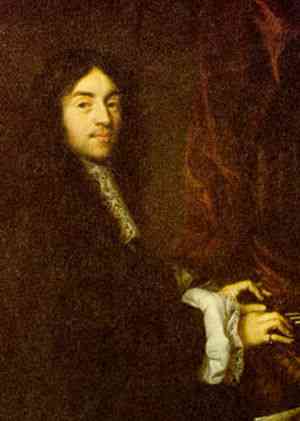 Charles Couperin brother to Louis Painting: Claude Lefèbvre 1665-70 Source: Pedro Beltrán Abogados |
|
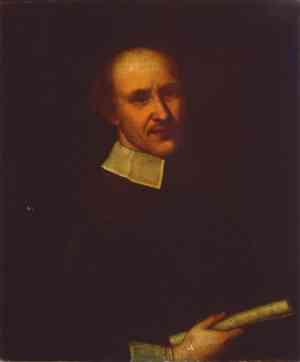 Giovanni Legrenzi Source: Wikipedia |
Baptized on 12 August
1626 in Clusone, Republic of Venice,
Giovanni Legrenzi had
a violinist and composer for a father. As is father taught him music as a
youth Giovanni may have been composing by the time of his earliest known
employment as organist at the Basilica di Santa Maria Maggiore in Bergamo in
1645 where he remained until 1656. He was ordained as a priest in 1651. He
first published in 1654 in Venice, a book of music for Mass and Vespers
called 'Concerti Musicali Op 1' [1,
2,
3]. In 1656 Legrenzi became maestro di cappella at the Academy of the
Holy Spirit until 1665, that a fraternity of musicians who supplied music in
Ferrara. His first of nineteen operas, 'Nino, il giusto', was performed in
1662 in Ferrara. His second opera, 'L'achille in Sciro' [*],
premiered in 1663 in Ferrara. Partnering w librettist, Ippolito Bentivoglio
[*],
that was greatly successful, his now becoming a name. Along w operas
Legrenzi wrote numerous oratorios. Oratorios are grand choral and
instrumental works like opera but without stage, made to hear rather than
see. His first, 'Oratorio del giuditio', premiered in Vienna in 1665. In
1670 he was appointed Maestro di Musica at the Ospedale Santa Maria dei
Derelitti in Venice, more commonly called the Ospedaletto. By that time
Legrenzi owned land in Clusone, comfortable of numerous published works and
several operas. While at the Ospedaletto, Legrenzi composed 'La divisione
del mondo' [1,
2] for premiere at the Teatro San Salvador in Venice on 4 Feb 1675, that
among his most popular works. He became Maestro di Coro of the Ospedale dei
Mendicanti in 1676 until 1682. Legrenzi was a star composer by then, but the
early eighties brought increased upon the premiere of 'Il Giustino' at the
Teatro San Salvador in Venice on 7 Feb 1683. He followed that the next year
w his highly successful 'Publio Elio Pertinace' [1,
2]. Legranzi was appointed Maestro di Cappella at San Marco (St. Mark's
Basilica) in April 1685, followed by his final opera, 'Ifianassa e Melampo',
that autumn. His last of fourteen oratorios [Wikipedia], 'Erodiade',
appeared in 1687. Legrenzi's health had
begun to falter by the time he became Maestro at San Marco, less and less
able to perform. He is thought to have died in the horrible pain of kidney
stones on 27 May 1690. His last two books assigned an opus were 'Sonate a 2,
3, 4, 5, 6 e 7 istrumenti' (Op 18) in 1693 and 'Voci geniali, raccolte in duetti e terzetti'
(Op 19) in 1698. Both of these are lost. Works with opus (plural = opera) numbers (: Op 1) in Legrenzi are other than his operas or oratorios and were later assigned due
to necessity upon a couple of volumes mistakenly introduced as his tenth.
His first opus, 'Concerti Musicali', had been described as "Opera Prima" on
the title page, not Opus 1. In 1670 his 'Acclamationi Divote' [1,
2]
was described as 'Opera X'. Three years later his 'La Cetra' [*]
was erroneously printed as 'Opera Decima'. As both couldn't be his tenth, a
revised copy of 'Acclamationi Divote' remedied the problem by describing it
as 'Opera Xi', the small "i" indicating a plural. Legrenzi's volume
following 'La Cetra' ('Cantate e Canzonette': 1,
2)
was correctly labeled his twelfth in 1676, although 'La Cetra' was
reissued in 1682 once again erroneously as his tenth. "What a lot of
baloney!" he might have shouted to the skies, both editions printed in
Bologna. Eventually 'Acclamationi Divote' became as it was, Op 10, 'La
Cetra' became Op 11 and 'Cantate e Canzonette' Op 12. References: 1,
2,
3,
4,
5,
6,
7.
Publications. Scores: 1,
2.
Operas: 'Zenobia e Radamisto' 1665
*; 'Eteocle e Polinice' 1674
*;
'La divisione del mondo' 1675
*; 'Totila' 1677
*;
'Giustino' 1683
*.
Oratorios. Audio samples: 1,
2.
Recordings of: 1,
2,
3,
4,
5,
6.
Internet Archive. Further reading: 'Sacri concerti' by
Luigi
Collarile. Bibliography: 'Legranzi perduto: Appunti di bibliografia' by
Luigi Collarile. Other profiles: 1,
2,
3,
4,
5,
6,
7.
Giovanni Legrenzi Cantores Musicæ Antiquæ/Jeffery Kite-Powell Ricercar Consort/Philippe Pierlot Musica Antique Prague Pallade Musica |
|
|
Although born in Florence, Italy, on 28 or 29 November 1632,
Jean-Baptiste Lully
fairly represents French Baroque in full bloom. Originally named Giovanni
Battista Lulli, he learned guitar and violin as a youth, taught by a
Franciscan friar. In 1646 Charles, Duke of Guise, saw Lully play violin at
Mardi Gras and took him to Paris to serve his niece,
Mademoiselle de Montpensier
(Duchess of Montpensier), as chamber boy, also working in the scullery. He
meanwhile assisted her with conversational Italian. As a skilled musician,
however, he was soon studying keyboard under Nicolas Gigault and Francois
Roberday. Examining theory with Nicolas Métru, he also performed with the
court's musicians. He is later quoted as saying that he learned everything
he needed to know about music by age seventeen while in the service of M de
Montpensier. He left that position in 1652, not wishing to follow his matron
into rural exile, her life in danger duef the Fronde rebellions of 1648-59.
Which is one version. The other is that he was dismissed for writing
"scurrilous" verse. Either way, in 1653 Lully met fifteen year-old
Louis XIV, the pair dancing together in a ballet, upon which he became
court composer of instrumental music. When Louis began governing in 1661
Lully officially became a French subject and musical director for the royal
family, at which point his compositions were automatically published. In 15
years he'd climbed from humble positions in a royal household, albeit that
of a duchess up there with the face cards, to a plateau where there was no
higher a musician could go. Except to also begin an eleven-year
collaboration with the playwright,
Molière, in 1661, they producing 'Les Fâcheux' that year, and 'Le
Mariage Forcé' in 1664. In 1672 he became director of the Académie Royale de
Musique, that is, royal opera, thereafter producing nigh an opera per year
until his passing in 1687. During that time in the early eighties he began
to fall from Louis' favor, perhaps for being bisexual. In 1687 Lully managed
to accidentally puncture his foot with a conducting wand during a
performance celebrating Louis' recovery from recent surgery, to die of
gangrene in Paris on 22 March 1687. The largest body of Lully's works were
intermedes (music inserted between acts or written into another
composer's work such as a ballet),
ballets du cour (court ballets),
sacred motets
grand and petit, and operas.
Among ballets were his French overtures
as well as the comédie-ballet with Molière. One thing you would probably see in a scene
in a movie about Louis XIV is the minuet, brought to Earth by Lully, though
some think it originated in the province of Poitou, he picking it up for
theatrical works which tempo is quicker than for the slower disciplined
dance that become popular during Lully's service to Louis. Lully composed
some 92 theatrical minuets. Johann Sebastian Bach
and George Handel
later included minuets in suites, and Mozart's first
composition at age 6 was a minuet. It developed into the scherzo w
Beethoven. By the
time Lully was finished so was Italian dominance of the baroque, that moving
to northern Europe. Albeit Italiano, Lully made a point of being a
French
composer by once stating, "Italy? Never heard of it." References for Lully:
1,
2,
3,
4,
5.
Compositions. Scores: 1,
2,
3,
4.
Audio samples: 1,
2. Recordings of:
1,
2,
3,
4,
5,
6.
Internet Archive.
Discussion.
Further reading: Harold Sack;
Ruth Watanabe.
Bibliography: 'Jean Baptiste Lully' by R.H.F. Scott (Peter Owen Publishers/
London 1973); 'Jean-Baptiste Lully and the Music of the French Baroque:
Essays in Honor of James R. Anthony'
*;
Oxford.
Other profiles: 1,
2,
3,
4,
5,
6,
7.
References for the minuet: 1,
2,
3,
4,
5,
6;
minuet and trio: 1,
2.
Jean-Baptiste Lully 1685/86 LWV 71 Les Talens LyriquesChristophe Rousse 1676 LWV 53 Les Arts Florissants1670 LWV 43 Theatre Le Trianon a ParisLWV 74/4 Les Dames du Port-royalDirector: Martin Robidoux 1685 LWV 68 Ludovice Ensemble Fernando Miguel Jalôto 1676 LWV 54 Les Talens Lyriques 1668 LWV 38 From 'George Dandin' Le Concert des Nations/Jordi Savall 1678 LWV 56 Soprano: Carolyn Sampson 1677 LWV 55 Musica Florea/Marek Štryncl |
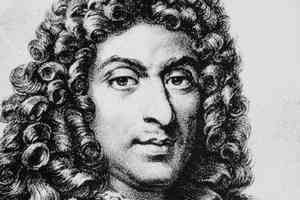 Jean-Baptiste Lully Source: Rhapsody |
|
| Born in the Grand
Duchy of Tuscany on 7 December 1637,
Bernardo Pasquini
kept people going to church in Italy as the latter's early dominance of the
early Baroque period began shifting to northern Europe. Along w a lot of
keyboard music, Pasquini composed largely cantatas, operas and oratorios,
forms arising simultaneously and elemental to the Baroque period. Pasquini
had studied under Mariotto Bocciantini in Uzzano before following his uncle
to Ferrara in 1650 where he became a university organist at Accademia della
Morte in 1654. 1657 found him an organist at Santa Maria in Vallicella. In
1664 he began doing double duty as organist at both the Basilica di Santa
Maria Maggiore and Santa Maria in Aracoeli. He found patronage in Prince
Borghese in 1667. In 1706 Pasquini became a member of the
Accademia degli Arcadi, an influential literary and musical circle
formed in 1656 by Queen Christina (who had abdicated the Swedish throne in
1654, converted to Catholicism and moved to Rome). Pasquini was buried in
the Church of St Lawrence in Lucina upon his death in Rome on 21 Nov 1710. References: 1,
2,
3,
4,
5,
6.
Compositions. Scores: 1,
2.
Audio: .1,
2
Recordings: discos: 1,
2,
3,
4,
5;
'Passion Cantatas' w Sharon Rostorf-Zamir (soprano)
*;
'La sete di Christo' w Francesca Aspromonte (soprano)
1,
2;
'Sonate per gravicembalo' w Roberto Loreggian (harpsichord/ spinet) & Francesco Ferrarini (cello)
*.
IA.
Further reading: John Collins
(PDF);
Giancarlo Fioretti.
Biblio: 'Bernardo Pasquini: musicista del secolo
XVII'
Virgilio Virgili (E. Nucci 1908); 'A Source of Pasquini Partimenti in
Naples' ('Pasquini Symposium' ed. by Armando Carideo 2012) *. Other profiles: *.
Bernardo Pasquini Organ: Marju Riisikamp Aria Cantata: 'Hor ch'il ciel fra densi horrori' Capella Tiberina See 'Passion Cantatas' Soprano: S. Tomasello Organ: Edoardo Bellotti Harpsichord: Claudio Di Veroli 1689 Performance unknown Toccata con lo scherzo del Cuccù Organ: Federico Teti |
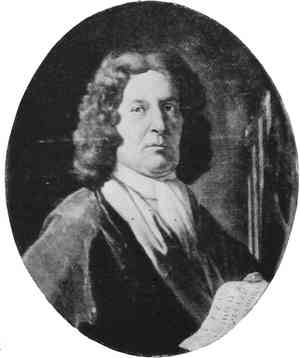 Bernardo Pasquini Source: Bernard Gordillo |
|
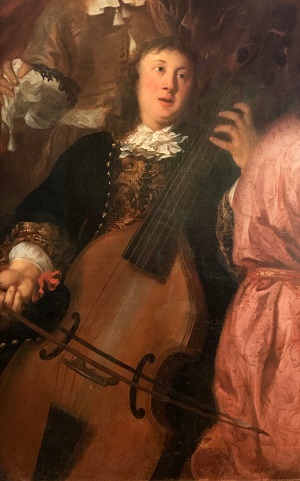 Dietrich Buxtehude Painting: Johannes Voorhout 1674 Source: Wikipedia |
Born about 1638,
Dietrich Buxtehude hailed from
Helsingborg when it was part of Denmark rather than Sweden. Others think he
was born in Holstein when it was part of Denmark instead of Germany. Either
way he was Dane with a name Germanized by himself (Diderich to Dietrich). As
Buxtehude's father was a church organist in Helsingør he likely studied
music as a youth. Buxtehude is thought to have been employed as an organist
in 1657 in Helsingborg, then at Helsingør in 1660. In 1668 he succeeded
Franz Tunder as organist at
St. Mary's Church in Lübeck. Buxtehude composed largely for organ,
harpsichord and voice in a broad variety of forms, though he preferred
cantatas,
preludes,
sonatas
and
fugues.
The librettos to his oratorios survive, but the scores do not. Buxtehude's position at St. Mary's
might have been enviable, but only to degree. Wishing to retire in 1703, he offered his station to both
Johann Mattheson
and George Handel
(the pair traveling to visit him together) on condition that it come with
betrothal to one of his daughters, Anna Margareta. Both declined, leaving
the next day [1,
2,
3]. It wasn't easy for Buxtehude's daughter, unblessed w comely
appearance, to be as popular as her father's music: in 1705
Johann Sebastian Bach was twenty years old when he walked more than 250
miles to study under Buxtehude. Though he stayed three months he left a
bachelor as well. Buxtehude died two years later on 9 May 1707. His position
along w Anna Margareta went to Johann Christian
Schieferdecker. References: 1,
2,
3,
4.
Chronology.
Compositions. Scores: 1,
2.
Audio: 1,
2. Recordings of:
1,
2,
3,
4,
5,
6,
7,
8
(MIDI files);
'Complete
Organ Works' w organ by
Hans
Davidson; 'The Complete Organ Works' Vol 1-5 w organ by Christopher
Herrick [1,
2]:
1,
2,
3,
4,
5.
Biblio: 'Dieterich Buxtehude: Organist in Lübeck' by Kerala Snyder
(Schirmer Reference 1987) 1,
2;
Oxford.
Other profiles: 1,
2,
3,
4,
5,
6,
7.
Dietrich Buxtehude BuxWV 160 Orquesta Sinfonica Direction: Dietrich ParedesOrquestacion: Carlos Chavez BuxWV13 Lyrics: Cyriacus Schneegass The Purcell Quartet BuxWV 15 Orchestra Anima EternaBuxWV 62 Collegium Vocale Orchestra Anima Eterna & The Royal Consort Jos Van Immerseel 1690 BuxWV 64 Aradia Ensemble1680 BuxWV 75 The Amsterdam Baroque Orchestra BuxWV 161 Organ: Pierre Thimus |
|
|
Born in Arnstadt, Germany, on 18 Dec 1642,
Johann
Christoph Bach
was 1st cousin once removed of more famous
Johann Sebastian Bach. He's not to be confused with Sebastian's uncle or
brother, both composers, all three sharing the same name [*].
This
Cristoph Bach was elder brother to composer,
Johann Michael Bach,
with whom German Baroque came into full bloom. Like the musical dynasty of
which
Louis Couperin was a
member [*],
there were enough musicians popping out of Bach ovens to run a Nabisco plant
[Bach dynasty:
1,
2,
3], of which this history treats only eight. The
Couperin
name was perhaps a couple centuries older than Bach's. It's thought that at
the start of the 16th century there existed four branches of the Bach
family, though the first records of a Bach don't occur until Veit (Vitus)
Bach about 1550, a baker in Wechmar who had fled Hungary for being Lutheran.
The first known musically professional Bach was Johannes Hans, born about
1580, who preferred playing pipe to baking. But with Johann Cristoph and his
brother, Johann Michael, the Bach name began to loom large. As the son of
Heinrich Bach, the latter a musician, Johann Christoph was taught music as a
youth, most likely composing by the sixties. Bach Cantatas has him employed
at the Arnstadt castle chapel in Thuringia as of 20 Nov 1663. Two years
later he became town organist of Eisenach at St. George's where he remained
his whole career. Also employed as organist and harpsichordist at the kapelle (chapel) of the court of the Duke of Eisenach, he likewise held that
position until his death. Albeit Johann Christoph Bach was a successful
composer and organist, ranked by some as the only other Bach to approach the
stature of
Johann Sebastian, he didn't have a head for finance, dying heavily in
debt in Eisenach on 31 March 1703. References:
1,
2.
Scores: 1,
2.
Audio: 1,
2.
Discos: 1,
2,
3,
4,
5.
Other profiles 1,
2.
The list below begins and ends with a lamento. 'Es erhub sich ein
Streit' is a cantata. From its beginnings as a solo voice madrigal prior to
Bach's birth, the cantata quickly swelled into greater forms involving
choruses and orchestras, as Bach is witness. Johann Christoph Bach Ach, daß ich Wassers g'nug hätte Tallahassee Bach Parley Wiener Sängerknaben & Chorus Viennensis Hans Gillesberger Concentus Musicus Wien Nikolaus Harnoncourt Rheinische Kantorei Director: Reinhard Goebel1676 Zsuzsi Toth: Sopran Violine: Susanna Ogata The Bach Ensemble/Josua Rifkin Clavecin: Gustav Leonhardt Was betrübst du dich, mein Herz Organ: Jörn Boysen Accademia Hermans |
||
| Born in the Paris vicinity 1643,
Marc-Antoine Charpentier
was a prolific composer of both sacred music, largely motets, and secular
works, especially for theatre. Knowledge of his music has a big head start
in the 28 volumes of autograph manuscripts he left behind to the Royal
Library, now housed at Bibliothèque Nationale de France. Those are known as
the Melanges or Meslanges Autographs [1,
2,
3,
4].
Sacred works included hymns,
masses,
antiphons,
sequences, Leçons des ténèbres [1,
2]
and responsories. Charpentier had also composed nine Litanies de la Vierge
(Litanies of Loreto), that is, of the Virgin Mary, H 82-90 [1,
2,
3]. He
composed settings for the
Magnificat, Te Deum [1,
2] and 'Psalms'. He wrote numerous motets for 'Domine
salvum fac regem' and
oratorios.
Secular works included airs sérieux and à boire (for drinking), cantatas,
pastorales, divertissements [1,
2],
operas,
intermedes and
incidental music. Charpentier had been a law student in Paris at about
age nineteen in 1662 [*].
He completed only one semester before quitting, not seeming to show up again until studying under
Giacomo Carissimi
in Rome, likely from 1667 to 69 per most sources
[1665: 1,
2].
Returning to France, he became courtier to
Marie de Lorraine, Duchess de Guise, for whom he composed for the next
seventeen years. Another significant patron of his in that time was Isabelle
d'Orléans, also known as Élisabeth Marguerite d'Orléans [1,
2]. Among theatrical works composed during those years were his
pastoral opera, 'Actéon' H 481 composed 1683-1685 [1,
2], and his
chamber opera, 'La Descente d'Orphée aux Enfers' H 488 of early 1686 [Wikipedia]. In 1687 Charpentier became maître de musique to the
Jesuits, first at the Lycée Louis-le-Grand [1,
2], then at the Church of Saint-Paul-Saint-Louis
[*].
Assuming the same position at the Sainte-Chapelle [*].
in 1698, he died on 24 Feb 1704. H numbers for Charpentier refer to the 1982
catalogue of Hugh Wiley
Hitchcock beginning with H 1 as Charpentier's 'Messe de minuit pour
noël' [1,
2] circa 1690(?).
References: 1,
2,
3,
4,
5.
Librettists. Scores: 1,
2; 'Nine Settings of the Litanies de la Vierge' ed. by David C. Rayl
*.
Audio: 1,
2,
3,
4 (w scores); 'Actéon' H 481 1683-1685;
'Il faut rire et chanter: Dispute de bergers' H 484 1685; 'La Descente d'Orphée aux Enfers'
H 488 1683-84.
Recordings: discos: 1,
2,
3,
4,
5;
'Acteon': 1,
2;
'La Descente d'Orphée aux Enfers': 1,
2,
3;
'Pastorale de Noël' ('Pastorale sur la naissance de notre Seigneur Jésus Christ' H 483 1683-1685):
1,
2.
Internet Archive.
Reviews by Hitchcock.
Analysis of 'O coelestis Jerusalem' (elevation motet 1680-89) by Jane Gosine: Introduction:
1,
2,
3;
score;
text;
IMSLP. Further reading: Patricia Ranum:
1,
2,
3. Bibliography: Catherine Cessac at Philidor (PDF downloads):
1,
2; 'The Instrumental Music of Marc-Antoine Charpentier' by Hugh Wiley Hitchcock ('The Musical Quarterly' 1961)
*; 'Portraits Around Marc-Antoine Charpentier' by Patricia M. Ranum
*; 'New Perspectives on Marc-Antoine Charpentier' by Shirley Thompson (Routledge 2017)
*.
Other profiles: 1,
2,
3,
4.
Marc-Antoine Charpentier H 19 Les Demoiselles de Saint-Cyr Emmanuel Mandrin H 33 Centre de Musique Baroque de Versailles Olivier Schneebeli H 73 Les Arts Florissants Conductor: William Christie Christie Bass: Philippe Cantor Countertenor: Dominique Visse Tenor: Michel Laplénie
Libretto: Psalm 51 H 157
Ensemble Baroque Les Voyageurs 1682 H 480
Les Arts Florissants/William Christie H 166 Ensemble Pierre Robert
Direction & organ: Frédéric Desenclos H 32 Les Demoiselles de Saint-Cyr
Emmanuel Mandrin 1690? H 146
Accademia Nazionale di Santa Cecilia |
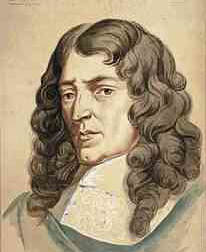 Marc-Antoine Charpentier Posthumous 18th century Source: Wikipedia |
|
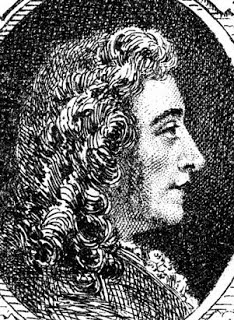 Alessandro Stradella 1680 Engraving by Louis Denis Bibliothèque Nationale de France Source: Italy On This Day |
Born on 3 July 1643
[Wikipedia],
Alessandro Stradella
was an aristocrat educated in Bologna who wrote operas, oratorios and
serenatas
(serenades). 'Webster's' has the term "serenade" originating in 1649 from
Latin "serenus" (serene). Most are familiar w the serenade as a romantic
piece performed in open air in the evening for a lover at a window as
compared to the
aubade
[c 1678 'Webster's'] performed in the morning. Stradella's serenatas were
composed for performance outdoors in the evening as well, excepting for more
elaborate orchestration. Stradella is also credited with the first
concerto grosso circa 1675, his one and only to fit the bill before the
term was first used by Aracngelo Corelli about 1681 as distinct from his
smaller
concertinos [*].
Stredella's father may have been a cavalier (knight) and governor of
Vignola when Alessandro was born. Sources vary widely on just when he arrived in Rome
from 1653 to 1654, but he is apparently on record as a singer at St.
Marcello del Crocifisso Cathedral in 1655 ['Choral Repertoire' Dennis
Shrock]. Probably beginning to study music soon, come 1658 he was a singer
in the employment of
Queen Christina
of Sweden [All Music Blair Johnston], she having given up her throne at age
28 to live in Rome from 1654 to her death in 1689. Johnston and Shrock have
Stradella writing his first composition for Christina in 1663, a motet
called 'Chare Jesu Suavissime'. Come 1669 he was composing for the new
theatre in Rome, the
Teatro Torinona [Greene].
Among other of Stradella's skills, however, was getting into trouble. The
first such occasion arrived in 1669 when a failed attempt to embezzle money
from the Church had him leaving Rome briefly, returned by 1670. A public
dispute with a cardinal in 1677 required leaving for the safety of Venice,
he not to see Rome again. Stradella was soon hired in Venice by
Doge Alvise Contarini
[*]
of the Contarini
dynasty
to tutor his mistress, Agnese Van Uffele. But Alessandro and Agnese ran off
to Turin together instead. Contarini followed where he found assistance in
the Church, Uffele forced to choose between becoming a nun or wedding
Stradella, which the pair did on 10 October 1677 [*].
"You think?" Contarini soon thought, then had Stradella assassinated, or so
he believed. Stradella survived and was in Genoa come early 1678. Uffele
disappeared after those few moments for the annals of history. In Genoa Stradella composed for the
Teatro Falcone [1,
2] and local nobility. Stradella's comic opera (opera
buffa), 'Il Trespolo tutore' [1,
2,
3],
premiered at Il Falcone in January of 1679. Come his opera, 'Doriclea',
in 1681. He is thought to have composed 'Moro
per amore' the same year, though it wasn't presented to the public until
1695, thirteen years after his death. Stradella was stabbed to death on 25
Feb 1682 at the Piazza Banchi. Once again concerning an affair, this time
the cuckold was a member of the
Lomellini family, his hitmen more successful than had been Contarini's.
Between poking where he oughtn't have and otherwise living dangerously
Stradella managed more than 300 works, including a minimum of six operas,
170 cantatas and 27 instrumental pieces. Leaving his manuscripts to an
underage son, those were sold with the assistance of a friar to Francesco II
d'Este, Duke of Modena, for 600 gold doubloons, now collected at the Estensian
Library in Modena [*].
The image to the right is easily mistaken for Stradella as it is nigh
universally done. Though the painter remains anonymous, that it is Francesco
II, not Stradella, is confirmed by similar depictions, including a
nigh identical engraving by Isabella Piccini published in 1690
[*].
Stradella was later the subject of Friedrich Wilhelm Riese's opera, 'Alessandro
Stradella', premiering at the Stadttheater in Hamburg on 30 December
1844. References: Wikipedia;
All Music; Dennis Shrock:
1,
2.
Compositions w reviews: Hyperion.
Scores: 1,
2,
3.
Audio samples: 1,
2.
Recordings of: discographies: 1,
2,
3,
4,
5;
'Alessandro Stradella: Two-Part Sinfonias' by Marcello Scandelli on
violoncello, Michele Pasotti at archlute and Alberto Sanna on violin; 'La
Doriclea' by Pomo d’Oro directed by Andrea De Carlo:
1,
2,
3.
IA. Further reading:
F. Marion Crawford;
Rupert Hughes;
Davide Mingozzi;
Jonathan Sutherland. Bibliography: 'A Possible Date for Stradella's 'Il
Trespolo Tutore'' by Carolyn Gianturco ('Music & Letters' 1979) *;
'Alessandro Stradella (1639-1682): A Thematic Catalogue of His
Compositions' by Carolyn Gianturco & Eleanor McCrickard (Pendragon Press
1991) *;
books by or about Stradella at Abe Books: 1,
2.
Other profiles 1,
2,
3.
Works below are oratorios with the exception of the serenates, 'La forza delle stelle'
and 'Qual prodigio e ch'io miri?'. Alessandro Stradella Ester Liberatrice del Popolo Hebreo 1677 Il Concento & Il Concento Chorus Ester : Silvia Piccollo Director: Luca Franco Ferrari 1678 Ensemble Mare Nostrum Andrea De Carlo C 1675 Alessandro Stradella Consort Estevan Velardi 1675 Ensemble Aurora Enrico Gatti Battista: Andrea Arrivabene Ensemble Aurora/Enrico Gatti Ensemble Aurora/Enrico Gatti Ensemble Aurora/Enrico Gatti Ensemble Aurora/Enrico Gatti |
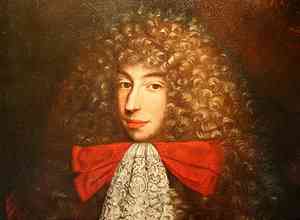 Francesco II d'Este - Duke of Modena (Not Stradella) |
| Baptized on 19 August
1648
in Arnstadt, Germany,
Johann Michael Bach
was younger brother to
Johann Christoph
(above). Of the Bach musical dynasty [1,
2,
3] he is the second of only eight addressed in this history. The
brothers never worked together, but historically they announced the
beginning of the end of Italian dominance in the baroque, that to shift to
Germany while France gave it Continental flavors. Like
Johann Cristoph, more is known about
his music than his life. As his father,
Heinrich Bach, was an organist he likely studied music including
composition as a youth. Aryeh Oron at Bach Cantatas has him replacing his
brother,
Johann Christoph, at organ at the Arnstadt castle chapel in Thuringia in
1665. In 1673 Johann Michael was employed as an organist and town clerk in
Gehren where he remained until his death. He is thought to have been a
craftsman of musical instruments such as the harpsichord, dying on 27 May
1694. References: 1,
2,
3.
Das Alt-Baschische Archiv: 1,
2.
Scores: 1,
2.
Audio: 1,
2.
Discos: 1,
2,
3.
Biblio: 'The New Grove Bach Family' by Christoph Wolff et al (W.W. Norton 1983).
HMR Project.
Johann Michael Bach Ach, wie sehnlich wart ich der Zeit Cantus Cölln/Konrad Junghänel Organ: Franciscus Volckland Vox Luminis Vox Luminis Ich weiβ, dass mein Erlöser lebt The Academic Choir/Ivan Goran Kovacic Vilnius State Choir Conducting: Linas Balandis Riverside City College Chamber Singers Conducting: John Byun Unser Leben währet siebenzig Jahr Vox Luminis
|
||
| Baptized 23 February
1649 in Westminster, London,
John Blow
is this history's first look at an English composer since Renaissance
musician,
Thomas Weelkes
(Classical
1), some seventy years prior. Blow was
of major significance to the music of England as teacher to
Henry
Purcell
at the
Chapel Royal as of 1674. Blow himself had studied music as a boy as a
chorister at the Chapel Royal as early as 1660, perhaps serving in that
capacity earlier someplace else, as that placed him in the high employ of
King Charles II. Among titles composed by him as a youth was 'Club
Anthem' of 1664 when he was fifteen, written w Pelham Humfrey and William
Turner [*].
In 1668 he succeeded Albertus Bryan as organist at Westminster Abbey [1,
2,
3,
4,
5,
6]. He was made
gentleman
at the Chapel Royal in 1673 and by 1678 he had earned a
doctorate. The degree of doctor ("teacher") had been around for
centuries, ever since the Catholic Church needed academicians to translate
Latin. Blow was succeeded at Westminster in 1679 by
Purcell. Either dismissed or
resigning, he began to concentrate on writing songs about that time. He is
thought to have composed his masque, 'Venis
and Adonis' in 1683. The masque
was something the predecessor to opera, developed in Italy in the 16th
century out of a folk tradition in which masked dancers brought gifts to
nobles on notable occasions. It eventually split into two types, the
intermedio, a great theatrical production exclusive to the court, and the
pageant, the public version. In 1685 Blow was appointed a private musician
to James II.
1687 found him choirmaster at St. Paul's Cathedral. Blow was back at Westminster in 1695 upon the
death of Purcell. He became Composer
to the Chapel Royal in 1699, a newly created title. Blow composed fourteen
Anglican services, but the anthem was the rabbit in his hat, writing more than a hundred of them.
He died on 1 October 1708 and was buried in Westminster Abbey. References:
1,
2,
3,
4,
5.
Compositions. Scores: 1,
2;
'Six
Songs'. Audio: 1,
2,
3.
Discos: 1,
2,
3,
4.
Other profiles *. John Blow 1687 Harpsichord: Patrick Chevalier Bach Collegium San Dieg Ruben Valenzuela Anthem L'Harmonie des Saisons Eric Milnes An Ode on the Death of Mr. Henry Purcell 1695 O pray for the peace of Jerusalem The Cappella Nicolai Michael Hedley Le chœur du King's College de Cambridge Masque 1683 Theatre of the Ayre Elizabeth Kenny |
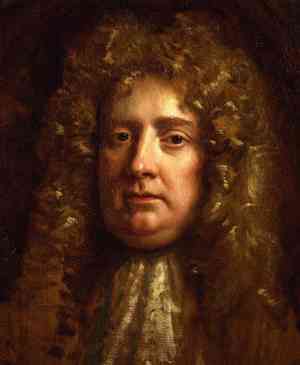 John Blow Painting: Sir Peter Lely Source: Saturday Chorale |
|
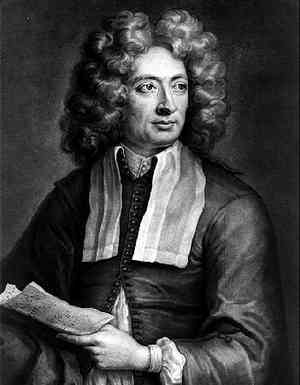 Arcangelo Corelli Source: Bach Cantatas |
Born on 17 Feb 1653
in Fusignano in the Duchy of Ferrara,
Arcangelo Corelli was born at a time when
mastery in baroque composition began its transition to northern Europe. Both
Johann Sebastian Bach and George Frideric Handel later studied his work, his
concerti grossi in particular. In the meantime Corelli's love of violin kept
Italy in the business of baroque. Leaving behind about sixty sonatas, though
his chamber works are surely notable, they are his twelve concerti grossi
which made the concerto grosso to the latter baroque what the symphony would
be to the classical period. Corelli came from a family
that had been purchasing land since the early 16th century so, though not of
nobility, the clan was prosperous. Corelli is thought to have studied in
Faenza and Luga before turning up in Bologna in 1666 at age thirteen to
pursue the violin. He became a student at the Accademia Filarmonica di
Bologna in 1670 at age seventeen [*].
He may have traveled in Germany before arriving in Rome in 1675 and visited
again on later dates, though such is more suspected than certain. Corelli enjoyed a stellar career composing and performing for
some of Italy's highest-ranking personalities, such
Queen Christina of Sweden, foremost patroness of the arts in Rome upon
her exile from Sweden at age 28 (1655). Corelli dedicated his 1681 'Op 1' of
twelve trio sonatas to Christina. He dedicated his 1685 'Op 2' of twelve
trio sonatas to
Cardinal Pamphili for whom he had first performed in 1676 and would
become employed again in 1687. His 'Op 3' of 12 more sonatas in 1689 was
dedicated to
Francesco II d'Este, Duke of Modena whom he was visiting at the time.
Francesco II had purchased the collected manuscripts of
Alessandro Stradella
upon the latter's untimely death in 1682, acquired from
Stradella's underage son. Corelli's 'Op 4' of twelve trio sonatas in
1694 was dedicated to
Cardinal Ottoboni with whom he'd become employed in 1690 upon the
Pamphili's relocation to Bologna. The twelve sonatas which make up Corelli's
'Op 5' [*]
of 1 January 1700 went to
Sophia Charlotte, Electress of Brandenburg. Corelli's last published work, 'Op 6' [*],
consisted of twelve concerti grossi composed in the early 1680s but printed
only posthumously in 1714. Corelli had died in Rome on 8 January 1713 with
considerable wealth, worth about 120,000 marks with collections of art and
fine violins. References:
1,
2,
3,
4,
5,
6,
7.
Compositions: 1,
2. Scores: CCARH:
Opp 1-6; IMSLP:
Op 1,
Op 2,
Op 3,
Op 4,
Op 5,
Op 6. Audio:
1,
2,
3;
Opp 1-4 (MIDI files). Recordings:
Op 1;
Op 4; Op 5:
1,
2,
3,
4;
Op 6; discos:
1,
2,
3,
4,
5,
6,
7,
8.
Internet Archive. Further reading:
Bruce Lamott. Bibliography: 'Arcangelo Corelli: 'New Orpheus of Our
Times' by
Peter Allsop (Oxford U Press 1999); 'Corelli and the Poetics of Violin
Music' by
Alberto Sanna. Other profiles: 1,
2,
3,
4.
See also
chamber music;
concerto grosso; sonata;
trio sonata.
Arcangelo Corelli Sonata 1694 Chatham Baroque et al Sonata 1700 Op 5 No.12 Part 1 Sonata 1700 The Trio Sonnerie Op 5 No.12 Part 2 Sonata 1700 The Trio Sonnerie Pub posthumously 1714 Europa Galante Fabio Biondi |
|
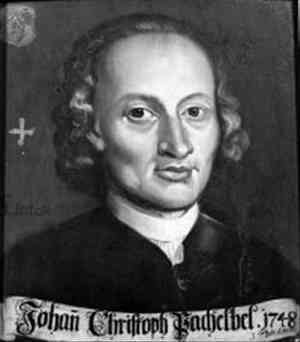 Johann Pachelbel Source: Ukulele Club |
Born 1 Sep 1653 in
Nuremberg, with
Johann
Pachelbel
Germany would approach a monopoly on the baroque period. Pachelbel received
training in his youth from composer, Heinrich Schwemmer. He matriculated
into the University of Altdorf in 1669, the same year he took a position as
organist at St. Lorenz Church. 1670 found Pachelbel at the Gymnasium
Poeticum at Regensburg with a scholarship. In 1673 he was in Vienna working
as a deputy organist at Saint Stephen's Cathedral. Nice as Habsburg Vienna
was at the time, he left for Eisenach in Habsburg Germany in 1677, there
appointed court organist to Duke Johann Georg I, also making acquaintance of
some of the Bach family). In 1678 he was employed at the Predigerkirche in
Erfurt where his association with the Bach family continued. During his
twelve years in Erfurt where he made his name he taught
Johann Christoph Bach (1671–1721, elder brother to
Johann Sebastian; not
Johann Christoph
Bach 1642-1703). Pachelbel further had Johann Christian Bach (1640-1682) for
a landlord (not Johann Christian Bach (1735-1782). Pachelbel may have composed his most famous work, 'Canon and
Gigue for 3 violins and basso continuo', at Erfurt circa 1680 [1,
2,
3; see also
canon].
In 1690 Pachelbel found patronage in Duchess Magdalena Sibylla as musician
and organist to the court of Württemberg in Stuttgart. Unfortunately, he had
to flee that position two years later. Stuttgart had already been subjected
to the horrendous Thirty Years War [1,
2,
3,
4] between France and the Habsburgs which
Johann Froberger
had survived [1,
2,
3,
4,
5]. That misery ending in 1648, now it was the Nine Years War between
France and the Grand Alliance begun in 1688 [1,
2,
3,
4,
5,
6]. Removing himself to Gotha, Pachelbel became town organist there for
a couple years, publishing the liturgical collection, 'Acht Chorale zum
Praeambulieren', in 1693. In 1695 he was invited to become organist at St.
Sebaldus Church in Nuremberg. He there published 'Musicalische Ergötzung', a
collection of chamber music, as early as 1699. He also published
'Hexachordum Apollinis' in 1699, a set of six keyboard arias. Quite active
during his latter years, Pachelbel also completed above ninety Magnificat
fugues before his death in 1706, buried on 9 March in Nuremberg. Of
Pachelbel's surviving works nigh half are chorales [1,
2].
Simply put, a chorale is the melody of a hymn. Chorales had been being
composed since the early 16th century, their impetus being the removal of
the Latin language from church music. One very famous instance of an early
chorale is Martin Luther's, 'A Mighty Fortress', written about 1528, to
which he also supplied the lyrics. A prolific composer, Pachelbel also wrote
toccatas, fantasias and suites amidst more than 530 compositions. Though
well esteemed during his lifetime, Pachelbel largely fell into neglect
thereafter, his great fame during these times occurring of renewed interest
in the 20th century. References: 1,
2,
3,
4,
5,
6,
7. Compositions: 1,
2,
3
(alt).
Scores: 1,
2,
3,
4 (w audio). Audio:
1,
2,
3,
4. Discographies: 1,
2,
3,
4,
5,
6,
7. Biblio: 'Johann Pachelbel: Organist, Teacher, Composer, A Critical
Reexamination of His Life, Works and Historical Significance' by Kathryn
Jane Welter (Harvard University 1998). Other profiles: 1,
2,
3. Per
below, of the several Pachelbel cataloguing systems [1,
2,
3] that have been derived we list only Kathryn Welter's as of 1998 (PC)
and Hideo Tsukamoto's as of 2002 (T). Johann Pachelbel 1680? PC 358 T 337 Kanon Orchestre de Chambre Jean-Francois Paillard PC 149 T 206 Organ: Helmut Wlacha PC 393 T 371 Johann Rosenmuller Ensemble Organ: Wolfgang Rubsam 1699? PC 167 T 236 Organ: Wolfgang Rübsam Organ: Daniele Tessaro |
|
| Born in Verona on 22
April 1658, violinist and violist, Giuseppe
Torelli, was brother to painter,
Felice Torelli. Among Torelli's accomplishments was the development of
the instrumental concerto alongside close rival,
Arcangelo Corelli
[*].
His youth obscure, consensus has Torelli leaving Verona for Bologna in the
early eighties, perhaps appointed maestro di cappella (master of the chapel)
at the Imola Cathedral as early as 1681. Torelli studied composition with
Giacomo Antonio
Perti before joining the Accademia Filarmonica di Bologna [musical
association: 1,
2] in 1684. He became Concert Master at the court of
George Frederick II, Margrave of Brandenburg-Ansbach, in 1698.
Well-noted for his trumpet concertos, composing more than thirty of them,
Torelli died on 8 Feb 1709. References:
1,
2,
3,
4,
5.
Compositions.
Scores.
Audio: 1,
2,
3,
4.
Recordings of: discos:
1,
2,
3,
4,
5,
6,
7,
8; 'Complete Trumpet Concertos' w Nicol Matt conducting alongside
trumpet by Peter Leiner and Thomas Hammes
*.
IA. Other profiles *.
See also: concerto grosso;
solo concerto. G numbers below are per Franz Giegling, 1949. Giuseppe Torelli Concerto for Violin in E minor Op 8:9 Collegium Musicum 90/Simon Standage Op 8:1 Koncert Orchestru Bona Nota 'Christmas Concerto' Op 8:6 Collegium Musicum 90 Concerto Grosso for Violin in F major Op 8:11 Collegium Musicum 90/Simon Standage G 23 European Chamber Soloists/Nicol Matt Trumpet: Thomas Hammes |
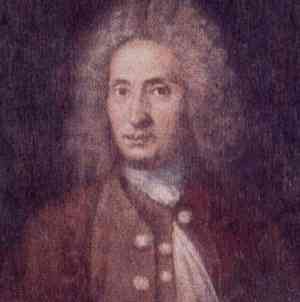 Giuseppe Torelli Source: Alchetron |
|
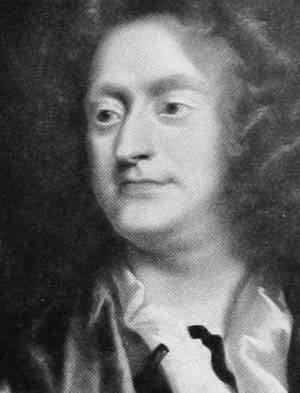 Henry Purcell Source: Wikipedia |
Born in 10 Sep 1659 in Westminster, London,
Henry Purcell
was England's major composer of the baroque, albeit we've already visited the
Lawes
brothers who implemented early baroque methods along their paths half a
century earlier. Due largely to the Reformation and situations
peculiar to being an island something segregated from continental Europe,
music in England rather kept its own pace. While early baroque
instrumentation was being developed and pursued in Italy the Brits preferred
song like airs and, especially, the madrigal. Albeit Brits kept pace with
the rest of Europe in matters of love and hate, and sex and war – which write
the history of humankind along w religion (convenient conventional face of
the spiritual), economics and technology – they yet far exceeded the rest of
Europe in literacy of the common Joe. The printing press that had been
invented by Guttenberg in Germany about 1440 didn't translate into
concern that the common people know how to read and write until Elizabeth I
(1558-1603) by whose end of reign nearly everyone in England was literate.
England also exceeded the status quo on the continent with Purcell, a prolific composer of
anthems, hymns,
catches,
odes, songs,
suites,
movements (sections),
fantasies (free form) and
sonatas
in addition to not a little else. Purcell's father (Henry Sr.) was a
musician, indeed, a gentleman of the
Chapel Royal of King Charles II
(1630-85). His father dying in 1664, Purcell was entered into the care of an
uncle, also a gentleman, who had Purcell admitted as a chorister. He thereat
began to study music and is thought to have begun composing at about age
nine. In 1673 Purcell became assistant to an organ builder. He had studied
under multiple music teachers, one of them
John Blow,
but now he was attending Westminster School, such that he became a copyist
at Westminster Abbey in 1676. In 1679 he replaced
Blow as
organist at Westminster Abbey, five of his songs appearing the same year in
John Playford's 'Choice Ayres and Songs to Sing to the Theorbo-lute or
Bass-viol' [*].
The next year ('80) he published 'Fantasias and In Nomines' [in nomines: 1,
2,
3,
4]. 1682 found him appointed to the Chapel Royal as organist, and it was
in that capacity that most his works were created until his death. Purcell
published twelve 'Sonatas of III Parts' in 1683, dedicated to Charles II [*].
His first ode to
St. Cecilia was performed in London that year on 22 Nov 1683 and
published in '84, 'Welcome to All the Pleasures' [1,
2]. A decade later he composed his sacred work, 'Te Deum and Jubilate in
D', in 1694 [scores:
1,
2]. He died the next year on 21 November 1695 and was buried in
Westminster Abbey. Purcell's widow, Frances, published numerous of his works
posthumously including 'A Collection of Ayres' [1,
2] and 'Ten Sonatas in Four Parts' [*]
in 1697 and Books I and II of 'Orpheus Britannicus' in 1698 and 1702 [*;
scores: 1,
2; text:
songs,
complete]. Z numbers for Purcell are per
Franklin Zimmerman in 'An Analytical Catalogue of His Music' published
by St. Martin's Press in 1963. See also Zimmernan's 'His Life and Times' (U
of Pennsylvania Press 1983) and 'A Guide to Research (Garland 1989).
References for Purcell encyclopedic: 1,
2,
3,
4,
5;
Wikisource:
1,
2,
3;
musical;
John Runciman.
Compositions: 1,
2,
3,
4.
Scores: 1,
2.
Audio: 1,
2,
3,
4.
Recordings of: discos: 1,
2,
3,
4,
5,
6,
7;
'Ayres & Songs from Orpheus Britannicus' Jill Feldman (soprano)
*; 'Fantasies' by Les Voix Humaines
*; 'Fantasias for the Viols' by Hesperion XX - Jordi Savall
*; 'Te Deum and Jubilate in D'
*; 'Ten Sonatas in Four Parts':
King's Consort,
Locke Consort,
London Baroque,
Retrospect Trio; 'Twelve Sonatas of Three Parts': King's Consort:
1,
2; London Baroque
*;
'Welcome to All the Pleasures': 1,
2. Usage in modern soundtracks.
Internet Archive.
Further reading: Bach Cantatas;
British Library;
CLASSIC fM.
Bibliographies: 1,
2; editions of works by Purcell: 1,
2,
3.
Other profiles encyclopedic: 1,
2.
musical: 1,
2,
3,
4,
5,
6.
Henry Purcell 1697 Z 802-811 London Baroque Opera 1688 Z 626 Ricercar Consort & Collegium Vocale Gent Philippe Pierlot First Performance 1692: London: Dorset Garden Z 629 Les Concert des Nations Jordi Savall 1682? Incomplete Z 15 Choir of Clare College Cambridge Opera 1695 Z 630 Academy of Ancient Music Opera 1691 Z 628 Les Arts Florissants/William Christie |
|
| Born in 1660
in Austria,
Johann Joseph Fux very
likely received musical instruction as a youth like most composers herein.
At age twenty he enrolled at the Jesuit university in Graz where he likely
studied music. His education w the Jesuits continued until at least 1683 at
schools elsewhere located [Kingsbury ref 2]. From 1685 to 1688 Fux was
organist at St. Moritz in Ingolstadt, Germany. He traveled to Italy for a
time before stationing himself in Vienna during the early nineties. He was
there appointed to the the court of Holy Roman Emperor
Leopold I. He is known to have traveled to Rome in 1700 to study, but
remained in service to Leopold I, then his two Habsburg successors,
Joseph I and
Charles VI, until his death on 13 Feb 1741. Fux was a popular and solid
composer during the peak of the Baroque in Austria. His major claim to fame
is the pedagogical tome, 'The Gradus Ad Parnassus' ('Steps to Mount
Parnassus') [1,
2]. Written in Latin, it was published in 1725. K numbers for Fux are
per the Ludwig von
Köchel catalogue of of 1872, the same who indexed Mozart in 1862.
References: 1,
2,
3,
4.
Scores: 1,
2,
3.
Audio: 1,
2.
Recordings of: 1,
2,
3,
4.
Internet Archive.
Bibliography: Schenker Diary.
Other profiles: 1,
2,
3.
Johann Joseph Fux 1728? K 186 Capricornus Ensemble Stuttgart Conductor & trombone: Henning Wiegräbe Soprano: Lydia Teuscher K 331 'Turcaria' Armonico Tributo Austria/Lorenz Duftschmidt K 28 Vorau Augustine Church Choir/Johann Pichler Musica Fiata/La Capella Ducale/Roland Wilson 1701 K 355 Armonico Tributo Austria/Lorenz Duftschmidt K 352 Armonico Tributo Austria/Lorenz Duftschmid |
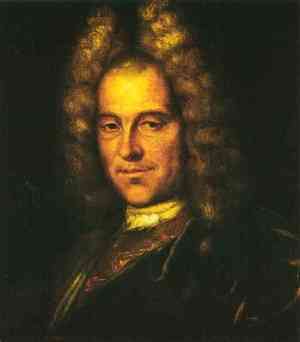 Johann Joseph Fux Source: Wikipedia |
|
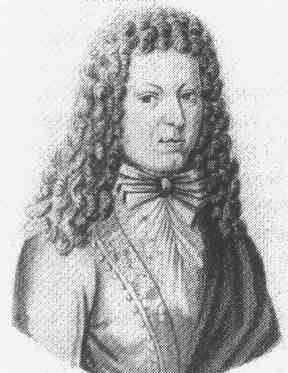 Johann Kuhnau Source: Bach Cantatas |
Born on 6 April 1660 in Geising, Bohemia, in
present-day Saxony,
Johann Kuhnau
presages the high Baroque in Germany, noted for his clavier (keyboard)
sonatas, also writing such as cantatas as an author of sacred music. Along
the the way he also translated texts from Hebrew, Greek, Latin, Italian and
French to German and wrote humorous novels. He sang at the School of the
Cross and the Church of the Holy Cross in Dresden as a child from about age
ten, there commencing his study of foreign languages along w music. He fled
the plague in Dresden at age twenty (1680), returning to Geising briefly,
then leaving to study in Zittau before enrolling at
Leipzig University
(est. 1499) in 1682 to study law. In 1684 he succeeded August Kühnel as
organist at St. Thomas Church
in Leipzig leading to a double career as both an advocate and composer. in
1688 Kuhnau
published his obscure 'Jura circa musicos ecclesiasticos'. Come
Book 1 of his clavier exercises, 'Neuir Clavier-Ubing', in 1689 followed by
Book 2 in 1692. In between arrived his comical novels of 1691, 'Musicus
curiosus, oder Battalus' ('The Inquiring Musician':
1,
2) and
'Musicus magnanimus, oder Pancalus' ('The Magnanimous Musician'
*). 'Frische Clavier Fruchte', a volume of seven sonatas, arrived in
1696 [1,
2; clavier by
Jan Katzschke]. His satirical novel, 'Der Musickalische Quacksalber' ('The Musical Charlatan'
*) saw publishing in 1700. Kuhnau's six Biblical sonatas,
'Musicalische Vorstellung einiger biblischer Historien', appeared in 1700 as well
[*; organ by Richard Apperley:
1,
2,
3].
Kuhnau had also been appointed musical director at Leipzig University in
1700. From 1701 to 1722 he was Cantor at St. Thomas Church. He was also
musical director at the
Paulinerkirche (built 1231) in Leipzig. It was upon his death on 5 June
1722 that
Johann Sebastian Bach
succeeded him at St. Thomas. It was about that time that 'Lobe den Herrn,
Meine Seele' was published [*].
Kuhnau had applied himself to a huge corpus of works numerous of which are
lost. Among other accomplishments including those lost are 'Disputatio de
Triade', 'Introductio ad Compositionem', 'Tractatus de Tetrachordo',
'Magnificat in C Major' and an opera titled 'Orpheus'. The earliest and
principle source of knowledge about Kuhnau is from Johann Mattheson's 1740
'Grundlage einer Ehrenpforte' [1,
2,
3,
4].
References: 1,
2,
3,
4,
5.
Scores: 1,
2,
3.
Audio: 1,
2,
3.
Recordings of: 1,
2,
3,
4.
Bibliography: editions of Kuhnau *;
'The Dissemination of Music in Seventeenth-century Europe' ed by Erik
Kjellberg (Peter Lang 2010) *;
'Johann Kuhnau: Sein Leben und Seine Werke' by Richard Münnich
(Breitkopf & Härtel 1902)
*;
'The Pianoforte Sonata: Its Origin and Development' by J.S. Shedlock
(Good Press 2019) *;
'The Published Works of Johann Kuhnau' by Susan Jones Bruno
*;
'Sarabande Vol 2' by Oskar Fleischer & Johannes Wolf (Breitkopf & Härtel 1901)
*.
Other profiles: 1,
2.
See also the Kuhnau Project.
Johann Kuhnau Harpsichord: Ernst Stolz Organ: John Butt Gabriel Isenberg 1705 Currende/Erik van Nevel Amsterdam Baroque Orchestra/Choir Organ/Conducting: Ton Koopmann Soprano: Deborah York Dresden Kreuzchor/Rudolf Mauersberger |
|
| Born on 2 May 1660 in
Palermo in the island kingdom of Sicily,
Alessandro Scarlatti was
father of both composer, Pietro Filippo Scarlatti [*],
and
Domenico Scarlatti,
with whom he shares equal importance to the baroque period. Among his
accomplishments are above 600 sacred and secular cantatas largely for solo
voice and continuo, about 30 chamber cantatas, 40 motets and the development
of the
Neapolitan school of opera. By "school" is meant not a literal
organization such as one of Naples' conservatories [1,
2,
3,
4], but an approach to doing things that attracted other major composers
and having a distinct affect on the greater scene in Europe. In Scarlatti's
case that meant helping put Naples on the map as a major center of the
theatrical arts to rival Rome and Venice. Scarlatti is thought to have moved
to Rome with his sister in 1672 [Trenfo]. Though there is no documentation
of such, he is said to have studied in Rome under
Giacomo Carissimi who
died in 1674. In 1678 he married and was appointed maestro di cappella at
the Church of Saint Giacomo degli Incurabili attached to San Giacomo in
Augusta. His 1679 opera, 'Gli Equivoci nell sembiante', won
him the patronage of Queen Christina of Sweden [*]
living in exile in Rome since 1654, there a foremost patroness of the arts
until her death in 1689. During that time he was also worked in association
with the Oratorio del Santissimo Crocifisso. Scarlati's position as
Christina's private maestro di cappella
was followed with another to the Viceroy of Naples, Gaspar Méndez de Haro
[*],
in 1684. Scarlatti was quite productive composing operas in that capacity
until 1702 when he was employed at Ferdinando de' Medici's [*]
private theatre near Florence. He also wrote operas while serving as maestro
di cappella for Cardinal Ottoboni [*],
as well as at the Basilica di Santa Maria Maggiore [*].
He visited Venice and Urbino before returning to Naples in 1708. 1718 found
him producing operas in Rome again, also composing his 'Messa di Santa
Cecilia' [1,
2]
in 1720. His last opera, 'Griselda' [*],
premiered at the Teatro Capranica [*]
in 1721. He may have yet been working on his serenade, 'Erminia' [*],
back in Naples when he died on 22 October 1725. References encyclopedic: 1,
2,
3,
4,
5; musical: 1,
2,
3,
4;
'Aspects of the Secular Cantata in Late Baroque Italy' by
Michael Talbot (Routledge 2017).
Operas. Scores: 1,
2,
3,
4,
5.
Audio: 1,
2,
3,
4.
Recordings of: discos: 1,
2,
3,
4,
5,
6,
7;
'Messa di Santa Cecilia' by Maurice Abravanel & the Utah Symphony
Orchestra [*].
Internet Archive. Further reading: 'Poetry and Patronage' by Kimberly
Coulter & Hale Harris
*; 'The Cantatas of Alessandro Scarlatti' by Rosalind Halton
*; 'Mapping the Musical Genome the Scarlatti Family' by Luca Casagrande
*.
Bibliography: editions of Scarlatti: 1,
2; 'Regole per ben [son]are' (217 partimenti by Scaraltti published by
Benedetto Cipriani 1754):
1,
2,
3,
4; 'Alessandro Scarlatti: His Life and Works' by Edward Joseph Dent
(Edward Arnold 1905)
*;
'The Operas of Alessandro Scarlatti' Vol I-IX (Harvard U Press 1974-85)
*.
Other profiles: 1,
2,
3,
4. See also L'Associazione Domenico Scarlatti
*. Alessandro Scarlatti Stavanger Symphony Orchestra Fabio BiondiAccademia Bizantina Otavio Dantone English Concert Choir Trevor PinnockBahamas National Youth Choir Harpsicord: Beatrice Martin Harpsichord: Christian Rieger Soprano: Gemma Bertagnolli
|
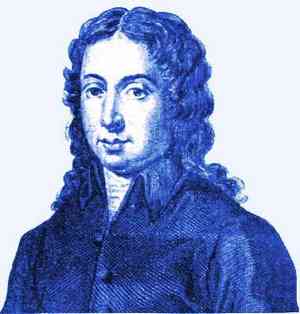 Alessandro Scarlatti Source: Baroque Music |
|
| Born in Leipzig on 14
Nov 1663,
Friedrich Wilhelm Zachow
was the son of a piper among Leipzig's town musicians and studied music as
youth. Relocating with his family to Eilenburg in 1676, he may have studied
there w town organist, Johann Hildebrand [1,
2,
3,
4]. He became
cantor and organist at the
Marktkirche in Halle in 1684. Also called Liebfrauenkirche or
Marienkirche, Zachow remained there his whole career. Though a minor
composer in the annals of music history, Zachow was initial teacher to
George Frideric Handel
until the latter became employed at age 18 in 1702. Zachow died ten years
later in Halle on 7 August 1712. References:
Bach Cantatas;
Hyeok Lee; Wikipedia:
1,
2,
3.
Editions of works:
WorldCat. Scores: 1,
2,
3.
Audio: 1,
2,
3.
Recordings of: discos: 1,
2,
3,
4;
'Christmas
Cantatas' w Constanze Backes (soprano).
HMR Project. LV (Lohmann Verzeichnis) numbers
for Zachow are per Heinz Lohmann's 1966 'Gesammelte Werke für
Tasteninstrumente'. Friedrich Wilhelm Zachow LV 34 Organ: Einer von Weitem Hab ich nur dich, mein Gott Ich mag den Himmel nicht Der Erden Stolz und Pracht hab ich schon Mein Gott, du bist mein Teil Accademia Amsterdam/Cappella Frisiae Soprano: Constanze Backes Berlin Capella Cantorum Siehe, ich bin bei euch alle Tage Das Kleine Konzert/Rheinische Kantorei Hermann Max |
||
|
Antonio Lotti
was born in Venice on 5 January 1667, though his father was Kapellmeister at
a church in Hanover, Germany. He began studying music under
Giovanni Legrenzi in 1682, first
employed as an alto singer at St. Mark's Basilica [*]
in 1689. He very gradually moved upward through organ positions until
finally becoming maestro di cappella in 1736, to die four years later on his
birthdate of Jan 5, 1740. With the exception of a couple years producing
three operas in Dresden (1717-19) Lotti remained in Venice his entire
career. Lotti composed nearly thirty operas, though his sacred works are
probably more esteemed, particularly larger
concert works for choir and
instruments including oboe, bassoon and trumpet. Those instruments are found
in secular works as well, such as serenatas and sonatas. His 'Trio Sonata in
A' was written for flute, continuo
and oboe d'amore.
Of particular note among Lotti's concert works are his
Credos
containing 'Crucifixus' motets for 4 to 10 voices. See 'Crucifixus a 8 voci' in his
'Credo in F' [*;
audio: 1,
2;
scores: 1,
2,
3]. Modern editions of Lotti's 3 and 4 voice motets and masses include the Breitkopf Thematic Catalogue
and Annie Bank. The only book Lotti published during his lifetime, 'Duetti,
terzetti, e madrigali a più voci' containing 18 works in 1705, had been
for voice with continuo [1,
2], some composed circa 1700. References:
1,
2,
3,
4,
5.
Catalogues of works: sacred: 1,
2;
secular. Editions of Lotti: 1,
2;
'Duetti, terzetti, e madrigali a più voci':
1,
2.
Scores: 1,
2,
3.
Audio: 1,
2,
3,
4,
5.
Discos: 1,
2,
3,
4,
5,
6.
Internet Archive. Further reading: 'The Sacred Music of Antonio Lotti'
Benjamin Byram-Wigfield (Open University 2016) *.
Other profiles: 1,
2,
3,
4.
Antonio Lotti Marta Guassardo Matthew Curtis Le Macadam Ensemble Madrigal Il Complesso Barocco/Alan CurtisSopranos: Elena Cecchi Fedi & Roberta Invernizzi Balthasar Neumann Ensamble Thomas Hengelbrock Lotti Chamber Choir Allegro Gan Eden Ensemble |
||
| Born in Paris on 10 Nov 1668,
François Couperin
(Francois the Grand or Great) takes up the Baroque in France a generation or
so after
Jean-Baptiste Lully.
As a unit of the Couperin musical
dynasty, Francois was nephew to
Louis Couperin, brother of his father, Charles, organist at the Catholic
Church of Saint-Gervais-Saint-Protais [*]
until his death when Francois was age ten. Couperin became organist at the
same church in 1685-86 when he was 17-18 years old. While there he published
'Pièces d'Orgue' in 1690, that containing two masses, 'Messe pour les
Paroisses' (for parishes) and 'Messe pour les Couvents' (for convents) [*].
In 1693 Couperin became organist of the
Chapelle Royale under
King Louis XIV
(aka le Roi Soleil or Sun King). Among the duties of the Chapelle Royale was
to give weekly concerts to the court, oft on Sundays, Couperin said to be
virtuosic on such occasions with several instruments. The first book he
published while employed to Louis was 'Premiere livre de pièces de clavecin'
consisting of Ordres 1 to 5 in 1713 [*].
'Second livre de pièces de clavecin' consisting of Ordres 6 to 12 appeared
in 1716-17 [*].
Included in the latter book as Ordre 10:6 is a rondeau in D major titled
'Les Bagatéles' ('The Trifles'). The first known
bagatelle appeared in
1692 as No. 6 of 'Suite à 3 in C major' (Suite 1) by
Marin Marais
[1,
2,
3,
4]. Publishing several books of harpsichord music to as late as 1730,
Couperin is well-known for his manual, 'L'art de toucher le clavecin' ('The
Art of Harpsichord Playing'), issued in 1716 [1,
2,
3,
4]. Among the more influential composers to later musicians, Couperin
died in Paris on 11 Sep 1733. His image to the right is a posthumous
engraving by Jean Jacques Flipart in 1735 after an earlier painting by André
Bouys. References encyclopedic: 1,
2,
3;
musical: 1,
2,
3,
4,
5.
Compositions. Scores: 1,
2,
3,
4.
Audio: 1,
2,
3,
4
(MIDI files),
5.
Discos: 1,
2,
3,
4,
5.
Bibliography: editions of Couperin at
Abe Books;
'Couperin, François (1668–1733)' by
G.T. Kurian;
WorldCat.
Other profiles: 1,
2,
3,
4.
François Couperin Comp 1714 Pub 1722 Le Concert Des Nations/Jordi Savall Monique Zanetti/Michael Laplénie Direction: Bernard Coudurier 1713 Ordre 1 of 5 Harpsichord: Roc Vela 1730 Ordre 25 of 20-27 Harpsichord: Riho Noma 1726 La françoise Suite 1 of 4 Flute: Sebastian Wittiber Oboe: José Luis Garcia Vegara 1716 Les Bagatelles Ordre 10.6 Harpsichord: Davitt Moroney 1722 Ordre 18 of 13-19 Harpsichord: QinYing Tan |
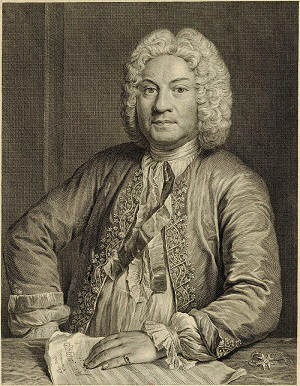 Francois Couperin Source: Wikimedia Commons |
|
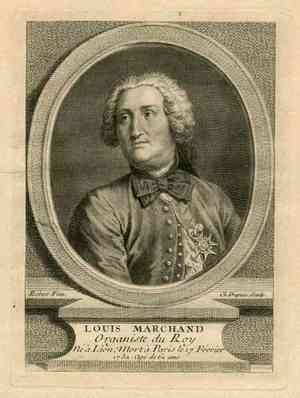 Louis Marchand Source: Gallica |
Born in Lyon on 2 Feb
1669, Louis
Marchand
arrived to Earth of a musical family, his grandfather a music teacher, his
father an organist who also refurbished them. Marchand's family moved to
Nevers in 1684. Accounts differing, Marchand may or may not have become
organist at Nevers Cathedral at age fourteen. He was living in Paris by the
time he was twenty, there to obtain employment at the Church of Eglise
Saint-Jacques (Church of Saint-Jacques du Haut-Pas), documented in a
marriage contract of 1689 to one Marie Angelique Denis, daughter of an organ
builder [Wikipedia; some sources don't have him at Saint-Jacques until
1691]. Marchand would work at numerous churches in Paris throughout his
career including the Church of St. Honoree [*]
from 1703 to 1707. Prior to that he is thought to have published Book 1 of
his 'Pièces de Clavecin' in 1699 [1,
2]. That was republished in 1702 by Christophe Ballard along with Book 2
of 'Pièces de Clavecin' [IMSLP:
1,
2; digital copies:
1,
2]. One date that holds true in all sources during that period is 1701,
the year Marie Angelique divorced him for beating her and spent the next
several years putting claim to half his earnings. She apparently acquired
the assistance of
King Louis XIV (Sun King) who agreed, leading to the anecdote that
during the performance of a mass at the Royal Chapel at Versailles, there
appointed to organ in 1708, he stopped halfway through, explaining to Louis
that since his wife received half his salary she may finish the mass.
Marchand's virtuosic abilities seemed to win him grace from various
unpleasant behaviors. Howsoever, it was during Marchand's time w Louis that
the latter completed the fifth rebuilding of the Royal Chapel in 1710 [1,
2,
3]. Marchand took his work on a concert tour of Germany between 1713 and
1717, during which time Louis XIV died in 1715, succeeded by Louis XV. Marchand's return to France is said to have been hastened by a scheduled keyboard contest w JS Bach
in Dresden in September of 1717 [1,
2]. The story circulates that he left Dresden the morning of the
scheduled duel due to fear that Bach would outperform him. That account originating in Germany differs
from others which relate other reasons for missing his appointment w Bach. Either way, it remaining unknown how he compared to Bach, Marchand returned to his position as organist at
the
Cordeliers Convent in Paris where he remained, also teaching for an
income, until his death on 17 Feb 1732. Évrard Titon du Tillet's 'Le
Parnasse Francois' was published later that year in which he included his
contemporaneous biography of Marchand. In the portrait to the left Marchand
wears a powdered wig (peruke, periwig), such coming into fashion about 1655
when Louis XIV, a king Baroque if ever one was (Louis XV the poster child of
Rococo), began the fad to hide hair loss. It quickly came into fashion
whether one was bald or not and prevailed throughout the eighteenth century
until it began to fade from style by the nineteenth. References: 1,
2,
3,
4,
5,
6.
Editions of Marchand: 'Pièces d'Orgue' Book IV (<1729):
1,
2; 'Pièces Choisies pour l'Orgue' Livre premiere: ('Plein Jeu') François
Boivin (1732?)
*;
Mme. Boivin (M. de Brotonne 1740 Bibliothèque Nationale de France):
1,
2; Pierre Gouin (Les Éditions Outremontaises 2012)
*;
'Traité de Contrepoint Simple' Richard Briflot (Bar-le-Duc 1739):
1,
2;
WorldCat.
Compositions.
Scores: 1,
2.
Audio: 1,
2,
3.
Recordings of: discos: 1,
2,
3; 'Pièces de clavecin 1702' by
Blandine Verlet (harpsichord). Bibliography: 'A Forgotten Virtuoso'
Geoffrey B. Sharp ('The Musical Times' 1969)
*; 'Le Parnasse Francois' by Évrard Titon du Tillet (1732):
1,
2
(fascimile); 'Quarterly Magazine of the International Musical Society' Vol 6
(Breitkopf & Härtel 1905)
*; 'Zeitschrift' Vol 6 International Musical Society (Breitkopf & Härtel
1904) *. See also:
1,
2; Mademoiselle Boivin (Elisabeth-Catherine Ballard): *;
HMR Project.
Louis Marchand Book 1: Suite in D Minor Pub 1699 Harpsichord: Ketil Haugsand Book 2: Suite in G Minor Pub 1702 Harpsichord: Ketil Haugsand Book 1 Comp c 1700 Pub 1732 or 1740 Organ: Michel Chapuis Book 1 No.11: Fond d'Orgue Organ: Luca Raggi Book 3: Grand Dialogue Comp 1696 Organista: Davide Paleari |
|
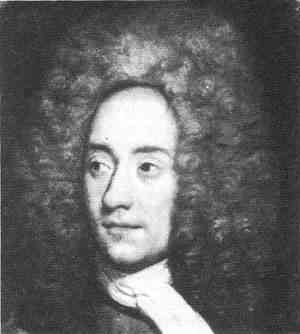 Tomaso Albinoni Source: Edition HH |
Born on 6 June 1671
in Venice,
Tomaso Giovanni Albinoni
was born to a prosperous but not inexhaustibly rich paper merchant. He likely studied singing and violin
while young, but not a lot is known about him with the exception that he
emerged into the world as a self-described dilettante. In medieval Europe the two main forces behind music,
largely in France, had been the Catholic Church (sacred in association with
Notre Dame) and troubadours seeking the patronage of royalty
(secular). The secular aspect behind the Renaissance, albeit involving gods, was its humanistic
reawakening of the ancient classical, as in matters Greek. By Albinoni's
time there had emerged a merchant class which neither Church nor monarch
could brush off anymore. In those ranks arrived the independently wealthy
who needed not work, a station once reserved for land-owning aristocrats. Of that class came the
dilettante, that is, one whose delight or devotion was the arts. Among the greatest examples of a
dilettante dedicated to culture lived over in Rome at the time of Albinoni's birth, the exiled
Queen of Sweden, Christina, a foremost patroness of the arts who surrounded
herself with them. Albinoni presented himself as a dilettante to distinguish
himself from professionals who worked at music for a living. Though Albinoni's family industry
of stationers was small change compared to Christina, it could support Albinoni's
musical proclivities if need to as late as 1721 when old debts put it out of
business. By that time Albinoni had long since
been pocketing profits from books and the staging of operas. Albioni dedicated his Opus 1, 'Sonate a Tres', to Cardinal
Pietro Ottoboni in 1694. He produced his first opera in 1694 as well:
'Zenobia'. The next several years saw the increase of his popularity
throughout Italy as he traveled to stage his productions. His Op 2.
'Sinfonie e Concerti a Cinque', appeared in 1700 dedicated to Charles IV,
Duke of Mantua. Op 3, 'Balletti a Tre', arrived the next year in dedication
to Cosimo III de' Medici, Grand Duke of Tuscany. Albinoni later directed a
couple operas in Munich for Maximilian II Emanuel, Elector of Bavaria.
Albinoni's ten opuses were ten published books,
nine of instrumental works, one for solo voice with continuo. Albinoni died in Venice on 17 Jan of 1751 of diabetes. Albinoni highlights
the role of Venice during the Baroque due largely to vocal operas and
cantatas, though his vocal works are not so esteemed as his instrumentals
including sinfonias, concerti, balletti and sonatas. Music for chamber
(camera) described one instrument or voice with continuo. Big name contemporaries of his were such as
Lotti and Vivaldi,
insuring that Baroque wouldn't be a European spectacle minus Venice,
maintaining its position as a cultural center acquired during the Renaissance. A main source of knowledge about Albinoni had been handwritten manuscripts held at the Dresden State Library
until they were destroyed during the World War II bombing of Dresden.
References: 1,
2,
3,
4.
Compositions: 1,
2.
Scores: 1,
2.
Audio: 1,
2,
3,
4,
5.
Discos: 1,
2,
3.
Bibliography: editions of Albioni:
1,
2;
'A History of Baroque Music' by George Buelow (Indiana U Press 2004);
Oxford U Press.
Other profiles: 1,
2,
3,
4. The serenata, below, is a kind of cantata. Tomaso Giovanni Albinoni 1735 Op 10 I Musici Roberto Michelucci 1715 Op 7 Berlin Chamber Orchestra 1722 Op 9 The Academy of Ancient Music Christopher Hogwood First performed 1729 Serenata a tre voci Ensemble Strumentale Albalonga Annibale Centrangolo 1700 Op 2 Rome Instrumental Ensemble/Giorgio Sasso |
|
| Born in Thal near
Eisenach, Germany, on 14 Feb 1677,
Johann Ludwig Bach
is among numerous reasons that "Baroque" and "Bach" are nigh synonymous. Johann
Ludwig was third cousin to
Johann Sebastian Bach
of the Bach musical dynasty [1,
2,
3]. He left Eisenach for Meiningen at age 22 where he became a court musician to
Prince Bernhard I. He there gradually became kapellmeister which position he
kept throughout his career. It is in Meiningen that he composed the 39 works
found in the Johann-Ludwig-Bach-Verzeichnis called the "JLB" catalogue
[1,
2,
3]. Ludwig's works were early confused to be by J.S. Bach as found among
the latter's manuscripts. It isn't known that Johann Ludwig published any works
and no compositions properly ascribed to him saw light until the mid
nineteenth century per sixteen of his cantatas in Johann Theodor Mosewius' 1852 'Johann Sebastian Bach's Matthäus-Passion',
that a correction of titles that he mistakenly ascribed to Sebastian in a
publication of 1845 [*].
The JLB catalogue begins with 17 cantatas edited by Alfred Dorfel in the 41st volume of
'Bach-Gesellschaft Ausgabe' published by the Bach Gesellschaft in 1894.
Ludwig wrote numerous other works not found in the JLB such as his 'Missa in G Major'
catalogued as BWV Anh 167. (BWV
numbers assigned to J.S. Bach are per Wolfgang Schmieder's 'Bach-Werke-Verzeichnis'
first published in 1950. "Anh" (anhang) designates spurious
additions to the catalogue such as lost, doubtful or determined, since then, to
belong to another composer, like Johann Ludwig. "BNB" designations in the BWV
describe works copied by Sebastian for his own purposes.) The
Johann-Ludwig-Bach-Verzeichnis begins with 'Gott ist unser Zuversicht' as
JBL 1 per Dorfel (1894) from earlier Mosewius (1852). Titles include such as 'Denn
du wirst meine Seele nicht in der Hölle lassen' JLB 21 composed in 1704,
'Mache dich auf, werde licht' JLB 9 composed in 1711 and 'Allein Gott in der
Höh sei ehr' JLB 38 composed in 1716, that a version of the eponymous
Lutheran hymn by Nikolaus Decius in 1523. Johann Ludwig died on 1 May 1731
among the more obscure of the Bachs, though deemed a sufficient enough
composer for Johann Sebastian to transcribe and employ his works among his
own.
References: 1,
2,
3,
4.
Compositions: 'Denn du wirst meine Seele nicht in der Hölle lassen':
1,
2,
3;
'Missa in G Major'
BWV Anh 167 ('Messa a 8 voci reali e 4 ripiene').
Scores: 1,
2,
3.
Editions of JL Bach: 'Denn du wirst meine Seele nicht in der Hölle lassen' 1852:
1,
2;
'Messa a 8 voci reali e 4 ripiene coll'accompagnamento di due orchestre' in G major (Breitkopf e Härtel 1805):
1,
2.
Audio: 1,
2,
3,
3.
Discographies: 1,
2,
3.
Other profiles: HMR Project. Johann Ludwig Bach JLB 38 1716 Ex Tempore/Florian Heyerick JLB 28 Choir of Clare College Timothy Brown Mache dich auf, werde Licht (Arise, Shine) JLB 9 1711 Camerata Düren/Peter-JC Eich JLB 33 Budafoki William Byrd Énekegyüttes |
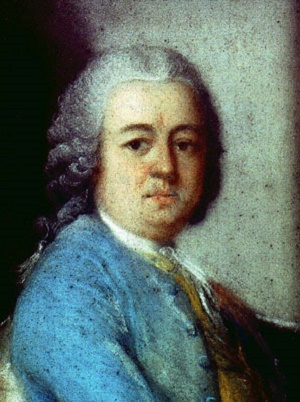 Johann Ludwig Bach Source: Wikimedia Commons |
|
| Born on 4 March 1678
in Venice (then a republic apart from Italy),
Antonio Vivaldi was Italy's
Baroque supernova. He composed a galaxy of concertos, as well as sinfonias,
sonatas and above 50 identifiable operas. Giovanni's father had been a barber
turned professional musician with whom Vivaldi publicly performed as a
child. Early records find Vivaldi the maestro di violino at the Ospedale
della Pietà at age 25, an esteemed orphanage and music school where
Johann Rosenmüller
had taught about twenty years earlier. He was ordained a priest the next
year in 1703, acquiring the nickname of "The Red Priest" due that he (and
his family) was a flaming redhead. Though Vivaldi remained a priest, it's
thought he withdrew from the duties of that station due to severe asthma.
Vivaldi remained at the
Ospedale della Pietà more than thirty years, eventually being appointed
maestro de concerti in 1716. He wrote his most famous work, 'The Four
Seasons' ('Le quattro stagioni'), about 1716-17. Those were the first four
of twelve concertos titled 'The Contest between Harmony and Invention' ('Il
cimento dell'armonia e dell'inventione'), eventually published in 1725 as Op 8 [1,
2,
3;
sonnets by Vivaldi for voice]. Vivaldi exchanged Venice for Mantua in
1718, employed as maestro di cappella by Mantua's governor, Philip of
Hesse-Darmstadt. Between 1721 and 1725 he worked in Milan and Rome before
returning to Venice. By that time Vivaldi's reputation throughout Europe was
shimmering. He had performed for Pope Benedict XIII in Rome and now, 1728,
he was knighted by Holy Roman Emperor,
Charles VI. In 1730 Vivaldi journeyed to Prague with his father. Soon
returned to Venice, he there spent nigh the next decade until moving to
Vienna for unclear reasons in 1740. Unfortunately, shortly upon arriving to
Vienna his protector, Charles, died, leaving him both broke and among that
unique group of humans whose genius wasn't financial savvy, as Vivaldi died
in poverty on 28 July 1741. Vivaldi had composed 46 operas written for both
court and public. (The first opera is generally credited to
Jacopo Peri as of 1597.
Opera moved from entertainment exclusively for aristocrats forty years
later, the first public opera house, the Teatro San Cassiano, opening for
business in 1637 in Venice.) Of Vivaldi's more than 500 concertos, 230 were
for violin, the remainder other instruments. His sonatas number around
ninety. References encyclopedic: 1,
2,
3;
didactic
*; musical: 1,
2,
3.
Compositions:
Opus/RV; multiple catalogues cross-referenced:
1,
2.
Operas. Scores: 1,
2,
3,
4.
Audio: 1,
2,
3,
4,
5,
6; BBC:
1,
2. Recordings of: discos:
1,
2,
3,
4,
5,
6;
'The Four Seasons' Op 8:
Louis Kaufman (violin);
Nemanja Radulović (violin);
Jean-Pierre Rampal (flute);
Red Priest;
Arnie Roth (violin);
Vladimir Spivakov (violin);
Venice Harp Quartet. Vivaldi in modern soundtracks. Further reading:
Project Anima Veneziana;
music publishing in Baroque Europe;
Vivaldi. Bibliographies: books by and about Vivaldi:
international,
UK,
US; 'Vivaldi: The Four Seasons' by Paul Everett (Cambridge U Press 1996)
*; 'Antonio Vivaldi: The Red Priest of Venice' by Karl Heller (Hal
Leonard Corporation 1997)
*; 'Vivaldi: Voice of the Baroque' H.C. Robbins Landon (U of Chicago
Press 1996)
*;
Oxford. Other profiles: 1,
2,
3,
4,
5,
6,
7.
RV numbers below are per Danish Vivaldi scholar,
Peter Ryom. Antonio Vivaldi Opera RV 703 Europa Galant/Fabio Biondi Concerto in A Minor for Two Violins Pub 1711 RV 522 Violin l: Aisslinn Nosky Violin r: Fiona Hughes Pub 1729 RV 277 Op 11 No 2 New York Baroque Incorporated Violin: Monica Huggett Concerto Op 8 No. 1: La primavera Pub 1725 RV 269 Baroque Festival Orchestra Violin: Alexander Pervomansky Concerto Op 8 No. 2: L'estate Pub 1725 RV 315 Penn State Baroque Ensemble Violin: Aisslinn Nosky Concerto Op 8 No. 2: L'estate Pub 1725 RV 315 Royal Liverpool Philharmonic OrchestraViolin: Mari Silje Samuelsen Concerto Op 8 No. 3: L'autunno Pub 1725 RV 293 Bremer BarocorchesterViolin: Mari Silje Samuelsen Concerto Op 8 No. 4: L'inverno Pub 1725 RV 297 Voices of Music Violin: Cynthia Miller Freivogel Concerto for Oboe Op 8 No. 9 Pub 1725 RV 454Orchestra Barocca Zefiro Oboe: Alfredo Bernardini Op 4 Pub 171612 concertos for violin L'Arte dell'Arco Violin: Federico Guglielmo See * |
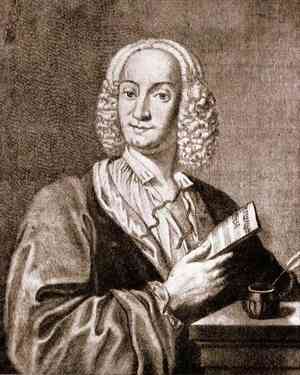 Antonio Vivaldi Engraving: François Morellon la Cave Source: Bach Cantatas |
|
| Born on 16 Oct 1679
in Louňovice pod Blaníkem, Bohemia (now Czech Republic),
Jan Dismas Zelenka
was among the more extraordinary of Baroque composers, hailing from an area
of Europe hit especially hard during the Thirty Years War [1,
2,
3,
4]
that ceased in 1648 with the Peace of Westphalia [1,
2,
3,
4,
5,
6,
7,
8,
9]. Born thirty years into the rebuilding of Prague, Zelenka was to let
Europe know that Czech music was not only arriving, but in an especially
powerful way. His father was an organist and school teacher. Zelenka was
later taught music at the Clementinum, a Jesuit college in Prague. His
instrument the bass viol, Zelenka's first compositions were oratorios
written while attending that school. He was employed by one Baron von Hartig
in Prague before joining the Dresden royal orchestra in 1710. He played the
double bass and earned 300 thalers a year, a solid middle class income at
the time. With the exception of a trip to Italy, and later Prague, Zelenka
remained in Dresden throughout his life. He passed away on 23 Dec 1745 of
dropsy. Notable Czech composing during the Baroque was largely sacred. Opera
hadn't been the phenomenon in Bohemia as it had been in the rest of Europe.
Zelenka was no different, his contribution to the Baroque arising from out
of the parameters of Catholic deployment, yet hardly unaware of his more
secular contemporaries while challenging the limits of church music. Zelenka
was and remains an indisputable master of counterpoint and harmony as
Bohemia's version of his close contemporary,
Johann Sebastian Bach,
in Germany. His known works number 249, including thirteen litanies and more then twenty masses. References: 1,
2,
3,
4,
5.
Compositions: 1,
2,
3,
4,
5.
Scores: 1,
2.
Editions of Zelenka:
Abe Books; 'Missa Gratias agimus tibi' ZWV 13 1730 (Carus-Verlag 1983 Stuttgart)
IA
(Internet Archive). Audio: 1,
2,
3,
4,
5,
6,
7,
8 (MIDI files).
Recordings of: discos 1,
2,
3; w
reviews.
Discussion. Further reading: 'Reflections and recent findings on the life and music of Jan Dismas Zelenka' ed by
Jirí Kroupa (Clavibus Unitis 4' Association for Central European Studies
2015) (alt);
'The “Czech Bach”' by
Robert Reilly; w photos of extraordinary Baroque
church interiors. Biblio: 'Jan Dismas Zelenka: seine geistlichen
italienischen Oratorien' by Susanne Oschmann (Schott 1986); 'Jan Dismas
Zelenka: A Bohemian Musician at the Court of Dresden'
Janice Stockigt (Oxford U Press 2000);
numerous. Other profiles:
*. ZWV numbers below are per Wolfgang Reich, 1985. Jan Dismas Zelenka ZWV 152 'Salus Infirmorum' 1744 Tafelmusik Choir/Kammerchor Stuttgart ZWV 155 1727 Ensemble Inégal/Adam Viktora ZWV 20 1740-41 Collegium Vocale Ghent Freiburg Baroque Orchestra ZWV 21 Collegium 1704/Václav Luks ZWV 17 1736 Musica Florea/Marek Štryncl Soprano: Anna Hlavenková ZWV 18 1739 Kamerchor Stuttgart/Barockorchester StuttgartFrieder Bernius Te Deum in D major for two choirs ZWV 146 1731 Collegium 1704/Václav Luks Sopranos: Hana Blazikova & Dora Pavlikova ZWV 61 Sacred cantata 1730 Ensemble Inégal |
||
| Born on 24 March 1681 in Magdeburg, Germany,
Georg Philipp Telemann
somewhat exists in the background to J.S. Bach
who more hogs the show, but he joins his close contemporary in taking
baroque to its apex in Germany.
Telemann is thought to have begun singing, playing organ and composing at
age ten. He'd written an opera, 'Sigismundus', at twelve. He also studied
music theory and notation about that time, in addition to composing for
choirs and town musicians. Telemann had been a law student at the University
of Leipzig when he decided to switch to music. This is said to be due that a
fellow student discovered a composition by Telemann, a setting for 'Psalm 6',
which was then performed. The impressed mayor of Leipzig then commissioned
Telemann to compose for the city's two main churches, St. Nicholas and St.
Thomas. Now with a career, Telemann formed a collegium musicum (college
musical society) of about forty members with which he gave public
performances. In 1702 Telemann was appointed director of the Opernhaus auf
dem Brühl where he also employed college musicians for opera. In 1705
Telemann became kapellmeister for the court of Count Erdmann II of Promnitz
in Sorau (now Żary, in Poland). He wrote more than 200 overtures during this
period even as it was disrupted by the Great Northern War. In 1708 Teleman entered into the service of Duke Johann Wilhelm of Saxe-Eisenach,
whence he became kapellmeister in 1709. In 1712 Telemann became musical
director for the city of Frankfurt and kapellmeister at the Barfüsserkirche,
also composing for St. Catherine's. Telemann started publishing his works in
1715, two years prior to becoming kapellmeister for the city of Eisenach. In
1721 he is found working at the Gelehrtenschule des Johanneums in Hamburg,
also appointed musical director of that city's five main churches. Between
1725 and 1740 Telemann published more than forty books which found their way
throughout Europe. Unfortunately, Telemann's second wife, Catherine, as of
1714 (his first, Amalie, had died in 1711), was a gambler who nearly drove
him to bankruptcy but for the financial assistance of friends. The couple
finally separated in 1736. The next year he left Hamburg for Paris where he
concentrated on publishing the 'Nouveaux quatuors' that year [the
Paris quartets;
IMSLP;
audio; the
Quadro Amsterdam]. Returning to Hamburg in 1738, Telemann's great burst
of the last few decades began losing fuel. Though he continued composing
until his death in Hamburg on 26 June 1767 (outliving the death of his
eldest son by twelve years), as Telemann aged his last couple decades or so
were spent at a more relaxing pace. Telemann composed an astronomical amount
of work, more than 3000 pieces, much relatively complex, which made his a
household name throughout high Baroque Europe. His early grooming for law may have contributed to Telemann
being an early instance of intellectual rights, he pursuing exclusivity of
rights to publish his work upon discovering unauthorized books of his music
being published in Paris during his stay there in 1737. Amidst Telemann's
oeuvre are concerti, overtures, above 1000 cantatas and 600 suites. His
first opera, 'Narcissus' TWV 21.5, appeared in 1701 w libretto by Johann
Christian Rau after Apostolo Zeno. Though Telemann may have composed more
than fifty operas Wikipedia lists only 33 w known premiere years, the last
given as 'Don Quichotte auf der Hochzeit des Comacho' or 'Don Quixotte, der
Löwenritter' TWV 21.32 in 1761 w libretto by Daniel Schiebeler [*].
Among Telemann's more significant works are his settings for the Passion [of
Jesus in
church music]. The Passion in church services amounts to the reading of
an account of the Crucifixion [1,
2] from one of the four
Gospels during Holy Week. Originating as early as the fourth century, it
began to be intoned by at least the eighth. By the 16th century the Passion
had become an important musical element in church services, eventually
coalescing with the oratorio [1,
2].
Telemann composed both Passions
liturgical (herein w cap) and passions as
oratorios
(herein no cap). Of the latter, his initial premiered in 1716 as 'Der für
die Sünde der Welt gemarterte und sterbende Jesus' TWV 5.1 with libretto by Barthold Heinrich
Brockes. His last of six arrived in 1763 as 'Schmücke dich, o liebe
Seele' TWV 5.2 w libretto by himself. Wikipedia commences its list of liturgical
Passions w his first for Matthew, 'Wenn meine Sünd' mich kränken' TWV 5.7,
in 1722. Forty are traced to as late as 1767 per a Passion from Mark,
'Christe du Lamm Gottes' TWV 5.52. Other of Telemann's notable works
were his fantasias w 'Fantasias pour le Clavessin' (harpsichord) TWV 33 of
1732-33 his most cited [audio;
scores:
1,
2.
3].
References for Telemann: 1,
2,
3,
4,
5,
6.
Compositions: 1,
2
(alt);
operas;
P(p)assions;
TWV.
Scores: 1,
2,
3,
4.
Editions of Telemann: 1,
2;
P(p)assions.
Audio: 1,
2,
3,
4,
5,
6.
Discographies: 1,
2,
3,
4.
Further reading: Classic Cat;
Habsburger Verlag.
Bibliography: 1,
2.
Other profiles: 1,
2. Per below, the
chalumeau was predecessor to the clarinet [*].
TWV numbering is from the 'Telemann-Werke-Verzeichnis' [1,
2] of Martin Ruhnke. Georg Telemann TWV 52:C1 For 2 Chalumeaux and 2 Bassoons La Stagione Orchestra Concerto for 2 violins & bassoon 1740? TWV 53:D4 D major Collegium Musicum 90 Concerto for 3 violins in F major 1733 TWV 53:F1 Musica Amphion/Pieter-Jan Belder Concerto for 4 Violins in D major TWV 40:202 Musica Antiqua Koln/Reinhard Goebel Concerto for 4 Violins in G major TWV 40:201 Chamber Orchestra of St. Petersburg Director: Lev Shinder TWV 51:G3 English Chamber OrchestraOboe: Thomas Indermühle Concerto for Recorder and Flute TWV 52:E1 Flute: Karl-Heinz Passin Recorder: Reiner Gebauer TWV 54:F1 Trumpet: Ludwig Güttler 1767 TWV 50:23 Música Antiqua Köln/Reinhard Goebel TWV 51:E1 Oboe: Heinz Holliger |
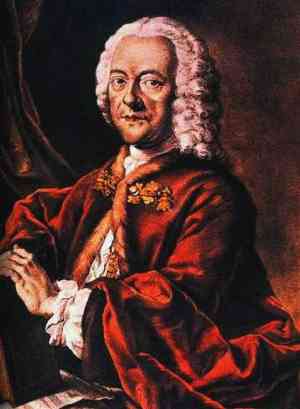 Georg Telemann Aquatint: Valentin Daniel Preisler Source: Wikimedia Commons |
|
| Born on 28 Sep 1681 in Hamburg,
Johann
Mattheson was a multi-faceted
talent whose father was a tax collector. Mattheson began appearing in female
opera roles in 1696. He began singing tenor upon his voice changing. He
eventually began conducting rehearsals and composing until becoming cantor
at
St. Mary's Cathedral in 1715. He left that position in 1728 due to
increasing deafness. Fluent in English, Mattheson then served as a diplomat,
often sailing abroad. He combined that with tutoring for the duration of his
life, though not without writing 88 books (biographies, music theory,
treatises, etc.) relevant to which Mattheson is considered by some to be the
original music critic, a distinction he shares with
Jean-Jacques Rousseau.
His first published work was the satire, 'Das neueröffnete Orchestre', in 1713 [facsimile].
Like other composers he was buried in a church, St. Michael's in Hamburg,
upon his death on 17 April 1764. References: 1,
2,
3.
Scores. Audio: 1,
2,
3.
Discographies: 1,
2,
3.
Biblio: editions of Mattheson:
facsimiles; print: 1,
2,
3;
'Mattheson, Johann'
George Buelow. Other profiles
1,
2. It was during Mattheson's lifetime that
the piano
was invented. At first called the fortepiano [1,
2,
3,
4],
Medici documents indicate its arrival in 1700, that would be due
to a harpsichord builder named Bartolomeo Cristofori [1,
2] who was Keeper of the Instruments for Grand Prince Ferdinando de'
Medici of Tuscany. Three pianos that Cristofori made in the 1720s yet exist.
Cristofori's piano, however, was too crude to become immediately popular.
Not until 1725 did Mattheson translate a 1711 critique of Cristofori's pianoforte by Scipione Maffei (who named it), which article in Mattheson's periodical, 'Musica Critica', was a likely catalyst provoking the instrument's improvement in Germany by organ builder, Gottfried Silbermann, who began building pianos in the thirties. Receiving the approval of J.S. Bach, denied to Cristofori's instrument, though Bach continued composing for harpsichord his promotion of Silbermann's instrument led to improvements such that by 1800 the piano was well along its way to replacing the harpsichord. The first composition written specifically for pianoforte is identified as Lodovico Giustini's 1732 'Sonate da cimbalo di piano e forte' Op 1. The first major composer thought to have composed for pianoforte is Domenico Scarlatti for the Queen of Spain who owned five Cristofori pianos. Johann Mattheson Aka 'Harmonisches Denckmahl' 1714 Piano: Fabiomassimo Castelluzzo Berlin Philharmonic Tenor: Manfred Schmidt 2nd of 12 sonatas 1720 Trio Corelli From 'Die unglückselige Cleopatra' Opera Premiere 1704 Tafelmusik Baroque Orchestra Soprano: Isabel Bayrakdarian No. 5 of Suite No.11 in C major No later than 1714 René Sanhueza Gaete Matthew Leese |
 Johann Mattheson Engraving: Johann Jacob Haid Source: Academic |
|
|
Christoph Graupner was
born on 13 Jan 1683 in Hartmannsdorf, Germany. James Reel at All Music has
him studying singing with organist, Nikolaus Kuster, as early as age eight.
He attended the University of Leipzig to study law first, then music, before
joining the orchestra of the Hamburg Opera in 1705 to play harpsichord.
Young
Georg Handel
played violin in that orchestra at that time as well. Come Graupner's first
opera of about ten in 1707, his 'Dido, Konigin von Carthago' [Wikipedia]. In
1709 Graupner left for the court of
Hesse-Darmstadt, becoming hofkapellmeister in 1711. He there worked
until going blind in 1754, in the meanwhile his last opera showing up as
early as 1719, 'Adone' [Wikipedia]. Blind the last six years of his life,
Graupner died on 10 May 1760 in Darmstadt. Dispute as to ownership of
Graupner's manuscripts between heirs and the court, heirs losing, saw his
work fall into obscurity until a reawakening of interest in the 20th
century. Graupner had been an exceedingly prolific composer, leaving about
2000 pieces of surviving work, nigh three quarters of which are spiritual
cantatas. There are no known portraits of Graupner due that, being a modest
Lutheran, he'd not sit for such the vanity, making him the ghost of high
Baroque excepting the glow of his work in general. GWV numbers in Graupner
are per the thematic 'Graupner-Werke-Verzeichnis' of 2005, edited by Oswald
Bill and Christoph Grosspietsch [*].
References: 1,
2,
3. Compositions (numbers GWV):
cantatas (1101-1176);
chamber pieces (202-219, 707-724);
concertos (301-344, 725-728);
harpsichord pieces (101-150, 701-706, 801-857);
operas;
orchestral suites (401-485, 729);
symphonies (501-612, 730); complete
GWV.
Scores: 1,
2,
3.
Editions of Graupner: 1,
2.
Audio: 1,
2,
3,
4,
5.
Discos: 1,
2,
3. Further reading: interview w
Geneviève Soly.
Bibliography:
1,
2.
Archive of extant works. Other profiles: 1,
2. See also the Christoph Graupner Society.
Christoph Graupner 1741 GWV 1109/41 Chorus: Ex Tempore Orchestra: Mannheim Hofkapelle Conductor: Florian Heyerick Merk auf mein Herz und sieh dorthin 1743 GWV 1111/44 Chorus: Ex Tempore Orchestra: Mannheim Hofkapelle Conductor: Florian Heyerick GWV 149 Harpsichord: Fernando De Luca 1752? GWV 571 Siegbert Rampe |
||
| Born on 17 April 1683 in Crössuln (now Krauschwitz),
Johann David Heinichen
was another composer helping to lend credibility to the notion that Germany
fairly owned the latter Baroque period, he an important link w Venice also
vying for that spot. Heinechen's father was a cantor and pastor. After
graduating from Thomasschule in Leipzig, where he studied music, Heinichen
matriculated into the University of Leipzig in 1702. Qualified to practice
law in 1705-06, that he did in Weissenfels (meanwhile marrying) until 1709
when his first known opera, 'Der angenehme Betrug oder der Carneval von
Venedig', was performed. In 1711 he published his first treatise in music
theory, 'Grundliche
Anweisung', in which he presented his circle of fifths [1,
2,
3,
4,
5,
6,
7,
8,
9,
10], a geometrical representation of the 12
pitches of the chromatic scale [1,
2,
3,
4,
5,
6,
7].
The first circle of fifths [1,
2,
3] had appeared sometime in the 6th century BC per the Greek
mathematician, Pythagoras,
upon his discovery of 12 pitches and the octave intervals [1,
2,
3,
4,
5,
6,
7;
see also the Pythagorean scale: 1,
2].
Another circle of fifths appeared twenty-one centuries later in
Nikolay Diletsky's 'Grammatika Musikiykago Peniya' of 1679 [*]
to far less fanfare than Heinichen's thirty-two years later. Heinichen might
have easily continued his career in Germany when he was compelled toward
destinations south, traveling in Italy and, especially, Venice. While in
Italy he was employed as of 1712 by Prince Leopold of Anhalt-Köthen in Rome.
Moving onward to Venice, two of his operas appeared in 1713, 'Mario' and 'Le
passioni per troppo amore' [facsimile].
While in Venice he met Augustus III of Poland in 1716 who helped him acquire
employment with his father at the court of Augustus II, Elector of Saxony,
in Dresden. Heinichen was there appointed Kapellmeister in 1717, sharing
that position w Johann Christoph Schmidt [1,
2,
3,
4,
5]. His 'Mass in D Major' S 9 arrived in 1721
[digital copy;
audio;
score], that a second version of his first 'Mass in D Major' which
begins the Seibel catalogue [1,
2] as S number 1. (The Seibel catalogue doesn't represent
the entirety of Heinichen's oeuvre.) Heinichen published his second volume
of music theory, 'Der General-Bass in der Composition', in 1728 [IMSLP;
reviews:
Sandra Mangsen;
Derek Remes;
Philip Russom;
David Schulenberg]. He died the next year on 16 July 1729 in Dresden of
tuberculosis at age forty-six. He had been a prolific composer during his
relatively brief career, writing concerti grossi, concerti, works for
orchestra, sonatas for chamber, keyboard solos, arias for operas, 62
cantatas per S, other liturgical works like Psalms in Latin and vernacular,
lamentations, responsories, 58 Masses per S, et al ad infinitum. References:
1,
2,
3,
4,
5.
Compositions: 1,
2,
3,
4.
Scores: 1,
2;
Vespers.
Editions of Heinichen: 1,
2.
Audio: 1,
2,
3,
4,
5.
Discos: 1,
2,
3.
Further reading:
Andrew Hartman. Biblio: 'Thorough-Bass Accompaniment according to Johann
David Heinichen' by George Buelow:
U of California Press 1966. Collections: Dresden Catholic Court Church
*.
Other profiles
*. S numbers below are per Gustav Adolph Seibel's 'Das Leben des Königl'
(Breitkopf & Härtel 1913) [1,
2]. Johann David Heinichen S 213 S 214 Il Fondamento/Paul Dombrecht S 215 Musica Antiqua Köln/Reinhard Goebel S 6 Dresdner Barockorchester Hans-Christoph Rademann Soprano: Christine Wolff S 19 Oratorio Batzdorfer Hofkapelle/Daniel Deuter S 18 Das Kleine Conzerte/Herman Maxx Soprano: Maria Zadori International Baroque Players Violin: Johannes Pramsohler Warum toben die Heiden in D major S 39 Vernacular psalm Musica Antiqua Köln/Reinhard Goebel Bass: Raimund Nolte |
||
| Born on 25 Sep 1683
in Dijon,
Jean-Philippe Rameau
was to high Baroque in France what
JS Bach, born two years
later, was in Germany. His triad of expertise was composition for
harpsichord, music theory and operas. Rameau's father worked as an organist
at churches around town. He was otherwise Jesuit-educated and likely studied
music for a brief period in Milan before becoming an itinerant organist and
violinist. In 1706 Rameau published his first volume of compositions,
'Premiere livre de pièces de clavecin'
RCT 1, in Paris. A suite of nine pieces in A minor, that begins the RCT
(Rameau Catalogue Thématique) of Sylvie Bouissou and Denis Herlin published
in Paris in 2007 [1,
2]. Between 1709 and 1722 he worked as an organist at churches in Dijon,
Lyon and Clermont, also composing a good number sacred motets and secular
cantatas. It was early during that period between 1710 and 1714 that he
composed his setting, 'In convertendo Dominus'
RCT 14 in either Dijon or Lyon. In church liturgy the 'In
convertendo Dominus' refers to text in either the Latin Psalter 125 or
the King James Psalm 126. The
revised version of 'In convertendo Dominus' saw publishing in 1751.
Back in Paris in 1722, he there published his 'Traité de l'harmonie réduite
à ses principes naturels' the same year [1,
2,
3, (alt),
4,
5]. Come 'Pièces de clavecin avec une méthode'
[*]
in 1724 consisting of 'Suite in E minor' RCT 2 and 'Suite in D major' RCT 3
along with 'Menuet en Rondeau' RCT 4. Rameau composed for stage for the
first time in 1723, RCT 36, a lost work of incidental music for an opéra
comique by Alexis Piron called 'L'endriague'. Come 'Nouvelles Suites de
Pièces de Clavecin' in 1727 consisting of 'Suite in A minor' RCT 5 and
'Suite in G major' RCT 6 [*].
Rameau was fifty years of age when his first opera was performed in Paris in
1733, an unsuccessful tragedie called 'Hippolyte et Aricie' RCT 43 [1,
2,
3,
4] that saw revision 1742. By 1733 Rameau had found patronage in
Alexandre Le Riche de La Poupelinière [*]
as well, which he enjoyed for the next twenty years. Along the way arrived
his 'Pièces de clavecin en concerts' in 1741 consisting of 5 chamber
concerti [1,
2]. Rameau's last opera to see public performance was 'Les Paladins' RCT
51 in 1760 [1,
2,
3].
He composed 'Les Boréades' in 1763 [1,
2,
3], probably for private performance at the
Choisy-le-Roi but not publicly staged until 1770, six years after
Rameau's death on 12 Sep 1764 [*].
References encyclopedic:
Encyclopedia; Wikipedia:
1,
2;
Wikisource;
World Heritage; musical: 1,
2,
3,
4,
5,
6.
Prose works in music theory: 1,
2;
'Observations on our instinct for music, and on its principle' (1754):
1,
2.
Editions of works:
1,
2,
3.
Compositions:
IMSLP; Wikipedia: ballets,
operas,
pièces de clavecin;
various. Scores: 1,
2,
3,
4.
Audio: BBC;
Classical Archives; .
Recordings of: discos: 1,
2,
3,
4,
5,
6;
'Orchestre De Louis XV: Suites D'Orchestre' by Le Concert des Nations directed by Jordi Savall:
1,
2.
Further reading: corps sonore (theory of harmony developed from studies in acoustics by Joseph Sauveur):
Geoffrey Burgess,
B. Glenn Chandler; music theory various: 1,
2,
3.
Biblio:
Abe Books; 'Rameaus Langer Schatten: Studien zur Deutschen Musiktheorie des 18 Jahrhunderts' by
Ludwig Holtmeier (Georg Olms Verlag 2017; reviews: Thomas Christensen: *; Christophe Guillotel-Nothmann
*);
'Jean-Philippe Rameau: His Life and Work' by
Cuthbert Girdlestone (Courier Corporation 1969, 2014). Other profiles:
Catholic: 1,
2;
encyclopedic: 1,
2,
3,
4,
5,
6; musical:
1,
2,
3. With the exception of 'La Dauphine', all selections below are from
Rameau's operas. Jean-Philippe Rameau 1747 Harpsichord: Andre Alberto Gomez Les Indes galantes (The Gallant Indies) 1735 La Naissance d'Osiris 1754 Capella Savaria/Mary Terey-Smith Ouverture 1760 Philharmonia Baroque Orchestra Conducting: Nicholas McGeganPrologue/Act I 1745 Revised 1749 Les Musiciens du Louvre 1748 Revised 1757 Les Musiciens du Louvre/Marc Minkowski Overture 1748 Les Musiciens du Louvre/Marc Minkowski Album: 'Rameau: Une Symphonie Imaginaire' |
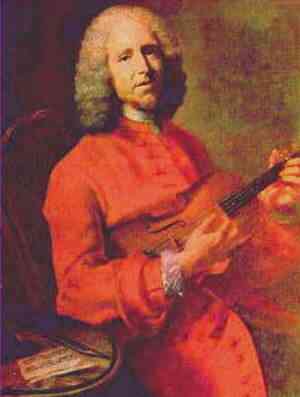 Jean-Philippe Rameau 1728 Painting: Jacques Aved Source: Baroque Music |
|
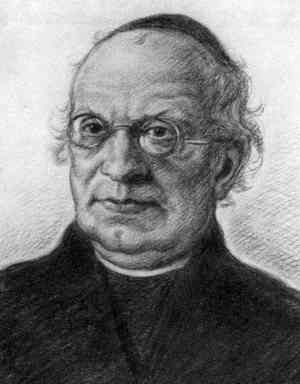 Bohuslav Cernohorsky Source: Sheet Music DB |
Christened on 16 Feb 1684 in Nymburk, Bohemia
(now in the Czech Republic),
Bohuslav Matěj Černohorský
was a baroque composer of largely sacred music (motets
and other choral works) and organ pieces (fugues,
toccates).
From 1700 to 1702 he studied philosophy in Prague, then became a
Franciscan in 1704, a priest in 1708. In 1710 he was banned from Czech
domains for traveling to Rome, invited by the Franciscan order there,
without Franciscan consent in Prague. In 1715 he was in Assisi as an
organist at the Basilica of San Francesco d'Assisi, also studying
counterpoint with
Giuseppe Tartini
while in Assisi. Once it was legal he went to Prague and taught music,
Josef Seger
and
František Tůma among his pupils. He
was banned yet again upon dispute with the Friars Minor (Franciscans) in 1731, this time because he denied them his family
inheritance. Which found Cernohorský back in Italy, now as an organist in
Padua. He died in Graz, Austria, on 1 July 1742. Due much to the Thirty
Years War [1,
2,
3,
4] which had hit Bohemia and Prague especially hard, Czech music had
been something set aback decades before Cernohorský arrived on the scene.
Prague had lost an estimated two thirds of its population as a result of
the Thirty Years War, concerning which the Peace of Westphalia [1,
2,
3,
4,
5,
6,
7,
8,
9] found Holy Roman Emperor Ferdinand III moving his court to Vienna
with a large portion of Prague's population following him. Thus emptied,
redevelopment required decades. Therefore, if Cernohorský wasn't a major
composer, he was nevertheless a major Czech link to the Baroque during a
period when Prague was beginning to prosper again. He joins
Zelenka at the
vanguard of a long list of Bohemian composers that would altogether rival
the rest of Europe's. As well, though Catholic influence was especially
strong in Vienna and Venice, both major centers of baroque music,
Cernohorský helped raised the ante of Catholic involvement in baroque to
further rival Protestant Germany. References: 1,
2,
3,
4.
Scores: 1,
2.
Editions.
Audio.
Discography.
Bohuslav Černohorský Organ: Neva Krysteva Organ: Jaroslav Vodrážka Brixiho Chamber Ensemble/Marek Müller |
|
| Born on 22 June 1684
Pistoia, Tuscany,
Francesco Onofrio Manfredini
studied violin in Bologna under
Giuseppe Torelli
and composition under Giacomo Perti at the Basilica of San Petronio. He was
the father of composer,
Vincenzo Manfredini
(1737-99). About 1700 Manfredini joined the orchestra of the Church of San
Spirito in Ferrara, returning to San Petronio in 1704 where he published his
Op 1 of 12 chamber concertos. He joined the Accademia Filarmonica (a musical society) in Bologna in 1709, the year he
published his twelve church sonatas compositions, a set of twelve chamber
sonatas. 1711 found him in the employ of Prince Antonio I of
Monaco. In 1727 he became maestro di capella at St. Philip's Cathedral in Pistola, where he kept until his death on Oct 6, 1762. Much of Manfredini's
oeuvre is thought to have been destroyed, there little more than 43
published works and manuscripts surviving. References: 1,
2,
3.
Lavori.
Scores. Editions: 1,
2.
Audio: 1,
2,
3,
4.
Discos: 1,
2,
3,
4.
Other profiles: 1,
2.
Francesco Manfredini 1718 1718 Concerto grosso in D minor Orquestra Ars Musicae de Mallorca Les Amis de Philippe/Ludger Rémy 1709 Sinfonia in F major Capricornus Consort Basel 1709 Sinfonia in D minor Capricornus Consort Basel 1709 Sinfonia in D major Capricornus Consort Basel |
||
| Born on 5 March 1685 in Halle, Germany, it is with
George Frideric Handel
that we begin to refer to Great Britain: England and Scotland forging the
Treaty of Union during his lifetime in 1706 to become the United Kingdom in
1707. Ireland would follow in 1800 w problems between Protestant England and
Catholic Ireland present from the incipiency of that combination [1,
2]. As for Handel, he joins
Johann Sebastian Bach as
a major composer at the height of Baroque w the exception that he left
Germany for England at age 30 where
Henry
Purcell, England's only major
baroque composer (less so the earlier
Lawes
brothers), had died fifteen years before when Handel was ten years of age.
The triad of major players in the baroque were Italy where it began and
maintained eminence, followed by Venice and Germany. Baroque definitely
flourished in Catholic France as well, though France, an empire decidedly in
of and to itself, was at odds against the
Holy Roman Empire throughout the period. The first Holy Roman Emperor
had been French per Charlemagne in 800 AD, a complex weave for the next
eleven centuries to the point of becoming its adversary and Napoleon's final
vanquishing of the Empire in 1806. In England meanwhile, the baroque had
taken a little longer to catch on in a place already set apart, as an
island, from the rest of Europe, and with its own ways such as the highest
literacy rate of the general population in Europe and its preference for
song to baroque instrumentation. To visit England was more like a trip to a
foreign country than to Poland. Even Spain, now a monarchy for the last
couple hundred years since
Isabella and
Ferdinand, was overall more baroque, and very much so, than England, the
latter a European odd ball during a period when France didn't intend to play
second fiddle to the Holy Roman Empire. But for
Purcell,
England occupies frugal space on the map of the elaborate baroque in
comparison to its continental centers, making its acquisition of Handel all
the more significant, bearing witness to the alliance between England and
Germany as Protestant nations as well. Handel's father had been a
barber-surgeon to the courts of both Saxe-Weissenfels and the Margraviate of
Brandenburg. Despite being groomed for a career in law and being forbidden
to tinker with musical instruments, Handel is said to have learned to play
harpsichord and organ as a child in secret. An early performance for Duke
Johann Adolf I of Saxe-Weissenfels was thus surprising: he wasn't supposed
to be able to play at all, much less well enough for his father to relent
and agree that Handel study under
Friedrich Wilhelm
Zachow at the Marktkirche Unser Lieben Frauen in Halle. By age 13 Handel
was skilled enough to perform for Frederick I of Prussia. He began to study
law at the University of Halle in 1702 while working as an organist, but
quit in 1703 to play harpsichord and violin in the orchestra at the Oper am
Gänsemarkt theatre in Hamburg. Handel premiered his first two operas,
'Almira' HWV 1 [1,
2,
3] and 'Nero'
HWV 2, in January and February of 1705, the latter entirely lost like
his later opera of 1708, 'Florinda' HWV 3 [1,
2], of which only scraps exist. In 1706 Handel took a trip to Italy to
compose for the Medicis, especially opera. He composed his first oratorio in
1707, 'Il trionfo del tempo e del disinganno' ('The Triumph of Time and
Disillusion')
HWV 243a, w libretto by Benedetto Pamphili. Handel revised that in 1737
as 'Il trionfo del Tempo e della Verità' ('The Triumph of Time and Truth')
HWV 46b. Handel was blind by the time of its 1757 revision so his
participation in that was minimal [1,
2]. Handel's 'La Resurrezione' HWV 47 followed in 1708 [1,
2,
audio], performed in Rome on the Easter Sunday of 8 April. In 1710 he
became Kapellmeister to German Prince George, Elector of Hanover (to become
King George I of Great Britain and Ireland in 1714). But he got ants in his
pants that same year, forcing him to take his opera, 'Rinaldo', to London
for its premiere on 24 February 1711, that the most frequently performed
opera during his lifetime [1,
2,
3,
audio]. IMSLP has that as
HWV 7a,
HWV 7b
a later revision as of 1731. In 1712 Handel was earning £200 (about $300) a
year from Queen Anne. He also found patronage in Richard Boyle, Earl of
Burlington and Cork. In 1717 Handel became composer to the Duke of Chandos
at his Cannons estate. The Cannons was a project begun by the Duke in 1713
to the purpose of architectural, artistic and landscaping splendor at a cost
of £200,000, equivalent to £27,220,000 today (nigh 41 million dollars).
Forty years later it ceased to exist, being demolished and even its bricks
sold, due to twists of fortune with the South Sea Company that left its
owner, the Duke's son, Henry, in ruins as well. In the meantime Handel
founded the
Royal Academy of Music in 1719 (not to be confused with the latter
Royal Academy of 1822). It was 1723 when he became an English subject
and began renting his place at 25 Brock Street in Mayfair, London, where he
stayed the remainder of his life. Handel found time to write settings for
several texts by B.H. Brockes in 1724-26, resulting in nine German arias
catalogued as
HWV 202-210
[HVW
202]. Handel later put a few texts by Charles Wesley to music about
1747, HWV 284-286, perhaps for Priscilla Rich. Handel composed his anthem,
'Zadok the Priest' HWV 258 [1,
2,
3], for the 1727 coronation of
King George II. With text from 1 Kings 1:38–40 employed, concerning the
anointing of King Solomon, that has been performed at every British
coronation ever since. Earlier settings for 'Zadok the Priest' used in
coronation anthems had been composed by
Thomas Tomkins for King Charles I in 1626 and
Henry
Lawes for King Charles II in 1661. Handel's 'Alexander's Feast' HWV 75
arrived in 1736 [1,
2,
3], that an ode in honor of
St. Cecilia w libretto by Newburgh Hamilton borrowed from
John
Dryden's 'Alexander's Feast' of 1697 w music, score now lost, by
Jeremiah Clarke. Dryden had been England's first
poet laureate, a station he occupied from April 1668 to January 1688,
that an an honor created by
Charles II. Handel's oratorio, 'Saul' HWV 53, premiered in London in
1739 [1,
2,
3,
4,
audio]. Come his opera 'Imeneo' HWV 41 on 22 Nov 1740 [1,
2,
3,
4] w an Italian libretto by Rolli. It was also 1741 when his last opera
to be performed in public appeared in London, 'Deidamia' HWV 42 [1,
2,
3]. In summer of '41 Handel went to Dublin to perform hospital benefits
for Duke William Cavendish of Devonshire where he began work that same year
on his oratorio, 'Messiah' HWV 56, in 1741, that premiering in Dublin in '42
[1,
2,
3,
4,
5,
6,
7,
8,
9,
text]. On 17 March 1749 Handel presented his oratorio, 'Solomon' HWV 67
[1,
2,
3,
4,
audio]. The first performance of his suite for wind instruments, 'Music
for the Royal Fireworks' HWV 351, followed on 14 April 1749 [1,
3,
6; audio:
1,
2]. A carriage accident in 1750 at age 65 saw Handel notably faltering
into old age, that soon followed by going blind. He was working on his
oratorio, 'Jeptha' HWV 70 [1,
2,
3], when he couldn't continue beyond 13 Jan of 1751, as noted by himself
on his score [audio:
1,
2]. Handel underwent cataract surgery, which may have done more harm
than good as he is thought to have been completely blind by the time
'Jeptha' saw delayed performance at the Covent Garden Theatre (Royal Opera
House) on 26 February 1752. Handel was blind the last seven years of his
life before dying on 14 April 1759. Buried in Westminster Abbey w more than
3000 attending his funeral, Handel had run three commercial opera houses
until 1741. He'd never married, leaving behind seventy paintings rather than
progeny. Along w 42 operas, 29 oratorios and the ten hymns mentioned above
Handel composed 120 cantatas amidst a host of other works. His trips had
made him the most important musical link between England, Ireland, Germany
and Italy during high Baroque. Handel's fame today is due much to the esteem
of major composers during his time, thereafter never permitted to fade away.
References:
1,
2,
3,
4.
Chronologies:
1,
2. Compositions:
1,
2,
3,
4;
anthems;
cantatas;
concerti grossi; concerti for organ:
1,
2;
English songs;
hymns;
Italan arias;
Italian duets;
keyboard;
Latin church music;
operas; orchestral:
1,
2;
oratorios;
sonatas for solo;
sonatas for trio;
wind ensemble. Scores:
1,
2,
3,
4,
5,
6. Editions of Handel:
Friedrich Chrysander (Breitkopf und Härtel 1858);
Drexel
5856; Hallische Händel-Ausgabe:
1,
Händel-Gesellschaft (1858/1902);
WorldCat; 'English
Songs' (facsimile of unidentified edition presented to the Library of
Musical Antiquities Society by Vincent Novello in 1849). Audio:
1,
2,
3,
4,
5,
6;
cylinder;
MIDI.
Recordings of: discos:
1,
2,
3,
4,
5,
6,
7; w
reviews;
operas; 'Deidamia': Brewer Baroque Chamber Orchestra w the Rudolph
Palmer Singers
*; Il Complesso Barocco directed by Alan Curtis
*;
Concerto Köln directed by Ivor Bolton
*; 'Imeneo'
by Europa Galante directed by Fabio Biondi; 'Jeptha'
by the Sixteen directed by Harry Christophers; 'Saul' by the Junge Kantorei
w the Frankfurt Baroque Orchestra directed by Joachim Carlos Martini:
audio,
review; 'Solomon' by the Junge Kantorei w the Frankfurt Baroque
Orchestra directed by Joachim Carlos Martini:
audio,
review; 'Il trionfo del Tempo e del Disinganno' by the Early Opera
Company directed by
Christian Curnyn. Further reading: Handel's
art collecting,
letters,
will;
CLASSIC fM; interview w
Sarah Bardwell; interviews by
Charlotte Higgins;
Ian Howell. Biblio: 'Dance in Handel's London Operas' by Sarah Yuill
McCleave (U of Rochester Press 2013)
*; 'Handel' by Edward J. Dent (2005)
*; 'The
Life of Handel' by Victor Schœlcher (1857)
*; 'Messiah: Fifty Expository Discourses' John Newton (1786)
*; 'An Account of the Visit of Handel to Dublin' by Horatio Townsend
(Barrister 1852)
*. Other profiles:
1,
2. See also the
Handel Institute. Per below, 'Almira' was Handel's first opera.
'Messiah' and 'Solomon' are oratorios, alike opera, but for music rather
than stage. HWV numbering is per the 'Händel-Werke-Verzeichnis'
of Bernd Baselt published in three volumes from 1978 to 1986. George Frideric Handel Sanerà la piaga un dì 1705 HWV 1 Fiori Musicali Soprano: Ann Monoyios 1739-40 HWV 319-330 The Avision Ensemble HWV 434:4 Piano: Cubus 1742 HWV 56 Arnold Schoenberg Choir Erwin Ortner Ensemble Matheus Jean-Christophe Spinosi 1749 HWV 351 English Chamber Orchestra Raymond Leppard Arrival of the Queen of Sheba 1748 HWV 67Budapest Strings 1717 HWV 348-350 Paul Kuentz Orchestra Coronation anthem 1727 HWV 258 BBC Symphony Orchestra & Symphony Chorus Sir Andrew Davis
|
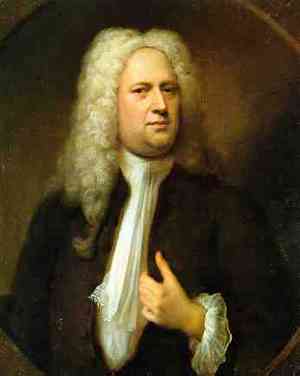 George Handel Painting: Balthasar Denner Source: Wikipedia |
|
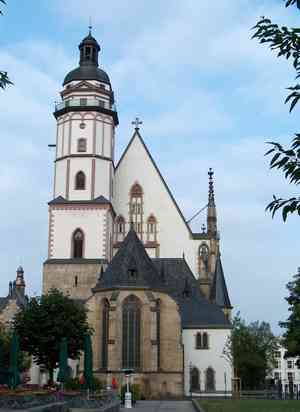 St. Thomas Church Source: Wikimedia Commons |
Born on 31 March in Eisenach, in 1685,
Johann
Sebastian Bach
represents the height of Baroque not only in Germany but the whole of Europe
as the key figure in the Bach musical dynasty [1,
2,
3]. For such as
Mozart, JS Bach is
where music began. Johann Sebastian was a cousin once removed of earlier
Johann Christoph Bach
and
Johann Michael Bach,
they preceding him by a couple generations. Bach's father, Johann Ambrosius,
was director of Eisenach's town musicians, he raising Bach in the study of
violin, harpsichord. Bach learned clavichord from his elder brother, Johann
Christoph. As all his uncles were musicians, he learned organ from one of
them, also named Johann Christoph. At age fourteen he attended St. Michael's
School in Lüneburg for two years. Upon graduating in 1703 he was appointed
court musician to the chapel of Duke Johann Ernst III in Weimar for several
months, then became organist at St. Boniface's Church in Arnstadt. 1707
found him organist at St. Blasius's Church in Mühlhausen where Bach married.
He wasn't to work there long though, for in 1708 he responded to an
invitation from the Duke of Weimar to become court organist. It's during
this period in Weimar that Bach began making his name, appointed
konzertmeister (music director) in 1714. It was about that time, 1714-1717,
that he composed his six 'English Suites' BWV 806–811 [1,
2,
3,
4,
5].
Not called that at the time, nor is it known when he actually wrote them w
sources lending possibilities from as early as 1713 to as late as 1725. Like
many of Bach's works, they weren't published until after his death. IMSLP shows them published in 1805-13 by Trautwein in
Berlin. Bach Cantatas has them individually published from 1812 to as late
as 1841 by a French publisher. Soon after his 'English Suites' Bach's career
was interrupted by
detention in jail for nigh a month [1,
2]
followed by a new position as kapellmeister to the court of Prince Leopold of
Anhalt-Köthen. It was about that time, 1717-1718, that Bach may have
authored the bulk of his six 'Brandenberg Concertos' BWV 1046-51 [1,
2,
3] possibly begun as early as 1713. Bach Cantatas has them all composed
in 1721. IMSLP has them composed individually from 1718 to 1721. Dedicated
to the Margrave of Brandenburg-Schwedt, BWV 1046 in F major was a revision
of 'Sinfonia in F major' BWV 1046a composed in 1718 and first published in
1885 [IMSLP]. Bach Cantatas and IMSLP have them eventually published in
Leipzig in 1850-52. In 1722 Bach authored what he might have begun in 1713
as well, Book I BWV 846–869 [1,
2,
3] of 'Das Wohltemeprierte Clavier' (‘The Well-Tempered Clavier’)
BWV 846–893. Consisting of 24
preludes
and fugues
in all 24 keys, the significance of that book first published in 1801 in
Wien concerns the tuning of instruments and requires a knowledge of
temperament [1,
2; equal 1,
2;
mean;
well;
equal versus well; Bach and: 1,
2,
3,
4].
It was also about 1722, perhaps earlier, that he began composing his six
'French Suites' BWV 812-817, completed in 1725 [1,
2,
3,
4,
5]. In 1723, Bach was appointed Cantor of Thomasschule (boarding house
and school) at St. Thomas Church in Leipzig, a position he kept for the
remaining twenty-seven years of his career. It was 1723 when he composed his first
version of settings for the 'Magnificat' BWV 243.1 previously catalogued as
BWV 243.a
[1,
2,
3]. The BWV directory begins at BWV 1 per 'Wie schön leuchtet der
Morgenstern', a cantata in F major written in 1725, first published, again
posthumously, in 1851 [1,
2,
3,
text]. In 1733 Bach changed the key of his earlier 'Magnificat' from
E-flat major to D major, producing a second version catalogued as
BWV 243.
Come Book II, BWV 870–893 [1,
2,
3,
4], of 'The Well-Tempered Clavier' within the range of 1739-44, first
published in 1801. His 'Goldberg Variations' saw ink in 1741, the last of
his four-part
Clavier-Übung (keyboard exercises) published collectively the same year. They are called
the 'Goldberg Variations' because he may have written them for virtuoso,
Johann Gottlieb Goldberg [1,
2,
3].
Bach is thought to have written 'Die Kunst der Fuge' ('The Art of
Fugue') BWV 1080 in 1742-46, revised 1748–50 [1,
2,
3,
4,
5,
6,
7]. Bach completed his well-known 'Mass in B minor' BWV 232 in 1749
[1,
2,
3,
4,
5,
6] before passing away on 28 July 1750. Not one of those artists who
died without a dime, Bach owned a library of 52 books, including Martin
Luther and Josephus. Books weren't cheap in Bach's time. A book could cost
the average laborer the majority of a week's salary, roughly the equivalent
of a McDonald's employee purchasing a Chromebook today.
Public libraries
[libraries]
were established so that people too poor to purchase books, yet largely
items for the well-to-do, could read. Bach also owned at least seven
harpsichords and several other string instruments. Summarily, as a composer
of sacred and secular music, Bach has been most greatly hailed for concerti,
choral works, organ and harpsichord, his
contrapuntal fugues in particular. He gave stellar performances as a
clavier player, virtuosic improvisation a conspicuous factor in much of his
work. References: 1,
2,
3,
4; extensive: 1,
2,
3.
Timelines: 1,
2,
3,
4.
Compositions: 1,
2,
3,
4,
BWV 1-1120; w
reviews;
Bach Digital:
search;
cantatas: 1,
2;
cantatas sacred;
cantatas secular;
chamber;
choral harmonies;
fugues;
harpsichord concertos BWV 1052–1065;
inventions & sinfonias BWV 772–801;
keyboard & lute; motets: 1,
2;
orchestral;
ochestral suites;
organ: 1,
2;
partitas:
1,
2,
3,
4;
sacred music in Latin.
Scores: 1,
2,
3,
4;
'The Art of Fugue' *;
four–part chorales *;
'Magnificat' *;
'Mass in B Minor' BWV 232 *.
Publications: 1,
2.
Editions:
Bach Gesellschaft begun 1851:
1,
2,
3;
Neue Bach-Ausgabe begun 1954 by the Johann Sebastian Bach
Institute:
1,
2;
orchestral;
'The Well-Tempered Clavier':
Book 1 (Peters 1963);
Book 2 (Peters 1971); Books 1 & 2:
1,
2;
WorldCat.
Audio:
1,
2,
3,
4,
5,
6,
7;
Netherlands Bach Society (NBS):
search;
organ by James Kibbie [1,
2]:
1,
2;
piano
by various; 'Brandenburg
Concertos'; 'Goldberg
Variations' by Murray Perahia (piano); 'Magnificat'
by NBS; 'Mass
in B Minor' BWV 232 by 'NBS;
'The Well-tempered Clavier' Book 1
(alt)
by Kimiko Ishizaka (piano);
Book 2 by Céline Frisch (clavier);
Books 1 & 2 by Chris Breemer;
MIDI files: 1,
2,
3;
4; 'Brandenburg
Concertos'; 'The
Well-Tempered Clavier';
harpsichord by
John Sankey.
Recordings of Bach: discos: 1,
2,
3,
4,
5,
'The Art of Fugue' BWV 1080: 1,
2;
'French
Suites'; 'Complete Cantatas' by the Amsterdam Baroque Orchestra directed by Ton Koopman:
Vol 1-22,
Vol 3,
Vol 6; 'English Suites' BWV 806–811:
Andrew Rangell (piano),
Masaaki Suzuki (harpsichord); 'French Suites' BWV 812-817:
Murray Perahia (piano),
Ilton Wjuniski (harpsichord).
Collections: Bach Archive: 1,
2,
3,
4. Further reading: Bach Cantatas ('Magnificat'):
1,
2;
British Library;
Jeremy Denk ('Goldlberg Variations'):
1,
2;
Don O. Franklin ('The Libretto of Bach's John Passion');
Musicolog;
Sergio Martínez Ruiz ('Well-Tempered Clavier');
Timothy Smith ('The Canons and Fugues of J. S. Bach');
Seth Colter Walls (Bach & Glenn Gould).
Bibliography: 1,
2,
3,
4;
5; 'Bach-Jahrbuch':
1,
2;
Bach's Nekrologue; 'Ueber Johann Sebastian Bach's Leben, Kunst und
Kunstwerke' by Johann Forkel (1852) *;
'J. S. Bach and the German Motet' by Daniel Melamed (Cambridge U Press 1995)
*;
'Johann Sebastian Bach: His Work and Influence on the Music of Germany' by
Philipp Spitta (Novello & Co 1873/80)
*;
'Johann Sebastian Bach'
PediaPress;
Peter Williams;
'Johann Sebastian Bach: The Learned Musician' Christoph Wolff (Oxford U Press 2002)
*; 'The New Grove Bach Family' (W.W. Norton & Co. 1983)
*.
See also: the Bach Network;
students of Bach. Other profiles: 1,
2,
3,
4,
5,
6,
7. Per below, Sean Jackson plays 'Toccata and Fugue' on organ as Bach
originally intended. The entry underneath is Leopold Stokowski's string
arrangement for the 1940 Disney film, 'Fantasia'. Bach's Brandenburg Concertos are also interpreted by
Pau Casals in
Early Modern. BWV numbering is per the
'Bach-Werke-Verzeichnis' [*]
first published in 1950, edited by Wolfgang Schmieder. The catalogue now
numbers above the 1,126 works that it listed in the 20th century. Another
numbering system is the BC (Bach Compendium) of H.J. Schulze and C. Wolff in
1985. Johann Sebastian Bach 1721 BWV 1046-1051 Münchener Bach-Orchester Karl Richter1717-23 BWV 1007-1012 Cello: Jaap ter Linden C 1714-17 BWV 806-811 Piano: Murray Perahia C 1714-17 BWV 812-817 Harpsichord: Pieter-Jan Belder Harpsichord Concerto No. 4 in A major 1738 BWV 1055 The English Chamber Orchestra Raymond Leppard 1724 BWV 78 Soprano: Ingrid Schmithüsen Collegium Vocale Philippe Herreweghe Magnificat in E-flat major 1723 BWV 243a 1749 BWV 232 Netherlands Bach Society Van Veldhoven Part 2 First performance: 1727 BWV 244 Amsterdam Baroque Choir Cappella Breda Boys Amsterdam Baroque Orchestra Ton Koopman 1725 BWV Anh.120 (dubious) Piano: Cubus No.1 in C major 1718? BWV 1066 No.2 in B minor 1738–39 BWV 1067 No.3 in D major 1731 BWV 1068 No.4 in D major 1725 BWV 1069 Les Concert des Nations/Jordi Savall Organ: Sean Jackson From the film 'Fantasia' 1940 Philadelphia Orchestra Leopold Stokowski Book I & II BWV 846–893 1722 Köthen 1742 Leipzig Harpsichord: Christine Schornsheim
|
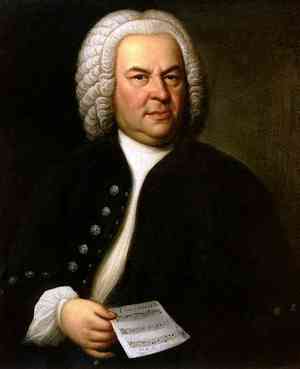 Johann Sebastian Bach Painting: Elias Haussmann Source: Barokin Musiikki |
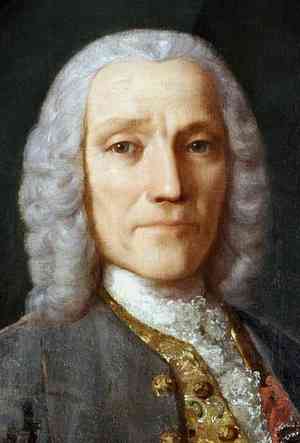 Domenico Scarlatti Source: Opi Wiki |
Born 26 October 1685
in Naples,
Domenico
Scarlatti was an influential late baroque composer at
root to the galant and classical styles, he bridging to them both. As the
son of
Alessandro Scarlatti,
he had a heady act to follow, and excelled. One cause of Scarlatti's
significance is his connection to Spain. Spain had produced a few
composers during the Renaissance (Tomás
Luis de Victoria), but it was something
in the suburbs like Poland, the core of musical activity in France, Germany, Italy, Venice
and England to lesser degree. With Scarlatti it's late Baroque
and a hundred years since these histories have visited Spain, which was and
remains, unless its moved lately, more than a thousand miles from Germany.
Despite the Habsburg Holy Roman Empire allied with Spain these were two different
worlds. The distance of Poland and Spain from Europe's main cultural hot
spots doesn't imply, however, that they lagged
behind the rest of Europe. Both were well abreast as cultural centers in
themselves. Viewing Portugal as a smaller
version of Spain, Scarlatti's traveling south of the Pyrenees to there
arrive in 1719 was nevertheless a main event in musical history. Scarlatti
had worked as a composer and organist in Naples as early as 1701. A few
years later his father sent him to Venice, he not raising his head again
until 1709 in Rome in service to
Queen Marie Casimire, she in exile from Poland. Casimire commissioned
seven operas from Scarlatti, his first a pastorale called 'La Silvia'
premiering on 27 Jan 1710. His second, 'Tolomeo e Alessandro', was staged on
19 January 1711. His last before her departure in flight from debt to France was 'Amor d'un'ombra e gelosia d'un'aura' (aka 'Narciso'
*) performed at her private theatre in Jan 1714. Scarlatti wrote his
'Christmas Cantata' in Rome in 1714, that among about 800 cantatas most of
which are of unknown date. Scarlatti had become employed at the Cappella
Giuiia at St. Peters in 1714, appointed maestro in December, which position
he held until 1719. It was probably during that period that his setting for
'Iste Confessor' appeared as well as a couple 'Miserere's ('Psalm 51'), his
'Magnificat' and his 'Stabat Mater'. The 'Magnificat' is a canticle (text
from the Bible) of Mary setting music to verses from the gospel of 'Luke'.
Scarlattie may have crossed the Channel to
London in 1715 to stage 'Narciso' at the King's Theatre [1,
2].
Scarlatti exchanged his position at St. Peter's for an appointment as tutor to
Barbara of Portugal in Lisbon in 1719. He left that position for
Rome in 1727 where he married one Maria Caterina Gentili on 6 May 1728 w
whom he would have five children. Moving to Seville in 1729, 1733 found him
in service to Barbara again, this time in Madrid, she now married into the
Spanish royal house, to become Queen in 1746. Scarlatti found little
argument in service to Barbara for the remaining quarter century of his
career. Born during the same year as Scarlatti
(26 October 1685) were Handel (5 March),
J.S. Bach (31 March) and
Lodovico Giustini on
12 December. Albeit originating when all were about
fifteen years of age, none but Giustini composed for piano, the instrument
yet too imperfect for the others. Giustini is credited with
the first known compositions specifically for piano rather than harpsichord
per his '12 Sonate da Cimbalo di piano e forte' published in Florence in
1732. Scarlatti's connection to piano is by virtue of Barbara who would own
five pianos among twelve keyboard instruments at the time of her death in
1758. Scarlatti was no doubt familiar with the early piano, its existence
likely of some affect in his composing, but it wasn't yet capable of what a
harpsichord could do so he wrote keyboard pieces for harpsichord or organ
only. He is commonly recorded on piano by virtue of his familiarity with the
instrument at the court of Barbara. The piano was called it a "gravicembalo
col piano e forte" ("keyboard instrument with soft and loud" by its
inventor, Bartolomeo Cristofori, who presented his instrument to Ferdinando
de' Medici of Tuscany in Florence in 1700. Gravicembalo translates to
harpsichord in Italian. Three pianos that Cristofori made in the 1720s yet
exist. Despite the first piano arriving in 1700, its development toward the
instrument that would replace the harpsichord took perhaps a hundred years.
Haydn composed for piano as early as the 1760s, Beethoven as a teenager in
the 1880s, and Mozart used the instrument during the last decade or so of
his career before his death in 1791. These were lighter and lesser developed
instruments than the grand piano which Steinway introduced in America in
1840. A particularly nice marker of piano finally coming of age after a
century of development by various in succession is Beethoven's 'Moonlight
Sonata' written for piano in 1801, not nearly so romantic on a harpsichord.
Beethoven loved the piano for which composed, ever looking for someone who
could make a better instrument. Another generation and piano had put
harpsichord where you could see it in your rearview mirror. None of
Scarlatti's oeuvre is addressed so much as his sonatas principal in
scholarship. Scarlatti published his 'Essercizi
per Gravicembalo' ('Exercises for Harpsichord') in 1739. That begins the
Kirkpatrick catalogue with 'Sonata in D minor' as
K 1. The last of thirty pieces in that book was his famous 'Cat Fugue' (Fugue in G
minor)
K 31.
A second book was published that year with the edition of twelve more
sonatas to total 42. They are much Scarlatti's 550 keyboard sonatas
[Kirkpatrick] written for Barbara in Madrid that illuminated the court of
Spain during the late baroque period. All seventeen of Scarlatti's sinfonias
are found in manuscript inscribed sometime between 1750 and 1790, composed c
1750 to 1756. To go by Wikipedia, among Scarlatti's latest datable operas
was 'I portentosi effetti della madre natura' composed in 1752. Scarlatti
had written his first 'Salve Regina' as early as 1712. His second is thought
to have been his final complete composition arriving 1756 or 1757. As for numbering systems, there are four, the earliest, CZ,
getting indexed by composer,
Carl Czerny, at an unidentified time; L by
Alessandro Longo in 1905;
K by Ralph Kirkpatrick [1,
2] in 1953 and P by
Giorgio Pestelli in 1967.
See also CZ-L-K-P;
L;
L-K-P;
Kirkpatrick v primary sources.
References encyclopedic: 1,
2,
3,
4;
musical: 1,
2,
3.
Compositions: ballets;
chamber;
harpsichord;
piano (discograohy); sonatas:
1,
2,
3,
4,
5; voice:
1,
2.
Scores.
Editions: 'Twenty-Two Pieces for Piano' ed by Giuseppe Buonamici (1895);
Sonatas 1-555.
Audio: 1,
2,
3,
4,
5;
sonatas:
Claudio Colombo (piano); various: 1,
2.
Recordings of: discos: 1,
2,
3,
4,
5,
6;
Kirkpatrick;
'52 Sonatas' by Lucas Debargue *;
'Salve Regina' by the Orquestra Barroca de Sevilla directed by Nicolau de Figueiredo
*.
Discussion:
Bach Cantatas;
guitar. Further reading: Christopher Hail: the cataloguing of Scarlotti:
1,
2; Scarlotti's
contemporaries;
Siegfried Holzbauer (blog); 'Mapping the Musical Genome: The Scarlatti Family' by
Georg Predota
*;
'The Guitar and Domenico Scarlatti' by Rafael Serrallet
*;
'The Keyboard Tuning of Domenico Scarlatti' by John Stankey
*;
'The Mercurial Maestro of Madrid' by Robert White
*.
Biblio:
Abe Books; 'El avance hacia la idiomatización del lenguaje pianístico a
través de la edición de Clementi de las sonatas de D. Scarlatti (1791)' by
Laura Cuervo Calvo:
1,
2;
'Domenico Scarlatti' by
Ralph Kirkpatrick (Princeton U Press 1953); 'The Keyboard Sonatas of
Domenico Scarlatti and Eighteenth-Century Musical Style' by
W. Dean Sutcliffe (Cambridge U Press 2008):
review.
Collections.
Other profiles: 1,
2,
3,
4.
See also Associazione Domenico Scarlatti. Per below, with the exception of
'Essercizi per Gravicembalo' the entire list of sonatas is performed by
harpsichord master, Scott Ross. Domenico Scarlatti K 1-15 Published 1739 in London Harpsichord: Scott Ross |
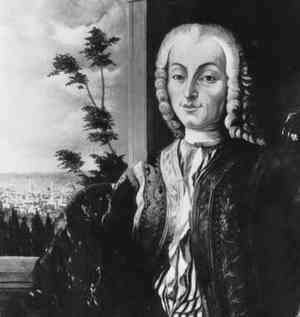 Bartolomeo Cristofori Inventor of the Piano Source: Musica En El Mateo 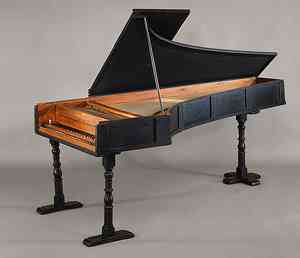 Cristofori Grand Piano 1720 Source: The Met 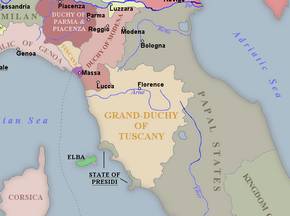 Florence, Italy Circa 1700 Birthplace of the Pianoforte |
| Born on 17 August
1686 in Naples,
Niccolò Porpora
(Nicola Antoine) was a graduate of the Naples Conservatory of Music, Poveri
di Gesù Cristo. His first opera, 'Agrippina', was produced in 1708 for the
royal court in Naples. His 'Berenice', was performed for Carnival in
Rome in 1718. Though Porpora came by a number of opera patrons in his early years,
and collaborated with the famed librettist,
Metastasio, he remains
better regarded as a voice teacher at the Naples Conservatory, training
several big names. Perhaps in 1725 Porpora arrived in Venice, composing and
teaching until 1748 when he became kapellmeister to the Elector of Saxony in
Dresden. In 1752 he left for Vienna where he taught young
Franz Joseph Haydn, who
remembered him as an "ass" and "rascal" (not a term of affection in
Porpora's time) but a master musician, especially as to composition and
song. Naples received Porpora's return in 1759. He there died on 3 March
1768. Too poor to pay for his funeral, a concert given to raise the funds.
The prima donnas and primo uomos he had trained, however, lived like, well,
prima donnas. The soprano, especially, was the rock star of Porpora's day and,
like baseball players today there was much ado about opera singers
accumulating more wealth than commensurate with their real worth. What one
hears with Porpora is the fade of the Baroque, its last flickering before
the douter descends on the period. Porpora wrote cantatas, instrumentals and
various sacred works in addition to perhaps four dozen operas. He was known to be
highly literary, a poet, and able to read and write in multiple languages.
References encyclopedic:
1,
2,
3,
4; musical:
1,
2,
3,
4.
Operas.
Editions: in compilations.
Scores: 1,
2,
3.
Audio. Discographies: 1,
2.
Collections:
British Library. Further reading: 'Nicolò Porpora and the Cantabile
Cello' by Rosalind Halton. Other profiles:
1,
2,
3,
4.
See also LiederNet. Per below, Metastasio is librettist of 'Semiramide Riconosciuta'. Niccolò Porpora Movements 1-2 of 4 Sometime 1733-36 L'Ensemble 415/Chiara Banchini Cello: Gaetano Nasillo Movements 3-4 of 4 Sometime 1733-36 L'Ensemble 415/Chiara Banchini Cello: Gaetano Nasillo Opera Act 2 Aria 3 'Dolci fresche aurette' First Performance 1735 London Coloratura mezzo-soprano: Vivica Genaux 1744 Orchestra da camera del Teatro del Giglio di Lucca Gianfranco Cosmia Opera First Performance 1729 Venice Accademia Bizantina Stefano Montanari Libretto: Metastasio |
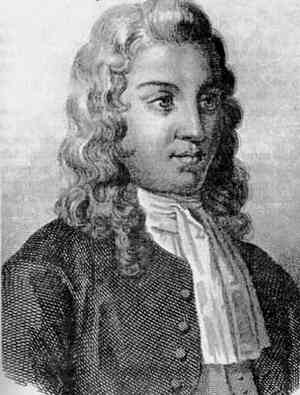 Niccolo Porpora Source: Into Classics |
|
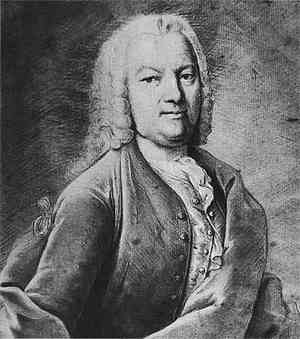 Johann Pisendel Source: Bach Cantatas |
Born on 26 Dec 1687
in Cadolzburg near Nuremberg,
Johann Georg Pisendel
is but one more reason Germany dominated the latter Baroque period of music.
As a violin master, he composed largely for that instrument. Pisendel's
father was a cantor and organist. At age nine Johann Georg became a choirboy
in Ansbach where he probably studied violin under
Giuseppe Torelli. He was hired to play
violin in the court orchestra in Dresden, but left for Leibniz in 1709 where
he became a member of
Georg Telemann's Collegium musicum (a
musical society). Returning to Dresden in 1712, Pisendel joined the court
orchestra once again and remained with it the rest of his life. Studying
composition under
Johann Heinichen
in 1718, he became Concert Master in 1728 until his death on 25 November
1755. Pisendel's compositions had been highly influential to other composers
during his day, less so in modern times, particularly after the loss of
Shrank I and Shrank II in the bombing of Dresden during World War II.
Schrank I was a major collection of manuscripts produced in the sixteenth
and seventeenth centuries. Shrank II housed manuscripts from the eighteenth
century. The Schrank II has since been reconstructed to contain nearly 1,750
works, numerous by Pisendel.
References: 1,
2,
3,
4.
Compositions. Scores: 1,
2,
3. Audio: 1,
2,
3.
Recordings of: discos: 1,
2,
3; 'Violin
Sonatas' by Tomasz Aleksander Plusa (violin).
Other profiles: 1,
2.
Johann Georg Pisendel Batzdorfer Hofkapelle Daniel Deuter Baroque violin: Anton Steck Freiburger Barockorchester Gottfried von der Goltz Violin: Roman Totenberg Baroque violin: Martina Graulich Harpsichord: Christian Rieger Baroque violin: Anton Steck |
|
| Born in 1690 in Florence,
Francesco Maria Veracini
was a violin virtuoso, master of the chamber sonata of which he wrote above
three dozen in addition to numerous works for voice, orchestra and a few
operas.
He was taught violin mostly by his uncle, Antonio Veracini. His father ran
a music school established by his grandfather. His family also ran a
painting studio, owning several expensive works as art collectors.
Relevantly, it was during the Baroque that musicians came to rely less on
nobility for patronage, as during the Renaissance, and more on commercial
enterprise, particularly notable in the construction of theatres to sell
seats for opera. A contemporary of composer and violinist,
Carlo Ambrogio Lonati, Veracini's first known solo violin performance
was a Christmas mass at San Marco in 1711. The first known performance of
one of his own compositions was a violin concerto the following year in
Venice. In 1714 Veracini left for London where he performed during opera
intermissions at the Queen's Theatre, England's major venue. In 1717 he
acquired the patronage of Prince Friedrich August of Poland, as a result of
dedicating a set of 12 sonatas and a collection of six overtures to him in 1716.
It's said that Augustus paid Veracini an unusually high salary. Becoming engaged in the project of
building a new opera theatre for August at the Zwinger palace in Dresden,
Veracini went to Venice to recruit vocalists in 1719. His first collection of
sonatas was published in 1721. Though the incident wants clarity, in 1722 Veracini
leapt from a second-story window in Dresden, due some enmity between him and
other musicians, causing him to break either a foot, leg or hip that left him with a limp
the rest of his life. That incident
probably helped persuade him toward less stressful employment in a church in Florence the next
year. In 1733 Veracini returned to London to perform and compose opera, his
first, 'Adriano in Siria', to premiering in 1735. His last
opera, 'Rosalinda',
was there performed in London in 1744. Upon his return to the continent in 1745 he was
involved in a shipwreck that claimed his property including two prized Stainer
violins named Peter and Paul. He delivered concerts in Pisa until 1750 when
he moved to Turin, about the time he published his pedagogical 'Il trionfo della pratica musicale' ('The
Triumph of Musical Practice') Opus 3 [1,
2]. Veracini departed Turin in 1755, to return to his birthplace,
Florence, there to die on 31 Oct 1768, working as maestro di capella at both San Pancrazio and San Gaetano. As for violins, among the
earliest prominent luthiers had been the Amati family, making violins in
Cremona, Italy, since the mid 16th century. The Guaneris began producing
violins in the mid 17th century, also in Cremona. Jacob Stainer (1617–1683)
had been an Austrian luthier whose violin was the treasure to own before the
more powerful design of the Stradivari. Another highly reputed luthier during Veracini's time was Carlo Bergonzi. References for Veracini: 1,
2,
3,
4.
Chronology.
Compositions: 1,
2.
Scores: 1,
2.
Editions. Audio: 1,
2,
3,
4,
5;
sonatas: 1,
2,
3,
4,
5.
Recordings of: discos: 1,
2,
3; 'Overtures' by the Musica Antiqua Köln directed by Reinhard Goebel
(No. 1-4 & 6) *.
Bibliography: 'The Life and Works of Francesco Maria Veracini' by John
Walter Hill (UMI Research Press 1974). Other profiles: 1,
2,
3,
4,
5.
References for
major luthiers:
Amati: 1,
2,
3;
Bergonzi: 1,
2; Strad website:
1,
2; Tarisio website:
1,
2,
3;
Guaneri: 1,
2,
3,
4,
5,
6,
7;
Stainer: 1,
2,
3,
4;
Stradivari: 1,
2,
3,
4,
5,
6.
Francesco Maria Veracini 1716 Musica Antiqua Köln/Reinhard Goebel 1744 Op 2 No 5 in G minor Clavicembalo: Marco Mencoboni Violin: Luigi Mangiocavallo Violincello: Claudio Ronco 1744 Op 2 No 12 in D Minor Harpsichord: Lars Urlik Mortensen Violin: John HollowayVioloncello: Jaap Ter Linden 12 Sonate a violino o flauto solo e basso 1721 Op 1 No 1-7 Violin: Enrico Casazza |
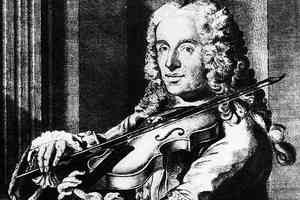 Francesco Veracini Source: Figaro |
|
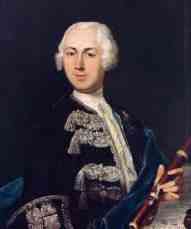 Johann Quantz Source: Expedition Audio |
Born on 30 Jan 1697
in Oberscheden, Germany, flautist
Johann Joachim Quantz
was another prize in the musical dominion that was largely Germany's in the
latter Baroque. Quantz' father was a blacksmith who wanted him to follow in
his profession, but died when Quantz was young, Johann to end up with an
uncle. Johann studied several musical instruments, preferring oboe and
violin. Quantz studied with Zelenka in Vienna in 1717 before switching to
flute in Dresden in the employ of
Augustus the Strong of Poland. Augustus paid Quantz to study in Rome, Naples
and Paris from 1724 to 1727. He also studied with Handel in England before
returning to Augustus in Dresden. Quantz continued in Dresden after the
death of Augustus in 1733 until receiving a position with
Frederick the Great of Prussia in 1741. Quantz had been giving lessons
to Frederick twice a year since 1728. Famous in his own time as a flute
composer and virtuoso, since then it is his
pedagogical book, 'Versuch einer Anweisung die Flöte traversiere zu spielen'
('On Playing the Flute'), published in 1752 that musicologists in
particular have appreciated [1,
2,
3,
4,
digital copy], giving insight into the music of the period. Quantz died in
Potsdam Germany, on 12 July 1773. He had composed arias, lied and orchestral
works, but his flute concertos number nearly three hundred, and his flute
sonatas more than two including trio sonatas. References: 1,
2,
3,
4,
5.
Chronology.
Compositions. Scores: 1,
2. Publication
digital copies. Editions: 1,
2,
3.
Audio: 1,
2,
3,
4,
5;
Quantz Project.
Discos: 1,
2,
3,
4,
5.
Bibliography.
Further reading: Feike Bonnema.
Other profiles: 1,
2,
3. Per
below, QV numbers are per Horst Augsbach 1997. Johann Joachim Quant QV 5:38 Vivace Baroque Flute: Mary Oleskiewicz Budapest Concerto Armonico Miklós Spányi QV 5:81 Budapest Concerto Armonico Miklós Spányi Baroque Flute: Mary Oleskiewicz QV 5:196 Les Buffardins QV 1:162 Flute: Dorothee Kunst Lute: Susanne Peuker QV 1:33 Flute: Mary Oleskiewicz |
|
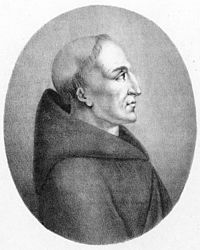 Francesco Vallotti Source: Wikipedia |
Born in Vercelli on
11 June 1697,
Francesco Antonio Vallotti
wasn't a major composer, writing only sacred music in Italy at a time when
opera had long since been the main venue of musicians who aspired to fame.
Relevantly, it was during the Baroque that musicians began to shift from
seeking patronage from royalty to commercial ventures like opera or
wealthy, though not necessarily aristocratic individuals. It is during the
Renaissance that commercial enterprise began its rise toward rivalry w
royalty in terms of wealth, thus power. During the Baroque period such as
mining, precious metals from the Americas, banking and trading derivatives
would prove early capitalism the answer to not being luckily born. That
would lead from a few rich whilst the most poor to a few rich whilst some
middle class (bourgeoisie) whilst the most poor. Among the largest companies
on the globe were in shipping, driving the colonial expansion of Europe. The
British East India Company [1,
2] had been chartered in 1600 as The Company of Merchants of London
Trading into the East Indies. That was three years after the staging of the
first opera in 1597,
Jacopo Peri's
'Dafne', and two years before
Gulio Caccini
published his work 'Le Nuove Musiche' ('The New Music') in 1602, the latter
the year of the founding of the Dutch East India Company [*].
Come the Dutch West India Company [*]
in 1621. The Portuguese East India Company [*]
had been formed as early as circa 1500 but was a royal monopoly until 1628.
The burgeoning of commerce that preceded the Industrial Revolution, however,
was not without gamble, evidenced by the South Sea Company Bubble of 1720
nine years after its founding [1,
2,
3,
4].
[See also commercial growth of Europe: 1,
2,
3,
4.]
Howsoever, if royal patronage or commercial endeavor both came with
risks, working for the Church was relatively more secure, which is how
Vallotti got along, becoming a Franciscan in 1716, a priest in 1720. He
assumed a position as organist at St. Antonio's in Padua in 1722, then
maestro in 1730, which station he kept throughout his career for the next
half century. Vallotti's best-known work was in music theory arriving in
1779 to address counterpoint, harmony and a system of tuning called Vallotti
temperament: 'Della scienza teorica, e pratica della moderna musica libro
primo' [1,
2].
He died the next year on 10 Jan 1780. Vallotti composed largely
psalms, hymns, responsorials and other liturgical works. Responsorial
singing, incidentally, between a cantor and congregation, had well preceded
Jesus, it a Jewish development to sing the psalms of David [Jewish Music Resource Center].
Compare
responsorial to
antiphonal. References for Vallotti: 1,
2.
Vallotti temperament:
Carey Beebe
(pdf);
Wikipedia.
Scores: 1,
2.
Recordings of: 'Le Lamentazioni Del Profeta' by the Ensemble Festa Rustica directed by Giorgio Matteoli'
*.
HMR Project. Bibliography: Sven Hansell.
Francesco Antonio Vallotti 1737-43 Ensemble Festa Rustica/Giorgio Matteoli Soprano: Rosita Frisani Responsorial sung as a motet Concierto Coro Institucional Pontificia Universidad
|
|
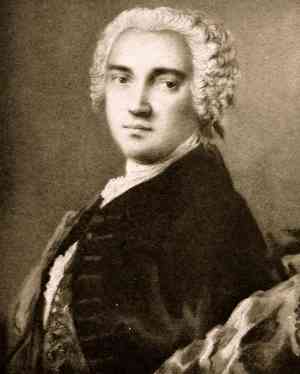 Johann Adolph Hasse Source: Wikimedia Commons |
Born in Bergedorf,
Germany, on 25 March 1699,
Johann Adolph Hasse
joined the Hamburg Opera in 1718. He took a singing position at the court of
Brunswick the next year. While there he produced his first opera seria, 'Antioco',
in 1721 with libretto by Apostolo Zeno and Pietro Pariati. Hasse left Germany
in 1722 to destinations in Venice and Italy before arriving in Naples about
1724, there to premiere his serenata commissioned by a banker, 'Antonio e
Cleopatra' [1,
2], in 1725. His next opera, 'Sesostrate', premiered on 13 May 1726,
the first of several for royalty in Naples, Naples under jurisdiction of
Holy Roman
Emperor Charles VI at the time. 'Sesostrate' had been performed for the
9th birthday of Princess
Maria Theresa at the Teatro San Bartolomeo in Naples, commissioned by
the Duke of Brunswick (Lower Saxony). Among Hasse's more popular pieces was his 'La Contadina' of 1728 containing two
intermezzi (intermissions inserted into operas). Other among his Neapolitan
operas was 'Attalo, re di Bitinia' [*],
premiering in May of '28, followed by 'L'Ulderica' [*]
and his comedy, 'La sorella amante' [*],
in 1729. Hasse's last of eleven operas performed in the first of two periods
in Naples also premiered in 1729, 'Il Tigrane' and 'L'Emma'. Hasse left
Naples in 1730 to visit the
Carnival of Venice. The opera that he there premiered in February,
'Artaserse' [1,
2,
3], was his first w librettist,
Metastasio. Among the
various librettists with whom Hasse worked (Pallavicino,
Pasquini, et al)
Metastasio was the
major. Wikipedia has them collaborating on 39 operas to as late as 'Il
Ruggiero' in 1771 with Metastasio
borrowing from Ariosto's original text. Hasse's visit to Venice
was that time long enough to stage another opera in May of 1730, 'Dalisa' [*]
w libretto by Domenico Lalli after Nicolò Minato. Circa 25 June he married the soprano, Faustina Bordoni
[1,
2].
Leaving Venice to work in Vienna briefly in 1731, Bordoni and Hasse
arrived to the court of
Augustus II in Dresden [1,
2,
3] where
Hasse became kapellmeister that year. His opera seria, 'Cleofide', premiered on 13 Sep 1731 [1,
2,
3,
4,
5,
6].
The libretto for that was by Michelangelo Boccardi after
Metastasio's
'Alessandro nell'Indie'. Soon departing Dresden, though to return, Hasse
spent nigh the rest of his entire career on tour to theatres in locations
like Turin, Rome, Venice, Naples, Pesaro and Warsaw. IMSLP has Hasse
premiering his 'Didone Abbandonata' [*]
at the
Hubertusburg in Saxony on 7 Oct 1742, in Saxony on 4 Feb 1743. It was Venice
again in '44 for 'Semiramide Riconosciuta'. It was Dresden again for the
premiere of 'La Spartana Generosa' on 14 June of 1747. It was also '47 in
Dresden that the new position of Oberkapellmeister was created for Hasse,
Nicola Porpora appointed
Kapellmeister. In 1750 Hasse visited Paris to stage his earlier 'Didone
Abbandonata'. Another trip to Venice witnessed 'Il ciro riconosciuto'
[1,
2]
staged in 1751. Due to the Seven Years War [1,
2] fought between England and France in both Europe and North America
the court in Dresden was relocated to Warsaw, Poland, in 1756. He was back
in Naples in 1758 to stage a third version of
Metastasio's
'Demofoonte' [*]
first performed in 1748 in Dresden, revised for the Carnival of Venice in
'49. Hasse's patron,
Augustus III of Poland, died in 1763. His successor,
Frederick Christian,
found himself faced with financial ruin as a result of the Seven Years War
[1,
2] which ended that year. Choosing between frivolity and frugality, he
released Hasse from service with two years pay but
no pension. Hasse moved to Vienna the next year, as popular as ever there.
'Partenope' w a libretto by
Metastasio premiered
in September 1767, eleven year-old
Mozart
in attendance. 'Piramo e Tisbe' [*]
arrived in Sep of '68 w libretto by Marco Coltellini. Empress Maria Theresa
(nine-year old princess above) commissioned 'Il Ruggiero' [1,
2] to premiere in Milan in latter 1771, libretto by
Metastasio after
Ludovico Ariosto. By that time Hasse was above seventy years of age and his
slightly younger contemporary,
Christoph Willibald
Gluck, was pulling Vienna's strings. So he left Vienna in 1773 to teach
and compose sacred music in Venice, there to remain for the next ten years.
Notable in the brief account above is how much traveling Hasse did. From the
troubadour to this day, with exceptions like the Church, joining a symphony
orchestra or remaining local, it's been largely travel that makes a
musician's career and travel that wears a musician out (touring). The stars
of Hasse's day, such as prima donnas like Faustina and primo uomos,
generally tenors, didn't die in automobile or airplane accidents like rock n
roll stars in the 20th century. But it was a bumpy ride to haul oneself and
one's effects overland by coach. The great commercial expansion that
occurred in Europe during the Baroque period had been assisted by
improvements in roads and development of the coach [1,
2,
3,
4].
If you were a horse, of course, you could prefer at least an apple
to have to pull one of even these
carriages. See also travel and the coach in
Austria-Germany,
England, Russia: 1,
2;
carriages: 1,
2.
Just how Hasse traveled overland during different periods of his life isn't
identified. He never went to Russia so the troika [1,
2]
can be eliminated. He married Faustina in 1730, prior to which he might
easily have gotten about during his twenties on horseback or by walking many
a mile. Howsoever, Hasse put away
his traveling shoes the last ten years of his life while composing for the Ospedale degli Incurabili
[*],
dying in Venice on 16 Dec 1783 [*].
Faustina had preceded him in Nov of '81. Along w operas Hasse composed
oratorios, cantatas, ballads and instrumentals. Albeit a heavyweight during
his lifetime for about forty years, with
Gluck
overtaking from close behind, Hasse had little posthumous influence.
References: 1,
2,
3,
4,
5.
Compositions.
Operas: 1,
2.
Scores: 1,
2,
3,
4,
5.
Editions: 1,
2.
Audio: 1,
2,
3,
4.
Recordings of: discos: 1,
2,
3;
'Antonio e Cleopatra' by Ars Lyrica Houston directed by Matthew Dirst:
1,
2;
'Didone Abbandonata' by the Hofkapelle Munchen directed by Michael Hofstetter
*,
review;
'Piramo e Tisbe' by the Academia di San Rocco directed by Mario Merigo
*.
Other profiles: 1,
2,
3. See also the
Hasse Project.
Johann Adolph Hasse Cantata 1769 Concilium Musicum Vienna Paul Angerer Soprano: Ursula Fiedler Opera First performance 1760 ViennaEnsemble La Stagione Frankfurt Favorit-und Capellchor Leipzig Michael Schneider Opera First performance 1753 HubertusburgAmsterdam Baroque Orchestra Ton Koopman Harpsichord: Luca Guglielmi 'Misere' / Movement 1 of 6 Coro Femminile Euridice Architorti' Massimo Lombardi Recorder Sonata in B flat major Harpsichord: Luca Quintavalle Recorder: Daniel Rothert Opera First performance 1761 at the Carnival of ViennaWarsaw Chamber Opera |
|
|
Born on 27 Oct 1703 in Wahrenbrück, Germany,
Johann Gottlieb Graun was older brother to
Carl Heinrich Graun.
The part of the Holy Roman Empire (HRE) into which Johann had arrived was
the Margraviate of Brandenburg. As this
remarkable map of the development of the Holy Roman Empire to the
emergence of the German Empire in 1871 shows, the Holy Roman was a complex
conglomerate ever embattled, ever in flux. Graun would live through six
Holy Roman Emperors from Leopold I [1,
2,
3] at the time of his birth to Josephus II [1,
2]
when he died. At the time of Johann's birth France had long since departed
from the HRE and become its major adversarial rival. At the year of
Johann's birth
Louis XIV, the longest reigning monarch in European history, had been
Sun King of France since age four for the last 60 years and with twelve
more to go. He had begun to reign personally in 1661 at age eighteen. At
its other front the HRE had for centuries been facing not only a dangerous
rival, but an outright enemy for reasons of religion in the Ottoman Empire
from which Austria had recently reacquired Hungary in 1699. The Habsburg
victory at the
Battle of Senta in 1697 had put the Ottoman threat largely to rest as
the Empire declined into remission, hemmed off as well by Eastern Orthodox
Russia. Over in Spain the
War of Spanish Succession would be fought for thirteen years from 1701
to 1714 during Johann's childhood, that involving England and France.
Clement XI [1,
2,
3]
became the 243rd Pope in 1700 and would remain to 1721. It was also 1700
to 1721 that Russia and Sweden fought the
Great Northern War (GNW) ending to Russia's favor. Like the War of
Spanish Succession, that was also a complicated weave involving the rest
of Europe, particularly a little closer to Johann's home insofar as
Frederick I had named himself (the first) King of Prussia in 1701 and
allied himself w Russia toward Sweden's defeat in the GNW. As for England,
both the
Tory and
Whig parties had been recently formed in 1678 to become major rivals
well into the 19th century. As well, England and Scotland became Great
Britain in 1707 under the reign of Queen Anne
(1702-14). Such were something of the greater world that had formed or was
in progress as Johann studied under
Johann Pisendel
in Dresden and
Giuseppe Tartini in Padua before
becoming a konzertmeister in Merseburg in 1726. He hired on with
Frederick II
[Wikipedia]
in 1732 and became Konzertmeister of the Berlin Opera in 1740. Johann
wrote numerous works for violin, particularly sonatas and concerti like
'Violin Concerto in D Minor' GWV C:XIII:75 published circa 1735-50
[*,
audio]. Also writing symphonies and overtures such as 'Suite in
a-moll' GWV C:XI:16 composed at an unknown time [score],
he composed for viol da gamba and flute as well. Johann and brother, Carl,
each fell into such obscurity that many of
their works can't be dated, though both were highly regarded musicians in their
day. Johann's brother, Carl, was more popular with vocal works like operas
while Johann drew applause for instrumentals as a violin virtuoso. Johann
died on 28 October 1771 eleven years after his brother, Carl, in 1759.
References: 1,
2,
3.
Compositions: 1,
2,
3,
4,
5,
6.
Scores: 1,
2,
3.
Editions. Audio: 1,
2,
3,
4,
5. Recordings of: discos: 1,
2,
3,
4;
'Concertos'
by the Weiner Akademie directed by Martin Haselbock. Other profiles:
1,
2. Graun's trio sonatas below are thought to have been published
between 1725 and '35. GWV numbers are per 'Graun-Werkverzeichnis' by
Christopher Henzel (Ortus Musikverlag 2006) following earlier directories
by Carl Heinrich Mennicke and Monika Willer. Johann Gottlieb Graun Concerto for 2 Violins in G major GWV C:XIII:84 moderntimes_1800 Concerto for Violin and Viola da Gamba GWV A:XIII:3 C minor Allegro Frankfurt Capella Academica GWV A:XV:13 Allegro In collaboration w Carl Graun Les Amis de Philippe GWV A:XV:19 Allegro ma non molto Les Amis de Philippe GWV Cv:XV:100 Allegro In collaboration w Carl Graun Les Amis de Philippe GWV A:XV:27 Allegro In collaboration w Carl GraunLes Amis de Philippe GWV C:XIII:68 moderntimes_1800 |
||
|
Born on 7 May 1704 in Wahrenbrück,
Carl Heinrich Graun
was younger brother to
Johann Gottlieb Graun,
with whom he went to Dresden in 1714 where they received a Lutheran
education and sang in both the choir of the Dresden Kreuzkirche and the
chorus of the Opernhaus am Zwinger. Between sacred music and opera Graun
went the latter, his five-act 'Polydorus' premiering in 1726. Carl became Konzertmeister of the Berlin Opera in 1740.
On 7 December 1742 he premiered his opera, 'Cesare e Cleopatra', at the
Königliches Opernhaus in Berlin [1,
2].
Frederick II wrote the
libretto for 'Montezuma' that premiered at the same theatre on 6 January 1755 [1,
2,
3].
Carl's oratorio, 'Der Tod Jesu', premiered on 28 March the same
year [ 1,
2;
audio: 1,
2].
'The Death of Jesus' was a setting for the
Passion w libretto by Karl Wilhelm Ramler. Carl died four years later
on 8 Aug 1759 eleven years before his brother, Johann in 1771. Though Carl
composed instrumental works that was more Johann's department, he a violin
virtuoso while Carl's major claim to popularity was vocal works such as
operas above. References: 1,
2,
3,
4,
5.
Compositions. Scores: 1,
2,
3.
Audio: 1,
2,
3,
4,
5. Recordings of: discos: 1,
2;
'Cleopatra Cesare' by the Concerto Köln directed by René Jacobs
*;
'Montezuma' by the Kammerchor Cantica Nova & Deutsche
Kammerakademie w Johannes Goritzki
*
'Montezuma' by the Orchester der Deutschen Oper Berlin conducted by Hans
Hilsdorf w direction by Herbert Wernicke
*
'Der Tod Jesu' by the Arcis-Vocalisten München & Barockorchester L'arpa
festante w Thomas Gropper
*. Other profiles: 1,
2,
3,
4,
5. GWV numbers below are per 'Graun-Werkverzeichnis' by Christopher
Henzel (Ortus Musikverlag 2006) following earlier directories by Carl
Heinrich Mennicke and Monika Willer. Carl Heinrich Graun 1746 'Misero pargoletto' GWV B:1:13 Opera Librettist: Metastasio Cecilia Bartoli Album: 'Sacrificium' 1752 'Mio bel nieme' GWV B:1:25 Opera Le Concert d'Astrée Emmanuelle Haïm Counter tenor: Philippe Jaroussky Basler Madrigalisten L'Arpa Festante Friitz Naf 1755 Passions-oratorium Die Durlacher Kantorei Das Karlsruher Barockorchester |
||
|
Born in Kostelec nad Orlicí, Bohemia (now in the
Czech Republic near Poland), on 2 August 1704, Baroque composer
František
Tůma
had a parish organist for a father. He likely studied at the Jesuit
seminary, the Clementinum, before studying under
Bohuslav Matěj Černohorský
in Prague as a chorister. He is thought to have become a
vice-kapellmeister in Vienna in 1722. In 1731 he became Compositor und
Capellen-Meister to Count Franz Ferdinand Kinsky, High Chancellor of
Bohemia. He soon after also studied counterpoint in Vienna with
Johann Joseph Fux. In 1741 Tůma
accepted the position of Kapellmeister to the widow of Emperorr Karl VI,
granting him a pension upon her death in 1750. He thereafter composed in
Vienna, also performing with the bass viol and theorbo (basically an
exceedingly developed lute). Upon the death of his wife in 1768 he changed
his scenery to the Premonstratensian monastery of Geras in southern
Austria. He returned to Vienna in time to die in the convent of the
Merciful Brethren at Leopoldstadt on 30 Jan 1774. Among his sacred works he left about 65 masses, 29 psalms and 5
settings of the Stabat Mater (Sorrowful Mother). References: 1,
2,
3.
Scores: 1,
2.
Editions: 'Stabat Mater' for organ & SATB w figured bass (1802? also containing
Hasse);
WorldCat.
Audio: 1,
2.
Recordings of: Discogs; 'Sinfonias, Partitas & Sonata' by the Antiquarius Consort Praga
*.
HMR Project. František Tuma Prague Chamber Orchestra Prague Chamber Orchestra Dance Suite in A major Prague Chamber Orchestra Bratislava Chamber Soloists Trombones: Albert Hrubovcak & Jan Hrubovcak Musica Figurata/Martin Lily Concerto Italiano Rinaldo Alessandrini |
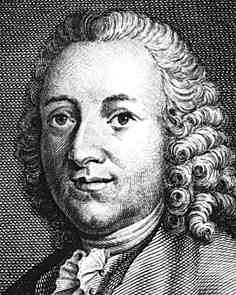 Frantisek Tuma Source: Expedition Audio |
|
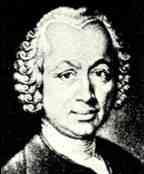 Franz Benda Source: Radio Swiss Classic |
Baptized 22 Nov 1709 in Benátky nad Jizerou, Bohemia, Czech violinist
Franz Benda
was elder brother to musicians, Johann Georg Benda,
Georg (Jiří) Antonín Benda
and
Joseph Benda, sons of the weaver, Jan Jiri Benda [1,
2,
3].
His sister, Anna Franziska, was an operatic soprano. Benda was a chorister as a child in Prague and Dresden. Upon
starting to play violin he joined a group of strolling musicians until 1730,
going to Vienna to study under
Carl Graun. In 1732
he entered into the service of
Frederick II
[Wikipedia]
with whom he remained until Benda's own death in 1786. The 'New
International Encyclopedia' of 1905 states that Benda performed some 50,000
"concertos" during a forty year period with Frederick. That's above 1,200 a
year, 100 per month, three per day, thus dubitable. Benda was, nevertheless,
retained by
Frederick because he was
among the finest violinists in Europe at the time. One finds Benda
reinforcing Bohemia's bid to the Baroque begun a generation earlier by
Jan Dismas Zelenka.
Czech music was emerging in Europe upon some delay due largely to war in the
Bohemian vicinity, having come to Habsburg Holy Roman Emperor Ferdinand III
taking a good portion of Prague's population to Vienna with him upon the
Peace of Westphalia [1,
2,
3,
4,
5,
6,
7,
8,
9] in 1648. All combined, Prague had lost two thirds of its population
to either sword or attrition as of the Thirty Years War [1,
2,
3,
4] and the region didn't rebuild in a day. When
Frederick II invaded Prague
in 1744, it was but a three-day siege only as destructive as needful, life
going on much as before. Frederick was a minimalist commander in that regard, his interests in
building rather than razing. He was among the better enemies to have even if
you were a Pole,
Frederick, a German, owning
a considerable bias and disgust concerning the unenlightened Polish. But the
gradual rebuilding of Prague brought with it inclusive rivalry with the rest
of Europe. As for Benda, he had composed largely duets, concertos, sonatas
and capriccios for violin as well as symphonies. He died on 7 March 1786,
Frederick following in
August. References: 1,
2,
3. Compositions: 1,
2. Scores: 1,
2.
Editions.
Audio: 1,
2.
Recordings of: discos: 1,
2,
3,
4;
'J.A. Benda | F. Benda' by Josef Suk (viola) & Ariane Pfister (violin) w the Suk & Prague Chamber Orchestras directed by Christian Benda
*. Other profiles: 1,
2.
L numbers below are per Douglas Lee, 1984. All concertos below are
performed by Ars Rediviva, conducted by that ensemble's founder, Milan
Munclinger. Franz Benda L 2:16 Ars Rediviva Ensemble/Prague Conducting: Milan Munclinger Flute: András Adjordán L 2:4 Ars Rediviva Ensemble/Prague Conducting: Milan Munclinger Flute: András Adjordán L 2:4 Slovak Chamber Orchestra Conducting/violin: Bohdan Warchal Flute: Eugenia Zukerman L 2:11 Savaria Baroque Orchestra Directior: Pál Németh Traverso: Vera Balogh L 1:1 Tříkrálový Koncert Orchestru |
|
|
This section concerning the history of Baroque music is suspended with Franz Benda. |
|
Early Blues 2: Vocal - Other Instruments
Modern Blues 2: Vocal - Other Instruments
Classical
Romantic: Composers born 1770 to 1840
Modern: Composers born 1900 to 1950
Country
Jazz
Early Jazz 1: Ragtime - Bands - Horn
Early Jazz 2: Ragtime - Other Instrumentation
Modern 4: Guitar - Other String
Modern 5: Percussion - Other Orchestration
Modern 7: Latin Jazz - Latin Recording
Modern 8: United States 1960 - 1970
Latin
Latin Recording 2: The Caribbean
Latin Recording 3: South America
Popular MusicRock & Roll
The Big Bang - Fifties American Rock
Total War - Sixties American Rock
Musician Indexes
Classical - Medieval to Renaissance
Classical - Classical - Baroque to Classical
Jazz Early - Ragtime - Swing Jazz
Jazz Modern - Song - Latin - Percussion - Other
Boogie Woogie - Doo Wop - R&B - Rock & Roll - Soul
Sixties American Rock - Popular
Latin Recording - EuropeLatin Recording - The Caribbean - South America
![]()
vfssmail (at) gmaill (dot) com